BUSINESS PLAN

St. Louis County, Missouri

County Executive Sam Page
PREPAREDBY:


 Division of Performance Management & Budget
Division of Performance Management & Budget




ST. LOUIS COUNTY, MISSOURI 2024 RECOMMENDED BUSINESS PLAN
September 29, 2023
The County’s financial position remains unchanged from the past several years. We have a mismatch between annual revenue and spending, and we continue to rely on fund balance and one-time revenue sources to close the gap. As you know, this cannot continue indefinitely. However, better than anticipated financial results from fiscal year 2022 along with additional one-time revenue from legal judgments and property sales provides us with additional time as we consider transformational decisions.
The collaborative budget workgroup meetings, town halls, and the participatory web-based budget simulation implemented earlier this year ushered in an unprecedented era of cooperation and transparency on budget matters. It became apparent through our discussions that no easy decisions lie ahead. Each of us places a different value on each service that the County provides. Our willingness to pay for the services provided by the County is inconsistent with our service expectations.
As we continue to work through these issues, I am proposing a budget for 2024 that maintains most programs and service levels while also considering new sources of revenue for the County. In 2024, I recommend restoring the property tax rate to the 2022 level. For homeowners, this represents an additional 3.9 cents (per $100 of assessed value) over the 2023 tax rate or $22 for the average home. We have the same inflationary pressures as other places, and we should respond in a like manner like other regional governments. I also recommend reallocating 1.4 cents of property tax levy from the Debt Service Fund to the General Revenue Fund. These actions will provide an additional $11.2 million of annual revenue for general funds operations. In addition, I suggest we continue collecting interest on the NFL settlement funds as we look at transformative ways to use these one-time funds for St. Louis County.
This proposed budget allows us to continue operating while we make long-term changes to find the appropriate balance between revenues and spending. With this context, I herein offer my proposed annual budget for the fiscal year beginning on January 1, 2024, for your approval. In accordance with Article VIII, Section 8.020 of the St. Louis County Charter, and applicable state statutes, I request appropriations totaling $1,025,568,521.

I. Budget Comparison
The County provides services through 24 separate funds as summarized in the table below. The General Revenue Fund is available for any service, whereas the other 25 funds receive revenues that are designated for specific functions. The recommended budget reflects a decrease of $21.6 million or 2.1% from the 2023 level as amended.
The best year-over-year comparison of the County’s budget is the operating budget. The 23 funds that make up the operating budget are the primary means by which most of the financing, acquisition, spending, and service delivery activities of the County are controlled. The recommended 2024 operating budget is $763.7 million – a decrease of $13.9 million or 1.8% from the 2023 adjusted level.
Table 1: Summary of Recommended Appropriations and Tax Rates
Highlights of the recommended 2024 budget include:

• $4.4 million for a pay program benefitting employees not included in a collective bargaining agreement. This provides up to a 4% pay increase beginning mid-year in 2024.
• $8.4 million for Police to fund pay increases required under collective bargaining agreements and vehicle purchases.
• $3.2 million for the Board of Elections to fund the County’s required contributions toward the cost of election dates in 2024.
• $1.7 million to outsource maintenance services within the Justice Center due to lack of available County staff.
• $1.1 million to fund 16 additional corrections officer positions in the Department of Justice Services to provide shift relief and offset overtime expenditures as the Department continues to implement recommendations of a recent operations review.
• $898,800 for the Department of Administration to improve the use of the County’s Enterprise Resource Planning system, the electronic backbone of the County’s financial, budget, procurement, and human resources functions.
• The exclusion of one-time appropriations for projects currently in progress:
o Jamestown Mall demolition ($6.0 million)
o Police facility construction ($23.8 million)
o On-call architecture and engineering project management services ($5.5 million)
o Poll Pad hardware/software ($2.6 million)
o Comprehensive Plan update ($1.0 million)
• A reduction of $718,000 for the ShotSpotter system.
• A reduction of 26 positions (4%) in the Department of Public Health.
• A decrease of $18.8 million or 22.3% for the Children’s Service Fund because the 2023 appropriation level was higher than normal to accommodate an overlap in grant funding cycles.
• A decrease of $973,785 or 14.7% for the Convention & Recreation Trust Fund due a reduction of $500,000 for the final preservation payment on the original Domed Stadium bonds and elimination of $500,000 in one-time funding for a track & field complex feasibility study. These decreases are offset by minor increases in debt service payments required for existing bond issues.
The recommended budget also includes more funding for transportation projects:
• $200.1 million for mass transit funds which reflect the estimated maximum amount of sales tax revenue that may be distributed to Bi-State Development for public transportation services. Actual distribution of these funds will be based upon the budget you adopt for Bi-State next summer. Appropriations are set at the maximum amount to comply with bond requirements.
• $62.8 million for transportation capital funds to support the five-year capital construction program of the Department of Transportation and Public Works. The 2024 recommended workplan will support $70.0 million of project activity, including $8.2 million of construction work in 2023 and prior year awarded construction projects.
The recommended budget does not include the following which require additional development and discussion:
• Appropriations from the NFL Settlement Fund or the Opioid Remediation Fund. These funds will continue to generate interest until comprehensive spending plans are developed.
• Funds to address the findings of the pay study to help us attract and retain talent.
• Funds for additional cybersecurity efforts.
• Funds related to Project Cornerstone.
II. Revenues
Revenues in all budgeted funds are projected to be $916.2 million in 2024, an increase of $25.0 million or 2.8% over the revised 2023 estimate. In the operating budget, revenues are projected to increase by $38.0 million or 6.0%.
Highlights of the revenue projection include:
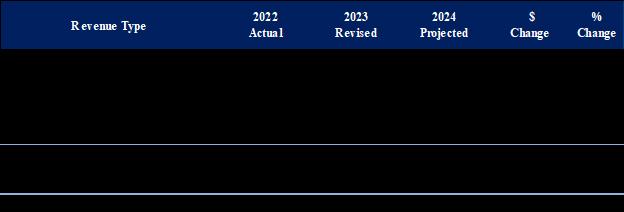
• $14.7 million or 2.3% growth in tax revenues, which account for 72.2% percent of all revenue collected, including:
o An increase of $7.2 million or 5.3% in property tax revenues due to the restoration of tax rates back to the 2022 level. This will provide additional revenue to support County operations and help offset the deficit in 2024.
o A shift of $4.0 million of property tax revenue between the Debt Service Fund and the General Revenue Fund.
o Slight growth in sales tax revenue (2.6%), including 2.0% growth in base revenue growth along with the annualization of the 3.0% tax on the sale of recreational marijuana that will begin to be collected in October 2023.
o A reduction of $5.1 million or 15.8% in utility gross receipts tax revenue due to one-time funds for a legal judgment received in 2023.
o A $10.3 million or 4.2% increase in all other revenue sources combined, which account for 28 percent of all revenue collected. This increase is due to the anticipated availability of federal funds to support transportation capital projects and the housing of federal prisoners in the Justice Center.
The revenue forecast does not include recommendations of the ongoing fee study which will not be complete until the end of 2023.
III. Financial Plan Challenges
Each fund in the recommended budget has a separately managed financial plan. Two of these funds continue to provide the most significant challenges – the General Revenue Fund and the Health Fund. In 2024, the General Revenue Fund is projected to have a structural deficit of $27.3 million (7.3%) and the Health Fund is projected to have a structural deficit of $12.0 million (17.5%). To preserve existing program and services levels, I propose to cover these deficits by restoring the property tax levy to the 2022 level, reallocating the existing property tax levy, making targeted reductions, and lowering our fund balances. The projected 2024 ending balances for these funds are $63.2 million (18.3%) in the General Revenue Fund and $29.8 million (52.5%) in the Health Fund – both above our fund balance policy of an ending balance equal to or greater than 10.0% of revenue.
As you can see from the deficits detailed above, the imbalance between the costs of providing government services to our residents and the amount of revenue provided continues to be a cause for concern. Soon, we will be forced to reduce service levels or seek additional revenue.
Sources of new revenue could include increasing the property tax rate further in even-numbered years, a ballot initiative to increase the property tax rate in any year, or revisiting the issue of a use tax to provide revenue for county operations and level the playing field for brick-and-mortar retailers in the County. Our reserves are a finite resource that cannot be used indefinitely to balance the budget.
I remain committed to working with you to address the challenges that lie ahead.
Respectfully submitted,
Sam Page
Attachment
cc: Kelli Dunaway, Lisa Clancy, Rita Days, Ernie Trakas, Mark Harder, Dennis Hancock
ST. LOUIS COUNTY EXECUTIVE SAM PAGE
CHIEF OF STAFF
CHIEF OPERATING OFFICER
CHIEF COMMUNICATIONS OFFICER
PROSECUTING ATTORNEY
ASSESSOR
St. Louis County Council
Rita Heard Days
Kelli Dunaway
Dennis Hancock
Shalonda D. Webb, Chair 4th District
Directors
Karen J. Aroesty Administration
Eric Fey Board of Elections (D)
Rick Stream Board of Elections (R)
Emily Koenig Children’s Service Fund
Diann L. Valenti County Council
Dana Redwing County Counselor
Rodney Crim Economic Development Partnership
Howard Hayes Human Services
Will Reise (acting) Information Technology
Hope Whitehead Judicial Administration
Circuit Court Judges
Thomas C. Albus
John N. Borbonus
Heather R. Cunningham
Jason D. Dodson
Margaret T. Donnelly
Bruce F. Hilton
Kristine A. Kerr
Associate Circuit Court Judges
Lorne J. Baker
Jason A. Denney
Ellen W. Dunne
Mondonna L. Ghasedi
Joseph L. Green
John R. Lasater
Virginia W. Lay
Ellen Sue Levy
Brian H. May
Doug Moore
Douglas Burris Justice Services
Courtney Whiteside Municipal Court
Brian Schaffer
Parks and Recreation
Jacob W. Trimble Planning
Col. Kenneth Gregory Police
Timothy M. Weaks Public Administrator
Dr. Kanika Cunningham Public Health
Ericka Savage (acting) Revenue
John D. Bales Spirit of St. Louis Airport
Stephanie Leon-Streeter, PE Transportation & Public Works
Ellen H. Ribaudo
Richard M. Stewart
David Lee Vincent, III
Dean P. Waldemer
Nancy Watkins McLaughlin
Jeffrey P. Medler
Mary Elizabeth Ott
Matthew H. Hearne
Robert M. Heggie
Megan Julian
Julia Pusateri Lasater
Amanda B. McNelley
Division of Performance Management & Budget
Paul Kreidler, PMB Director
Mary Hografe, Budget Manager
Dylan Lenzen, Performance Manager
James Washburn, County Data Officer
Stanley J. Wallach
Joseph L. Walsh, III
Nicole S. Zellweger
John F. Newsham
Krista S. Peyton
Natalie Warner
Lydia Boote, Performance Analyst
Rhett Nicks, Performance Analyst
Sunita Sankpal, Data Analyst
The Government Finance Officers Association of the United States and Canada (GFOA) presented a Distinguished Budget Presentation Award to St. Louis County, Missouri, for its annual budget for the fiscal year beginning January 1, 2023. To receive this award, a governmental unit must publish a budget document that meets program criteria as a policy document, as an operations guide, as a financial plan, and as a communications device.
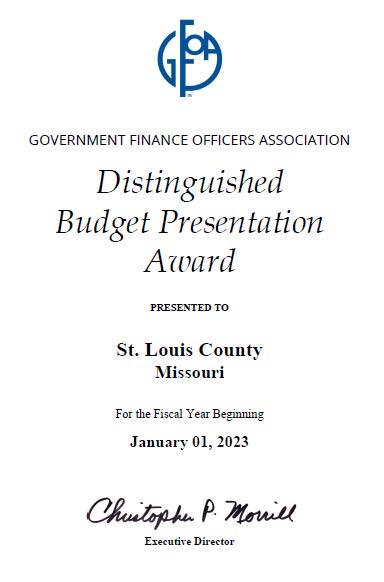
This award is valid for a period of one year only. The county believes that this budget and business plan continues to conform to program requirements and it will be submitted to GFOA to determine its eligibility for another award.

READER’S GUIDE
The St. Louis County Business Plan contains a narrative discussion of the county’s financial plan, revenue estimates and department budgets. Each department in the budget is described with narrative, as well as charts and graphs, and the budget is detailed by department, division, and fund.
Business Plan Organization
This business plan begins with an introduction to St. Louis County as well as information on financial policies and how the business plan is developed. This section also contains combined statements of revenues, expenditures and changes, and a long-term forecast for the General Revenue Fund.
An executive summary provides the reader with a synopsis of the business plan.
The revenue forecast provides information on 2023 and 2024 estimated revenues by fund. Property and sales taxes are highlighted in this section and a description of non-general funds is provided.
The narrative sections incorporate all funds appropriated to a department. Departments are organized into five program areas:
• Economic Development and Infrastructure
• Health and Well-Being
• Public Safety
• Recreation and Culture
• General Government
The remaining chapters are devoted to debt management, the Capital Improvement Program, grants, and supplemental information.
The Debt Management chapter summarizes the county’s credit rating, property tax levy, and bonded debt.
The Capital Improvement Program highlights capital projects that are funded in the 2024 budget, as well as those under consideration for funding through 2028.
The Grants chapter details the estimated grant funding received by county departments in 2023 and funding projected for 2024.
The final chapter, Supplemental Information, provides historical tax rate information, a fund dictionary, glossary, and description of acronyms.
Department/Office Narrative Organization
Each narrative within the business plan is structured in the same way. The narrative is a descriptive and visual representation of the department or office’s objectives. The following pages provide a description of each section in the narrative.



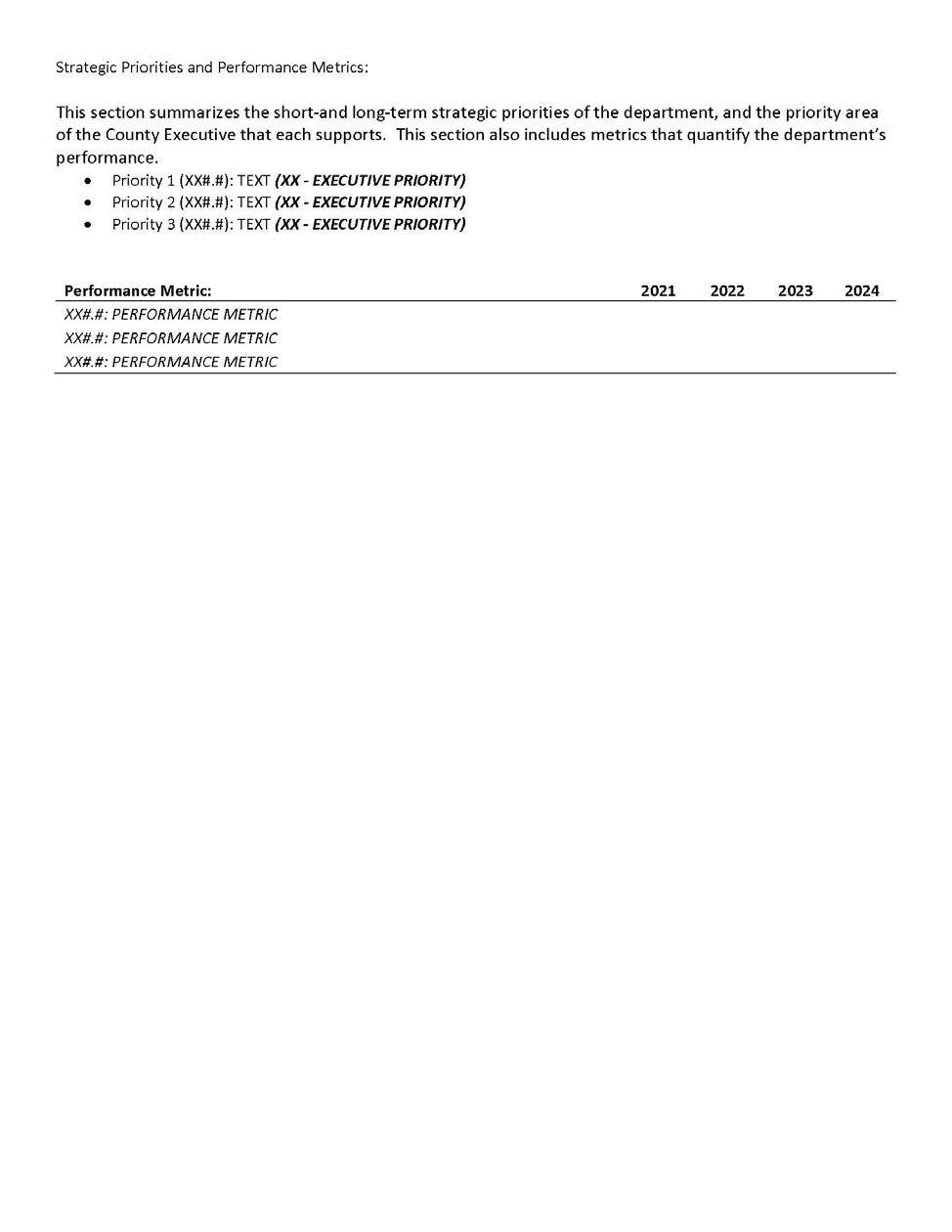



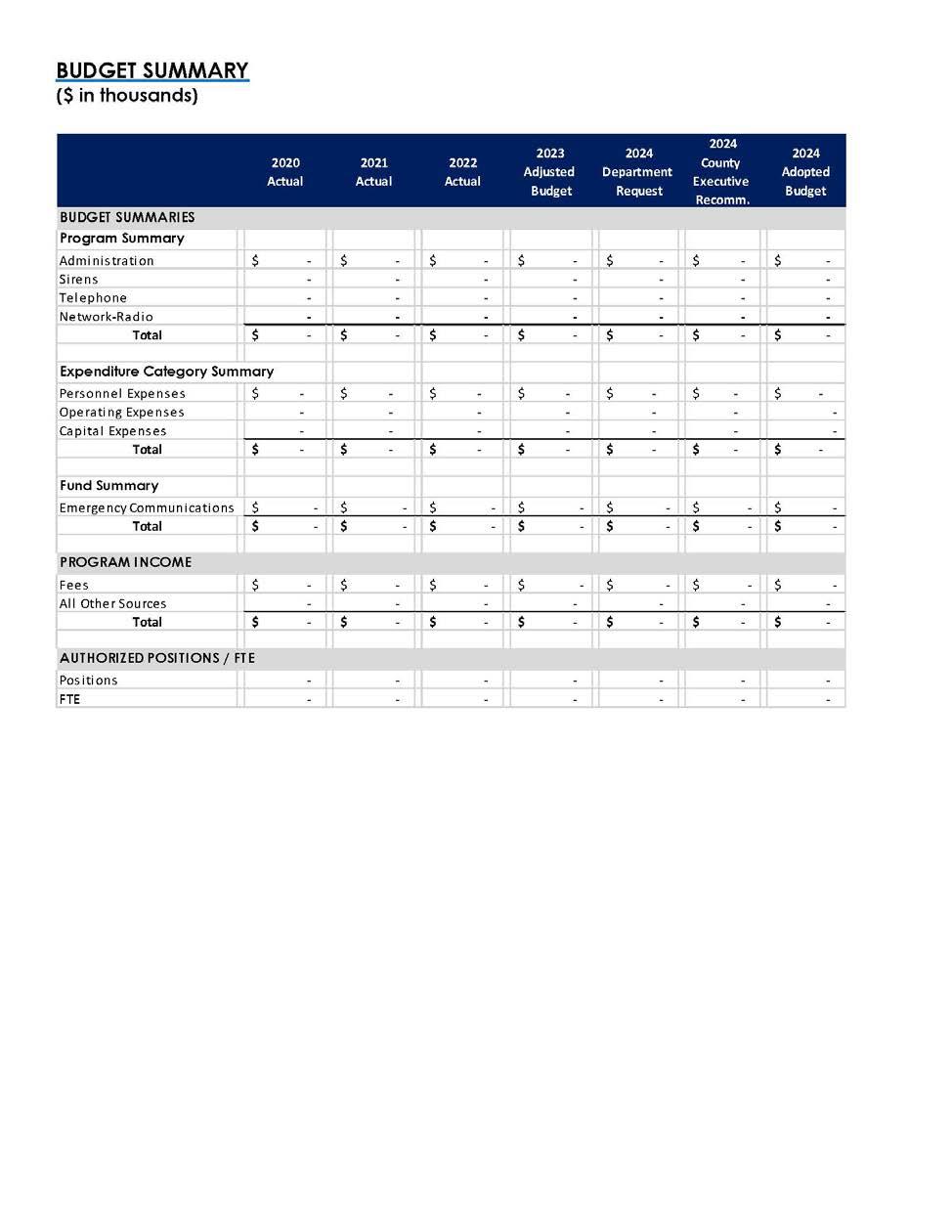
The final page of each narrative is a budget summary that is divided into three sections:
• Budget Summaries:
o Program Summary: expenditures and appropriations for the department divided into appropriated divisions and/or programs.
o Expenditure Category Summary: expenditures and appropriations for the entire department divided into personnel, operating, and capital categories.
o Fund Summary: expenditures and appropriations for the entire department divided by fund. Some departments receive appropriations from more than one fund.
• Program Income: revenue generated through department activities.
• Authorized Positions / FTE: summary of positions and full-time equivalents (FTEs) authorized for the department (all funds).
Data provided in this budget summary is organized by year:
• 2020 Actual: total expenditures and encumbrances incurred, revenue received, and total number of positions in the department/division/program during fiscal year 2020
• 2021 Actual: total expenditures and encumbrances incurred, revenue received, and total number of positions in the department/division/program during fiscal year 2021
• 2022 Actual: total expenditures and encumbrances incurred, revenue received, and total number of positions in the department/division/program during fiscal year 2022.
• 2023 Adjusted Budget: appropriations, revenue estimates, and positions as of August 2023 This considers transfers into and out of accounts, as well as any supplemental appropriations passed by the County Council.
• 2024 Department Request: 2024 appropriation and positions requested by the department and projected program revenue for consideration by the County Executive.
• 2024 County Executive Recommended: 2024 appropriation and positions recommended by the County Executive to the County Council along with projected program revenue.
• 2024 Council Adopted: 2024 appropriations and positions adopted by the County Council along with projected program revenue.
From Budget Book to Business Plan
In previous years, the Budget Office prepared a line-item budget, while analysts separately worked with departments to solidify goals and key performance indicators to measure impact. The creation of the Division of Performance Management and Budget in 2019 married the performance management aspect of county government administration with its financial management. The layout of the current Business Plan attempts to draw a clearer connection between the work that departments do, how those activities are funded, and how effective they are at serving the residents of St. Louis County. Additionally, staff worked with departments and offices across the county to reconsider their performance measures. As a result, many measures were dropped from the Business Plan as they were not being actively used by departments to measure efficiency or effectiveness. Many new measures were identified that stem directly from department priorities and are now included in the Business Plan. As such, you will notice that some of these new measures lack historical data if they were not previously tracked by departments.
2024 Priorities
In 2022 and 2023, many departments revised or replaced their priorities and performance measures Where possible, each department’s priorities and performance measures are captured under the division or program area responsible them. Additionally, there is a code next to each priority that ties them back to the County Executive’s Strategic Plan.
As shown in the table below, the County Executive’s strategic priorities fall into three broad categories under the umbrella of “A St. Louis County for Everyone:” health and safety for everyone, opportunity for everyone, and good government for everyone. The first, health and safety for everyone, will be achieved by addressing the opioid epidemic, reducing health disparities within our community, and reforming policing and the criminal justice system.
The second priority, opportunity for everyone, includes providing access to family-sustaining jobs, promoting inclusive community development, improving quality of life, and rebuilding pride and optimism in the county.
Finally, good government for everyone, focuses internally on county operations to transform the constituent experience, improve the effectiveness of county services, and ensure that those services are as efficient and responsible as possible.
County
Executive Strategic Priorities “A St. Louis County for Everyone”
Health and Safety for Everyone
Curb
Good
Ensure
ST. LOUIS COUNTY |2024 Recommended Budget Summary
*To improve comparison on a year-to -year basis, does not include funding committed in prior budgets
ST. LOUIS COUNTY |2024 Recommended Tax Rate Summary




INTRODUCTION
ST. LOUIS COUNTY PROFILE
St. Louis County was formed on October 1, 1812 (nine years before Missouri became a state) as one of the counties organized by Governor William Clark out of the five administrative districts of the Upper Louisiana Territory. As originally formed, St. Louis County included the area that is now St. Louis City, St. Louis County, Jefferson County, and Franklin County. In 1818, Franklin and Jefferson Counties were formed out of the original St. Louis County. In 1876, St. Louis City separated from St. Louis County, leaving the county at its present size of 524 square miles. In 1877, the City of Clayton was selected as the county seat.

With a population of 1,001,982, St. Louis County is the largest county in Missouri containing 16 percent of the state’s population. St. Louis County is the 46th largest county in the United States. St. Louis County is also an important employment center with nearly half of the metropolitan area’s jobs and one quarter of all jobs in Missouri.
Demographics
The county’s 1 million residents live in 88 municipalities and unincorporated areas. The county is comprised of seven Council Districts and has 641,399 registered voters.
Government
Voters select the County Executive and a seven-person County Council to govern the county and work to provide high quality services to businesses and visitors. The Prosecuting Attorney and Assessor are also elected. Elected officials serve four-year terms.
Infrastructure
The county maintains the Spirit of St. Louis Airport, approximately 3,169 lane miles of roadway, 680 traffic signals, and 220 vehicle and pedestrian bridges. Visitors and residents alike enjoy 68 county parks, 166 miles of trails, 44 playgrounds, 65 athletic fields, and 7 recreation complexes
Economy
With a thriving business community and exceptional schools, St. Louis County provides a rich quality of life for its residents. In addition to its acclaimed cultural amenities, the county boasts the highest per capita personal income and educational attainment in Missouri and employs more people than any other county in the state.
St. Louis County’s 88 municipalities have primary responsibility within their jurisdictions for services such as public safety, planning and zoning, local street maintenance and building code enforcement. The unincorporated area, which contains nearly one-third of the county’s population and one-third of its area, comes under the direct jurisdiction of county government.
The county’s 24 school districts are independent governmental entities, as are the 25 fire protection districts, which share fire protection responsibilities with 19 municipal fire departments. Special service districts provide sewer, library, junior college, and cultural facilities within the county. Privately owned utilities provide electrical, natural gas, water, and telephone service.
The county operates as a first-class county of the State of Missouri governed by a charter, originally adopted in 1950. The elected County Executive serves as the chief administrative officer of the county. The legislative body is composed of a seven-member County Council. The county’s fiscal year begins on January 1st.

The county provides a wide range of services falling within three categories: 1) county-wide services, which are available on an equal basis to all residents of St. Louis County; 2) services to unincorporated areas; and 3) services to incorporated areas by contractual agreement. The county also owns and operates Spirit of St. Louis Airport as a self-supporting enterprise. Major services provided by the county include:
• Police protection
• Health care
• Environmental health
• Human services programs
• Public works
• Tax assessment
• Low-income assistance programs
• Judicial and justice services
• Parks and recreation
• Election administration
• Planning and zoning

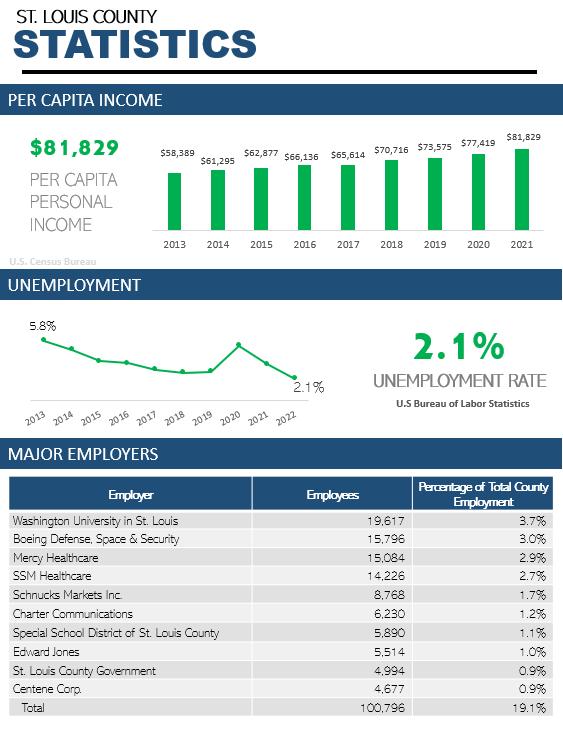

ST. LOUIS COUNTY GOVERNMENT: ORGANIZATIONAL CHART

ST. LOUIS COUNTY COUNCIL







 District 4 Shalonda D. Webb (D) Chair
District 1 Rita Heard Days (D)
District 2 Kelli Dunaway (D)
District 5 Lisa Clancy (D)
District 6 Ernie Trakas (R)
District 4 Shalonda D. Webb (D) Chair
District 1 Rita Heard Days (D)
District 2 Kelli Dunaway (D)
District 5 Lisa Clancy (D)
District 6 Ernie Trakas (R)
Budgetary and Financial Policies and Guidelines
The fiscal year of St. Louis County is the twelve (12) months beginning on the first day of January in each calendar year. Such fiscal year shall constitute the budget and accounting year (301.020 SLCRO 1974 as amended)
Charter Requirements
Pursuant to the St. Louis County Charter, Article VIII, the County Executive must submit a balanced current expense budget to the County Council no later than 90 days prior to the beginning of each fiscal year. The budget must include a complete financial plan for all county funds and activities, including proposed tax rates, an estimate of all income and revenue and all proposed expenditures for current operations, debt service and a capital program.
The annual budget document does not include all funds reported in the audited financial statement. Grant funds, capital projects funds (except the Transportation Highway Fund), trust and agency funds or special revenue funds that have been authorized by ordinance by the County Council as available and appropriated as received are not included in the budget document. The fiscal year for these funds is not necessarily the calendar year, nor do the appropriations lapse at the end of each year
The budget document must include, by fund: (a) the estimated income and revenue of the fund for the budget year and (b) the estimated income and revenue of the fund during the fiscal year immediately preceding the budget year. The total expenditure proposed in the budget for each fund shall be no greater than the lesser of (a) and (b), plus any unencumbered cash balance in the fund at the end of the fiscal year immediately preceding the budget year. The County Executive may propose additional expenditures if he also proposes additional income and revenue, but such additional expenditures may not exceed
ninety percent of the estimated additional income and revenue to be received from taxes plus the total estimated additional income and revenue to be received from any other source.
Prior to adoption of the budget, the County Council holds at least one public hearing where interested citizens can comment on and ask questions regarding the proposed budget. The proposed budget is available for public inspection on the county’s web site (stlouiscountymo.gov) and at the Division of Performance Management and Budget (PMB) offices once it has been presented to the County Council. The final budget is typically adopted by county ordinance before December 31st. If the council fails to adopt the budget by that date, the amounts appropriated for the current fiscal year shall be appropriated for the new fiscal year on a month-to-month basis, until the council adopts a budget.
The County Executive and/or the County Council may propose supplemental or emergency appropriations during the year which are approved via ordinance. The County Executive may request County Council approval to transfer appropriations within the same fund and department during the fiscal year.
Every appropriation, except an appropriation from general obligation bonds of the county, shall lapse at the close of the fiscal year to the extent that it has not been expended or encumbered. Any cash surplus in any fund at the end of any fiscal year shall be carried forward and merged with the income of the fund for the succeeding year.
Budget Transfers and Amendments
The budget is a living document which is frequently adjusted to meet the changing demand for services during the fiscal year. Accordingly, budget transfers and amendments are part of a larger on-going budget monitoring process. Funding issues are addressed as they arise via budget transfers and amendments
pursuant to Section 8.050 of the County Charter which states:
Section 8.050. The council may by ordinance during any fiscal year make supplemental or emergency appropriations from available income and reduce or transfer appropriations. The county executive may request transfer of appropriations within any department during any fiscal year. These transfers must be approved by the council. The council shall, by ordinance, establish procedures to efficiently manage budget transfers and council approvals.
Budget transfers allow for an increase or decrease in any appropriation within the same fund and department, provided that total appropriations remain unchanged. Budget transfers are initiated by county departments and are reviewed and approved by the director of the requesting department and the Budget Director (as the County Executive’s designee). The transfer request is then submitted to the County Council for final approval.
Budget amendments allow for any change to appropriations that cannot be accomplished through a budget transfer. These situations include increasing or decreasing the total amount of appropriations and transferring appropriations between departments.
Typically, budget amendments appropriate revenues from a source not anticipated in the budget and received for a specific purpose. The process for obtaining a budget amendment begins with a department director requesting, through a formal letter, that the County Executive pursue legislation to implement the proposal. If the County Executive supports the request, he formally requests legislation from the County Council who considers the specific request through the legislative process. A budget amendment may also be initiated by the County Council itself. If the council approves the amendment in the form of an ordinance, and that ordinance is signed by the County
Executive, the appropriation changes are made to the proper budgets.
Emergency Fund
As required by Missouri law, St. Louis County’s annual budget shall include an appropriation in an amount not less than three percent of the total estimated general fund revenues in an emergency fund (RSMo 50.540). The County Council may, by resolution at any time upon recommendation of the County Executive, make transfers from the emergency fund appropriation account to any other appropriation account within the General Revenue Fund (302.070 SLCRO 1974 as amended). Transfers from the Emergency Fund may only be made for unforeseen expenses upon approval of the County Council.
Budget Guidelines
The St. Louis County annual budget process is a collaborative effort involving all county departments, PMB, and the County Executive. PMB serves as the link between departments and the County Executive.
Departmental involvement starts early in the process with the development of revenue estimates. Departmental estimates are then combined with PMB’s general revenue estimates. These estimates are added to fund balance estimates to determine the amount of funding available for appropriation. These numbers are monitored and updated throughout the budget process.
Budget guidelines are developed taking County Executive goals and objectives and available funding into consideration. Guidelines that include information for departments on the expected format of their budget requests and standardized costs are then prepared.
All budget requests are returned to PMB where they are reviewed for completeness and adherence to guidelines are then summarized by fund and compared to available funding.
FY24 BUSINESS PLAN DEVELOPMENT CALENDAR
Funds Included
(all dates 2023)
MARCH
1 Munis open for 2024 budget development (Projection #22401)
APRIL 26 Fiscal Manager Meeting
28 All position updates/corrections complete
MAY 12 2023-2028 revenue estimates due
15 Salary and Benefit Projection created (Run #124)
31 Department review/update to business plan narrative (mission, core business functions, program descriptions, org charts) complete
JUNE
1 Budget Kickoff Video released (via LinkedIn Learning)
23 Small department budgets (see table below) due in Munis and supporting documents (including Capital Improvement Program (CIP) and grants list) submitted to PMB.
30 Budget Level 1 (department request) closed
JULY
7 Budget Level 2 (department director) closed
Large department budgets (see table below) due in Munis and supporting documents (including CIP and grants list) submitted to PMB
10-21 Small department budget meetings
AUGUST
7-18 Large department budget meetings
SEPTEMBER
8 Deadline for final budget decisions
29 County Executive’s Recommended Business Plan submitted to County Council
OCTOBER-NOVEMBER
TBD Council Budget Oversight Committee Hearings
TBD Council Budget Public Hearing
DECEMBER
TBD Council adopts budget
The budget process has been developed to give PMB information regarding a department’s needs, desires, and priorities so that a recommended county budget can be developed that falls within the available funding parameters and the goals and objectives determined by the County Executive. Often this is accomplished by requesting multiple budget scenarios and proper documentation from departments.
Once approved by the County Executive, a recommended budget is submitted to the County Council for their approval. Prior to voting on the recommended budget, the County Council holds a hearing to receive any comments regarding the budget from the public. The council also meets as a Committee of the Whole to hold hearings with all county departments.
The legal level of control at which actual expenditures may not exceed the budget is at the department level within the general funds and at the fund level for all other budgeted fund types.
Financial Policies
The accounting policies of the county conform to Generally Accepted Accounting Principles in the United States of America (GAAP) applicable to governmental entities. The following is a summary of significant accounting policies:
Financial Structure
The county’s financial structure is organized based on funds, each of which is considered a separate accounting entity with self-balancing accounts that comprise its assets, liabilities, fund balances/net assets, revenues and expenditures, or expenses. Governmental resources are allocated to and accounted for in individual funds based upon the purposes for which they are to be spent and how spending activities are controlled.
The following fund types are used by the county:
Governmental Fund Types
Governmental funds are those through which most governmental functions are financed. The acquisition uses and balances of the county's expendable financial resources and the related liabilities (except those accounted for in proprietary funds) are accounted for through governmental funds. The measurement focus is on determination of and changes in financial position rather than upon net income. The following are the county's budgeted governmental funds:
o General Funds - The general funds are the general operating funds of the county. They are used to account for all financial resources except those required to be accounted for in another fund. The general funds include five unique funds: General Revenue Fund, Special Road & Bridge Fund, Health Fund, Park Maintenance Fund, and the NFL Settlement Fund.
o Special Revenue Funds – Special revenue funds are used to account for specific revenues that are legally restricted to expenditures for specific purposes.
o Debt Service Fund - The Debt Service Fund is used to account for the accumulation of resources for, and the payment of, long-term debt principal, interest, and related costs.
o Capital Improvement Program Funds –Used to account for revenues and expenses of capital construction programs.
o Proprietary Fund Types
Proprietary funds are used to account for activities that are like those found in the private sector. The measurement focus is on the determination of net income, changes in net assets (or cost
recovery), financial position, and cash flows.
The county applies all applicable Governmental Accounting Standards Board (GASB) pronouncements as well as the following private-sector pronouncements issued on or before November 30, 1989, unless these pronouncements conflict with or contradict GASB pronouncements: Financial Accounting Standards Board (FASB) Statements and Interpretations, Accounting Principles Board (APB) Opinions, and Accounting Research Bulletins (ARBs) of the Committee on Accounting Procedure.
Measurement Focus and Basis of Accounting and Budgeting Measurement focus refers to when revenues and expenditures or expenses are recognized in the accounts and reported in the basic financial statements. Basis of accounting relates to the timing of the measurements made, regardless of the measurement focus applied.
Governmental fund financial statements are reported using the current financial resources measurement focus and the modified accrual basis of accounting.
Under the modified accrual basis of accounting, revenues are recorded when both measurable and available. The term "available" is defined as collectible within the current period or soon enough thereafter to be used to pay the liabilities of the current period. For the county, “available” is defined as expected to be received within sixty days of fiscal year-end. Expenditures generally are recorded when a liability is incurred, as under accrual accounting. However, debt service expenditures, as well as expenditures related to compensated absences and claims and judgments, are recorded only when payment is due (i.e., matured).
The county recognizes assets from derived tax revenue transactions (such as sales and utilities
gross receipt taxes) in the period when the underlying exchange transaction on which the tax is imposed occurs or when the assets are received, whichever occurs first. Revenues are recognized, net of estimated refunds and estimated uncollectible amounts, in the same period that the assets are recognized, provided that the underlying exchange transaction has occurred. Resources received in advance are reported as deferred revenues until the period of the exchange.
The county recognizes assets from imposed nonexchange revenue transactions (such as real estate and personal property taxes) in the period when an enforceable legal claim to the assets arises or when the resources are received, whichever occurs first. Revenues are recognized in the period when the resources are required to be used or the first period that use is permitted. The county recognizes revenues from property taxes, net of estimated refunds and estimated uncollectible amounts, in the period for which the taxes are levied. Imposed nonexchange revenues also include permits and court fines and forfeitures.
Intergovernmental revenues, representing grants and assistance received from other governmental units, are generally recognized as revenues in the period when all eligibility requirements, as defined by GASB 33, have been met. Any resources received before eligibility requirements are met are reported as deferred revenues.
Charges for services in the governmental funds are exchange transactions and are therefore not subject to the provisions of GASB 33. They are recognized as revenues when received in cash because they are generally not measurable until received.
Proprietary funds distinguish operating revenues and expenses from non-operating items. Operating revenues and expenses generally result from providing services and producing and delivering goods in connection
with a proprietary fund's principal ongoing operations. Transactions which are capital, financing, or investing related are reported as non-operating revenues. Interest expense, financing costs, and miscellaneous expenses are reported as non-operating expenses.
The budget is prepared in conjunction with the modified accrual accounting policies practiced by St. Louis County.
Encumbrances
Within the governmental funds, fund balance is reserved for outstanding encumbrances, which serves as authorization for expenditures in the subsequent year. Encumbrances will remain in force and will be liquidated under the current year’s budget.
Cash and Investments
The County Treasurer maintains a cash and investment pool that is available for use by all funds, except certain restricted Special Revenue and Agency Funds. Investment income earned on pooled cash and investments is distributed to the appropriate funds based on the average daily balance of the cash and investments of each fund. In addition, cash and investments are separately maintained by other county
officials, several of the county's departments, and third-party trustees and fiscal agents.
Property Taxes
Property taxes are levied annually in October based on the assessed valuation of all real and personal property located in the county as of the previous January 1. The current county tax rate is $0.418 per $100 of assessed valuation for residential real estate. Taxes are billed in November and are due and collectible on December 31. All unpaid taxes become delinquent on January 1 of the following year and attach as an enforceable lien on the property at that date.
Capital Assets
Capital assets include buildings, improvements, equipment, and infrastructure assets (e.g., roads, bridges, and similar items). Capital assets are defined by the county as assets with an estimated useful life greater than one year with an initial, individual cost of $5,000 or more; land improvements with a cost of $5,000 or more; infrastructure (other than roads or bridges) with a cost of $50,000 or more; roads, bridges, and improvements to roads and bridges with a cost of $500,000 or more; and all land.
St. Louis County, Missouri
Financial Organization Chart: 2024 Recommended Budget
































ST. LOUIS COUNTY 2024 BUDGET - FUND ANALYSIS
Notes To 2024 Budget – Fund Analysis
• The 2022 Ending Fund Balance: Budget Basis is generally lower than the fund balance reported in the 2022 Annual Comprehensive Financial Report (ACFR) because it is reduced by existing encumbrance balances and amounts reserved for potential payout of sick and vacation time for future retirees.
• The calculations of the 2023 Estimated Fund Balance Ending can be found in Table I (Summary Tables Chapter)
• The 2024 Estimated Revenue & Transfers may be different than the amount of estimated income used to calculate the dollars available for appropriation (see the Table I calculation for each fund). Per the County Charter, the amount of income available for appropriation is the lesser of the current year's estimate (2023) or the budgeted year's estimate (2024). This generally has the effect of reducing the amount available to appropriate and therefore the final approved budget.
• The Estimated Fund Balance Ending 2024 does not reflect an estimate of appropriations that remain unspent at the end of the fiscal year. While this varies by fund, the average lapse or “return” for all general funds averaged 9.9% over the past five years.
ST. LOUIS COUNTY, MISSOURI COMBINED STATEMENT OF REVENUES, EXPENDITURES, AND CHANGES IN FUND BALANCE 2022 ACTUAL ($ in thousands)
^Beginning/Ending Balance reflects the budget basis, which is generally lower than the fund balance reported in the Annual Co mprehensive Financial Report (ACFR) because it is reduced by existing encumbrance balances and other adjustments.
*Adjustments reflect changes in encumbrances, compensated absence balances, restricted funds, and other misc. adjustments.
ST. LOUIS COUNTY, MISSOURI COMBINED STATEMENT OF REVENUES, EXPENDITURES, AND CHANGES IN FUND BALANCE 2023 ESTIMATED ($ in thousands)
*Transfers In for General Funds include ARPA revenue loss allocations and reimbursements from bond proceeds. Transfers in for Special Revenue Funds include allocations from the Insurance Administration Fund and reimbursements from bond proceeds.
Capital Funds are adjusted for projects budgeted prior to 2022.
*Reserve for
ST. LOUIS COUNTY, MISSOURI
COMBINED STATEMENT OF REVENUES, EXPENDITURES, AND CHANGES IN FUND BALANCE 2024 RECOMMENDED BUDGET ($ in thousands)
2023-2028 LONG-TERM FORECAST – GENERAL REVENUE FUND (1010)
Purpose
The purpose of the long-term forecast is to provide a forward-looking view of the General Revenue Fund, allowing for evaluation of the long-term sustainability of the annual budget. The forecast also provides a starting point for future budgetary decision-making by identifying the balance between potential spending needs and projected revenues.
This long-range forecast is an important financial planning tool that is updated throughout the year as new information about revenues and spending becomes available. This information is used to:
• Incorporate necessary budget adjustments into long-range financial projections
• Ensure that both additions and reductions to the budget are sustainable
• Maintain options to deal with unexpected contingencies
• Continue advance planning to anticipate factors affecting revenues and service needs
There are many factors that can impact this forecast, including changes in the real estate market, changes in economic conditions, changes in the costs of goods and services, and unforeseen events such as natural disasters to name a few. Therefore, it is important that this projection be viewed only as an estimate of what the future could look like given what is known today
Assumptions
Revenue is estimated to increase by 4.8% in 2023 driven by increases in investment earnings, property tax, sales tax (including the new sales tax on recreation marijuana), and one-time revenues from legal judgments and the sale of real estate. In 2024 revenues are projected to grow by 2.3% due to restoration of the property tax rate to the 2022 level, the transfer of property tax levy from the Debt Service Fund, and annualization of the new marijuana sales tax.
General Revenue Fund (1010)
Note: the increase in the Ending Balance in 2021 and 2022 is due to the transfer-in of federal CARES-CRF and ARPA-SLFRF COVID relief funds

Revenues are projected to increase by an average of 1.0% from 2025 through 2028. This forecast is based on the following assumptions:
• Property values will grow, but the county’s revenue will be limited in reassessment years to the prior year’s revenue plus an inflationary adjustment. Any tax rate reductions in reassessment (odd-numbered) years will not be restored in the subsequent (even-numbered) year
• Sales tax revenues will grow by 2% per year
• All other sources fluctuate minimally each year.
• No allocations of the NFL Settlement Fund are included.
Expenditures are projected to increase 16.4% in 2023 and decrease by 5.0% in 2024. A portion of this fluctuation is due to $29.8 million in one-time spending in 2023 on police capital facilities and the demolition of Jamestown Mall Between 2025 and 2028, spending is estimated to increase an average of 3.5% per year based on the following assumptions:
• Public safety salaries will increase pursuant to collective bargaining agreements, and the budget will include a merit pay program for
other employees each year. The number of funded positions remains unchanged from 2025-2028. This forecast does not include the potential cost of addressing or correcting pay issues such as comparison to the market rate, compression, etc.
• Fringe benefit costs increase 4.0% per year to allow for growth in employee retirement and health care costs. This forecast does not include additional retiree cost of living adjustments
• Costs for purchased services, commodities and supplies, and capital outlays are projected to increase slightly each year (1%)
• Projections for the transfer payments category fluctuate to accommodate the number of elections budgeted in each year.
Fund Balance / Reserve
The budget is projected to be in a structural deficit position each year moving forward. This will draw fund balance down below the 10% reserve policy in 2025 and the budget will no longer be sustainable without significant changes in 2026.




EXECUTIVE SUMMARY
REVENUES: WHERE THE MONEY COMES FROM
See the Revenue Forecast chapter of this document for detailed information on revenues
Total revenue in all budgeted funds is projected to be $916.2 million in 2024, an increase of $25.0 million or 2.8% from the 2023 revised estimate of $891.2 million. Revenue from taxes (property, sales, utility gross receipts, casino, emergency telephone, and hotel/motel) account for 72.2% of the total. The remaining 27.8% is composed of revenue generated through program activities, intergovernmental (state/federal) revenue, and other sources. Over half (55.7%) of all revenues collected are received in the general funds, and nearly one-fifth (20.3%) are dedicated for public transportation purposes. The remaining revenues are received in special revenue, enterprise, debt service, and transportation capital construction funds.
2024 PROJECTED REVENUES BY CATEGORY






Highlights of the 2024 revenue projection include:
• An increase of $7.2 million or 5.3% in property tax revenues due to the restoration of tax rates to the 2022 level. This will provide additional revenue to support County operations and help offset the projected General Revenue Fund deficit in 2024.
• Transfer of 1.4 cents of property tax levy from the Debt Service Fund to the General Revenue Fund ($4.0 million annual revenue impact).
• Sales tax revenues increase by $11.9 million or 2.6% due to projected 2% base growth and annualization of the 3.0% sales tax on the sale of recreational marijuana that will be collected starting in the 4th quarter of 2023.
• Elimination of $8.0 million of one-time revenues received in 2023 related to a utility gross receipts tax legal judgment ($4.5 million) and the sale of real estate ($3.5 million).
Total Revenue by Category ($ in millions)

The county’s largest sources of revenue are sales tax and property tax. The county’s ten sales taxes produce 51.0% of all projected revenue in the budget while property tax produces another 15.6%.
Sales tax revenues are estimated to increase by $9.6 million or 2.2% in 2023 and another $11.9 million or 2.6% in 2024. Estimates include 2% base revenue growth along with the implementation of the “Prop M” 3% tax on the sale of recreational marijuana ($0.8 million in 2023 and $3.0 million in 2024). These revenues are closely monitored, and estimates are adjusted throughout the year as new data becomes available.
2024 Projected Sales Tax Revenue ($ in millions)
The 2024 proposed property tax rate restores rates back to the 2022 level at 41.8 cents per $100 of assessed valuation for residential real estate. In addition, 1.4 cents of the tax rate are recommended to be transferred from the Debt Service Fund to the General Revenue Fund

Property tax revenue is projected to increase by $7.2 million or 5.3% in 2024.



Although taxpayers submit their entire property tax bill to the St. Louis County Collector of Revenue, the county distributes most of this money to other taxing districts, including school districts, municipalities, fire districts, etc. In 2022, property taxes supporting county operations and debt service were responsible for 4.6% of the average taxpayer’s bill.


APPROPRIATIONS: WHERE THE MONEY GOES
The 2024 recommended budget for all funds is $1,025,568,521, a decrease of $21,593,583 or 2.1% 1 . This budget supports all operating departments of the county, highway capital projects, the Spirit of St. Louis Airport, debt service obligations, and distributions to Bi-State/Metro for public transportation but does not include grant funds or trust and agency funds which are appropriated by the County Council when received.
The budget is organized within funds, each of which functions as a separate “checkbook” with various legal and operational requirements. The 2024 recommended budget includes appropriations from 24 funds, with 57.9% coming from the general funds which are the main operating funds of county government.
The “operating budget” (see table above) is the primary means by which most of the financing, acquisition, spending, and service delivery activities of the county are controlled. The recommended operating budget is $763,740,340, a decrease of $13,883,146 or 1.8% The largest area of spending is Public Safety (38.1%) while the largest type of expenditure is salary and fringe benefits (55.9%) (see charts, below).
The budget for each department/office is discussed below. The budget maintains existing programs and service levels, however there are several changes that impact most departments and offices:
• An increase of $4.4 million will provide for employee pay increases in 2024 except for elected officials and employees covered by collective bargaining agreements (who receive increases per the terms of their agreement).
• A decrease of $758,052 due to updated costs for retirement, medical insurance, worker’s compensation, and unemployment compensation.
• Elimination of $24.3 million of “turnover and hiring lag” appropriation reductions made by the County Council during the 2023 budget process. The recommended budget fully funds each position for 12 months.
OPERATING
OPERATING
POSITIONS



















The budget funds 4,926 positions or 4,586.7 full-time equivalents (FTE), a decrease of 4 positions and an increase of 5.5 FTEs compared to the 2023 adjusted level. Economic
Health
BUDGET SUMMARIES
The following summaries provide an overview of the budget organized by functional area. These functional areas include Economic Development and Infrastructure, Health and Well-Being, Public Safety, Recreation and Culture, and General Government. More detailed information on each department’s budget, priorities, and performance measurements can be found within each department or office’s narrative later in this document.
Economic Development & Infrastructure
St. Louis Economic Development Partnership
The St. Louis Economic Development Partnership is the regional economic development organization which attracts, retains, and facilitates growth of businesses in St. Louis County and City. The Partnership works with economic development partners to help companies of all sizes thrive in the St. Louis region. The Partnership serves as the convener of strategic regional economic development initiatives.
The St. Louis Economic Development Partnership is responsible for the management of:
• Attracting, retaining, and growing businesses and jobs and increasing capital investment
• Advancing community investment, The St. Louis Promise Zone, and redevelopment of strategic real estate assets
• Supporting startups and the entrepreneurial communities and facilitating access to resources
• Accelerating growth of the region’s foreign-born populations through the Mosaic Project
• Increasing foreign trade and investment
• Facilitating major economic development projects
The 2024 recommended county investment in the partnership is $4,486,000 – no change from the 2023 level.
Department of Planning
The mission of the Department of Planning is to foster healthy communities by guiding development and reinvestment, developing long-range plans, promoting citizen engagement, and using data and information technology to guide public policy. Core business functions of the department include the management of:
• Administering the Zoning and Subdivision Ordinances
• Preparing community plans, small area studies, and other small geography planning documents
• Preparing the County’s Comprehensive Plan and guiding its implementation
• Monitoring annexations and municipal boundary changes throughout the County
• Processing petitions for changes in zoning and other special procedures as outlined in the Zoning Ordinance
• Site development plan and subdivision plat review
• Staffing of the Planning Commission and Board of Zoning Adjustment
• Subdivision and land disturbance escrow management
• Home day care licensing

• Outreach and planning in targeted communities
• Serves as the County’s liaison to the Boundary Commission
• Responding to citizen inquiries
The 2024 recommended budget for the Department of Planning is $1,053,879, a decrease of $916,582 or 46.5%. The budget decreases due to the elimination of a one-time appropriation of $1 million in the 2023 budget to update the county’s Comprehensive Plan.
Spirit of St. Louis Airport
The Spirit of St. Louis Airport provides a safe, efficient, dependable, and attractive firstclass public facility that professionally serves the users and tenants. The airport strives to maintain its role as a major air transportation facility for the St. Louis region while continuing to be a responsive and responsible neighbor to the surrounding community.
Spirit of St. Louis Airport is a Federal Aviation Administration (FAA) Air Carrier Certified Airport and is responsible for the management of:
• A self-supporting enterprise fund through the sale of jet fuel
• A 7,485-foot all-weather runway
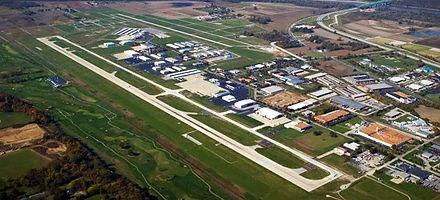
• A 5,000-foot parallel runway
• Precision Instrument Landing System (ILS) approaches
• FAA Control Tower
• 24-hour United States Customs Service
• 24-hour Airport Police Service
• 24-hour Aircraft Rescue Firefighting response service
The 2024 recommended budget for the Spirit of St. Louis Airport is $37,940,914, an increase of $1,892,794 or 5.3%. The budget includes $4.0 million to replace the West Terminal and $400,000 for safety management systems updates and design services for the north runway.
Department of Transportation & Public Works

The mission of the Department of Transportation and Public Works is to promote the health, safety and well-being of St. Louis County residents by providing a transportation system that supports multi-modes and encourages regional growth and opportunity; enforce internationally accepted building and property maintenance codes reasonably and judiciously for public health, safety and protection; provide customer friendly building spaces in which to conduct county business; and, support innovative problem solving that enhances public service.
The Department of Transportation & Public Works is responsible for the management of:

• Planning, design, construction, inspection, operation, and maintenance of 3,169 lanemiles of road
• 220 vehicle and pedestrian bridges
• 1000+ crossroad culverts
• 1,300 miles of sidewalks
• 47 miles of dedicated on-street bicycle lanes
• 13 miles of signed bicycle routes
• 680 signals and beacons
• 250,000 signs
• 35 owned buildings (2.9M gross ft2)
• 16 building leases (0.3M gross ft2)
• Review of 14,400 plan sets
• Issuance of 57,300 permits
• 139,400 construction inspections
• 18,400 re-occupancy inspections
• 8,400 property maintenance inspections
• Monitoring of over 1,200 vacant nuisance properties
• Mowing of 2,600 vacant lots
The 2024 recommended budget for the department is $113,978,424, a decrease of $1,674,418 or 1.4% (not including the Highway Capital Construction Program which is summarized at the end of this chapter). The budget includes a decrease of $5,540,000 for the one-time cost of a consultant contract for Project Cornerstone and an increase of $1,690,000 to outsource maintenance of the Justice Center. The budget also eliminates $1,821,490 of turnover and hiring lag appropriation reductions that were included in the 2023 budget.
• Capital and operating budget development and oversight
• Supply acquisition and safety training
• Maintenance of 3,557 vehicles, trucks, and engine-powered equipment
• Maintenance of 2 county-owned parking garages
• Fuel supply for county vehicles/equipment and municipal fleets by contract
• Contract management of water service line repairs on qualifying residential lines within St. Louis County
• Contract management of sewer lateral line repairs in unincorporated St. Louis County and within municipalities by contract.
• Construction management for department administered road and bridge projects
• Inspection for all Special Use Permits issued for work in the public right of way
Health & Well-Being
Children’s Service Fund
The Children’s Service Fund (CSF) works to improve the lives of children, youth, and families in St. Louis County by strategically investing in the creation and maintenance of an integrated system of care that delivers effective and quality mental health and substance use treatment services.
The Fund is responsible for:
• Strategic investments of sales tax revenue
• Ensuring accountability of sales tax revenue through programmatic and financial review of funded agencies
• Evaluating service gaps through community needs assessments, data analysis, and stakeholder engagement
• Developing strategic partnerships with other agencies
• Supporting non-profit agencies through capacity building and technical assistance
The 2024 recommended budget for the Children’s Service Fund is $65,226,406, a decrease of $18,772,434 or 22.3%. This decrease is due to a $20,000,000 reduction for core funding and special programs as approved by the CSF Board.
Department of Human Services
The Department of Human Services is committed to providing the support, services, and resources that help individuals of all ages live safely, productively, and independently.
The Department is responsible for the management of:
• Providing services for homeless and potentially homeless individuals and families
• Assisting county older residents with maintaining independent living and quality of life
• Providing information, referrals and case management services for veterans and their families
• Providing community-based intervention, case management, mental health and youth development services for at-risk children and youth
• Operating a 39-bed residential domestic violence shelter for abused women and their children
• A full spectrum of employment services for job seekers and employers funded by the Department of Labor (not included in this budget)
• Increasing Sustainable Economic and Housing Options for Marginalized Populations through federally funded programs (not included in this budget)
The 2024 recommended budget for the department is $4,702,831, an increase of $1,006,706 or 27.2%. The budget includes an increase of $101,877 for warming and cooling shelters, a reduction of $76,756 from grant reimbursements, and the elimination of $681,065 of turnover and hiring lag appropriation reductions that were included in the 2023 budget.
Public Administrator
The Office of the Public Administrator is established by state law to serve as guardian, conservator, personal representative, executor, and other necessary roles upon appointment by the Probate Court. The Public Administrator shall take into their charge and custody the estates of incapacitated and disabled individuals, the estates of deceased individuals, and the estates of minors, promoting the selfworth of each individual as well as preserving, protecting, and managing their assets. The office strives to install values of advocacy, dignity, empathy, and integrity into their everyday work while serving the most vulnerable citizens of the county.
The Office of Public Administrator is responsible for the management of:
• Guardianship of incapacitated and disabled individuals
• Conservatorship of the estate and assets of incapacitated and disabled individuals
• Conservatorship of the estate and assets of minors
• Administering the estates of deceased persons
• Collaborating with state and community-based resources to improve services
• Educating the community through personal interaction and community involvement
• Advocating and influencing public policy for the welfare of words and protectees
The 2024 recommended budget for the Office of the Public Administrator is $1,049,928, an increase of $49,025 or 4.9%. The budget includes an additional Deputy Public Administrator position to fulfill the office’s additional needs due to increased caseloads.
Department of Public Health
The Department of Public Health works to promote, protect, and improve the health and environment of the community. The department’s vision is that St. Louis County has healthy people, a healthy environment, and equitable communities. The department believes in:
• Being a public health leader in the community
• Providing equitable access to services and resources
• Being responsive to the changing needs of the community
• Operating in an ethical, transparent, and fiscally responsible manner
• Serving the community with dignity and respect.
The Department of Public Health is responsible for the management of:
• Assessing and monitoring the health status of the population and making information available to the public on communicable and chronic diseases, emerging epidemics, and the social and structural determinants of health
• Assessing health hazards and their root causes, and the environmental status of the community while making information available to the public on conditions that may contribute to health outcomes
• Preparing for emergencies that may affect the health of the public and participating in deploying a trained public health workforce in the event of any emergency, disaster, or epidemic
• Ensuring the effective enforcement of all codes, ordinances, and best practices related to protecting the health of the public
• Ensuring equitable availability of services, programs, and access to care necessary to the population based on their health needs either through the direct provision of services or through effective community linkages and partnerships
• Controlling or contracting the operation of all direct clinical services provided by the county including medical care, dental care, preventative care, mental and behavioral health, and treatment of infectious diseases
• Informing and educating the population and acting as a community resource on health-related topics
• Recommending to the governing entities from time to time such policies as will tend to preserve or promote the public health of the county
• Strengthening, supporting, and mobilizing community partnerships and cooperative relationships with neighboring jurisdictions, state and federal agencies, and local and national organizations for the promotion and protections of the public health of the population
The 2024 recommended budget for the Department of Public Health is $84,980,604, an increase of $4,178,956 or 5.2%. The budget eliminates 26 positions and $5,421,195 of turnover and hiring lag appropriation reductions that were included in the 2023 budget.
Public Safety
Emergency Communications Commission
The St. Louis County Emergency Communications Commission (ECC) provides a coordinated council of department leaders from public safety agencies and local government entities, with an emphasis on providing interoperable communications that allow firefighters, emergency management services, police, and other groups to better manage incidents by sharing vital information in a rapid fashion.
The Commission is responsible for the management of:
• Countywide interoperable radio communications
• Upgrading 911 communications in the county
• The Emergency Outdoor Warning Siren network
• Management and support of ESInet (emergency services internet protocol network) and MPLS (multiprotocol label switching) networks

The 2024 recommended budget for the commission is $19,167,556, a decrease of $466,440 or 2.4%. This decrease is driven by a reduction in the cost of maintaining telephone equipment.
Department of Judicial Administration
The Department of Judicial Administration serves the citizens of St. Louis County by providing access to a fair, impartial, prompt, and cost-effective system of justice that ensures that all are treated with courtesy and dignity, and that fosters the respect and confidence of the public in an independent judicial system. Funding, other than salaries and benefits for judges and Circuit Clerk personnel and costs of the Law Library, is provided by the County as mandated by state law.

The Department of Judicial Administration is responsible for the management of:
• Providing access to justice using jury and bench trials
• Alternative treatment courts to serve veterans, individuals with substance use disorders (including opioid addiction), mental health issues, alcohol-related driving offenses and domestic violence issues
• Substance Abusing Families Engaged in Treatment and Intervention (SAFETI) Court to provide close monitoring of parents with substance abuse problems who have children involved in the child welfare system
• Execution of court orders for attachment, replevin, levy under general execution, eviction, and garnishment of execution
• Execution of court orders to apprehend and transport alleged mentally ill, dangerous, and/or incompetent persons to and from mental health facilities and court for hearings
• Programs and services to protect children from abuse and neglect
• Programs and services for delinquent youth
• Prosecution of juvenile delinquency matters
• Safe and secure custody of juveniles within the Court’s Juvenile Detention Center
• Multi-lingual automated assistance and referrals for victims of domestic violence
• Free marriage ceremonies for all couples who come to the courthouse with a St. Louis County marriage license
• Expanded community partnerships to provide support, counseling, and alternatives to detention for court-involved youth
• The Exchange Center, which provides a safe, secure environment for the transfer and supervision of children in families with court-ordered visitation
• The Parent Education Program to help adults understand and cope with the impact of separation and divorce on their children
The 2024 recommended budget for the Department of Judicial Administration is $34,046,235, an increase of $612,450 or 1.8%. The recommended budget includes four new detention deputy juvenile officer positions due to increases in the detention population.
Department of Justice Services
The mission of the Department of Justice Services is to serve and protect the community by means of a trained and dedicated workforce, and utilizing best practices to provide supervision, rehabilitation, and opportunities in a safe, secure, and humane environment.
The department is responsible for:
• Serving and protecting the community
• Providing custody, supervision, and guidance to those persons who are mandated to county jurisdiction
• Maintaining the highest level of security ensuring the safety of the community, residents, and staff
• Providing a safe, healthy, and humane environment for detainees and staff
• Encouraging detainees to grow academically, physically, socially, and vocationally
• Providing educational, recreational, religious, and vocational programs
• Advancing staff supervision and leadership
• Supporting the return of detainees back into the community
• Performing human resources, fiscal management, accreditation standards, internal affairs, and programs for detainees and those released
• Processing of all arrested persons conveyed to the Intake Center including warrant data, records checks, fingerprinting, mug shots, classifications, and release authorizations
• Supervision of all resident transfers to courts, clinics, hospitals, and state prisons
The 2024 recommended budget for the Department of Justice Services is $37,422,661, an increase of $7,772,885 or 26.2%. The budget includes $1,898,312 to annualize 12 Corrections Officer positions added during 2023 and provide funding for 16 new Correction Officer positions in 2024. The budget also includes an additional $884,000 for the food service contract due to a jail higher population and new contract pricing, and the elimination of $3,259,991 of turnover and hiring lag appropriation reductions that were included in the 2023 budget.
Municipal Court
The Municipal Court seeks to resolve all municipal cases in an expedient, fair, and unbiased manner while upholding the integrity of the court as a court of law, the ordinances of the county, the laws of the state, and the Missouri and United States Constitutions. Part of the court’s mission is to provide impeccable customer service and maximize access to the court for all citizens of St. Louis County and all that have a need to conduct business with the court.
The Municipal Court is responsible for the management of:

• Providing a safe place for the peaceable resolution to a dispute


• Ensuring fair and unbiased justice is carried out in all cases
• Adjudicating cases between parties where the defendant is accused of violating a local county ordinance or that of a municipality contracted with the court for court services
• Maintaining a complete and accurate record of events in all cases
• Collection of lawfully assessed court fines and costs
The 2024 recommended budget for the Municipal Court is $1,946,841, an increase of $452,810 or 30.3%. The budget includes an increase of $21,900 for computer equipment, an increase of $61,982 for the county’s self-insurance program, and funds to annualize salary and position changes approved during 2023.
County Police Department
The mission of the St. Louis County Police Department is to work cooperatively with the public, and within the framework of the Constitution, to enforce the laws, preserve the peace, reduce fear, and provide a safe environment in our neighborhoods.

The department is responsible for the management of:
• Police protection through the patrol of communities and Metro Link Transit services
• Neighborhood police officers and school resource officers supporting the community
• Crisis Intervention Team (CIT) trained officers throughout the department to deescalate mental health crises
• Crisis negotiation team to respond to mental health barricaded subjects to deescalate without SWAT
• Community engagement through youth and diversity and inclusion programs
• Investigation of crimes within St. Louis County
• Crime Laboratory scientific support of criminal investigations
• Collect and disseminate criminal intelligence throughout the region via the St. Louis Fusion Center
• Air patrol though a cooperative agreement with the St. Louis Metropolitan Police and St. Charles County Sheriff Departments
• Emergency 911 calls received and dispatched by the Bureau of Communications
• Police recruit training and continuing education for current staff at the County and Municipal Police Academy
• Security services provided to all St. Louis County government buildings
• Response plans for countywide emergency situations with the Office of Emergency Management
The 2024 recommended budget for the department is $183,325,931, a decrease of $9,807,389 or 5.1%. The budget includes an increase of $6,366,255 to fund pay increases as required by existing collective bargaining agreements and $1,998,581 to replace high mileage vehicles. The budget eliminates $7,690,568 of turnover and hiring lag appropriation reductions that were included in the 2023 budget, $23,800,000 for one-time matching funds for capital facilities, and $718,000 for ShotSpotter.
Prosecuting Attorney
The Prosecuting Attorney represents the citizens of St. Louis County by fairly and effectively prosecuting violations of state criminal statutes, promoting public safety, empowering victims of crime, and building a safe community for everyone. The Prosecuting Attorney’s Office promotes public safety by protecting the community from those who commit violence, providing pathways to treatment for people with substance use and mental health challenges, and establishing trust with the communities it serves.
The Prosecuting Attorney is responsible for the management of:

• Warrant application process (to include review and charges)
• Criminal Case Management from inception to closure
• Traffic Case Management from inception to closure
• Alternative Court Management (Drug Court, DWI Court, Mental Health Court, Veteran’s Court)
• Diversion Program Management
• Victim Services Management
• Child Support Services
• Taxes and Bad Check Collection
• Community Engagement
• Grand Jury hearings and administration
• Conviction Incident Review Unit
• Operation of two satellite offices within local police departments
Wesley Bell St. Louis County Prosecuting Attorney
The 2024 recommended budget for the Prosecuting Attorney is $15,435,428, an increase of $602,377 or 4.1%. The budget includes a decrease of $695,163 for insurance costs, the elimination of $1,075,431 of turnover and hiring lag appropriation reductions that were included in the 2023 budget, and the addition of $90,000 to replace two high-mileage vehicles.
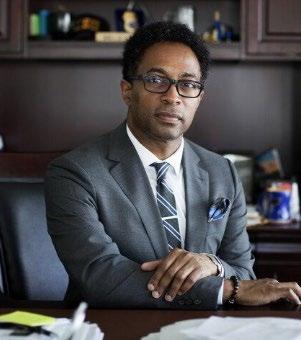
Recreation & Culture
(in thousands)
Department of Parks & Recreation
The Department of Parks and Recreation works to provide high quality parks, facilities, and recreation services that enhance residents’ lives through responsible and effective management of resources.
The department is responsible for the management of:

• 68 parks with 11,400 acres
• 7 recreation complexes
• 6 historical/cultural sites
• 166 miles of trails
• 65 athletic fields
• 44 playgrounds
• 78 picnic shelters
• 590 acres of lakes
• 87 restroom buildings
• More than 400 recreational programs annually

• Citizen Volunteer program
The 2024 recommended budget for the department is $39,192,993, an increase of $923,830 or 2.4%. Highlights of the budget request include $121,854 for ranger body cameras, $1,494,550 for vehicle and capital equipment replacement, $300,000 to renovate the Visitor Center at Jefferson Barracks, and $150,000 for the Greensfelder Recreation Complex for the Midwest Sport Hockey entrance and parking.
General Government
Department of Administration
The Department of Administration promotes the vision and values of St. Louis County government by facilitating the effective delivery of services and providing leadership and support to county departments while ensuring efficient use of resources for county residents.
The department provides administrative services to all St. Louis County offices and departments as well as the public. These services include the management of:
• Accounts payable / accounts receivable / payroll / capital assets inventory
• Publication of annual financial reports
• Budget development and management
• Bond issuance and compliance
• Debt management
• Performance improvement and tracking
• Procurement
• Minority and Women-Owned Business development and inclusion
• Prevailing Wage enforcement
• Risk management and insurance
• Employee safety
• Human resources
• Employee benefits
• Countywide training on bias, diversity, equity, and inclusion
• Fostering pro-equity policies
• Retirement plan administration
• County financial investments
• Sales tax administration
• Banking relationships
• Centralized cashiering
• Records retention
• Imaging services
• Mail and courier services
• Central receiving
• County’s integrated financial, procurement, and human resources system (CAPS)
• Information desk customer service
• 311 call center
The 2024 recommended budget for the department is $16,065,296, an increase of $1,193,061 or 8.0%. The budget includes nearly $900,000 for consulting services to improve the efficiency of the County’s Enterprise Resource Planning System. The budget was reduced by $200,000 to remove funding for
training initiatives funded in 2023 but not yet begun and $158,000 for 2 data analyst positions that were eliminated. Finally, the budget includes the elimination of $779,777 of turnover and hiring lag appropriation reductions that were included in the 2023 budget.
County Assessor
The County Assessor seeks to fairly and accurately assess all real and personal property in the county, in accordance with applicable law and professional appraisal practice, and to provide excellent customer service.
The County Assessor is responsible for the management of:
• The accurate and timely classification and valuation of all real property and all tangible personal property in St. Louis County

• The performance of all administrative functions of the two Boards of Equalization
• The review of all petitions for tax-exemptions of tangible personal property and real property, and submission of recommendations regarding the same to the Boards of Equalization
• The production and updating of official St. Louis County real estate information, including locator maps and maps containing parcel boundary lines
• The maintenance of current and accurate real estate title transfers and related plats, and certificates of value
• Timely, accurate, and customer-friendly public service by providing property values and reassessment information
The 2024 recommended budget for the County Assessor is $18,085,245, an increase of $689,560 or 4.0%. The budget includes a reduction of $278,000 for items such as postage, printing, public notices, automobile allowance, and office supplies due to 2024 being a non-reassessment year.
County Council
The St. Louis County Council seeks to provide the highest standard in transparency in government and enable greater access to government proceedings and records for all St. Louis County citizens. The council is the elected legislative body of the county and exercises all powers set forth in Article II of the


 Jake Zimmerman
St. Louis County Assessor
Jake Zimmerman
St. Louis County Assessor
St. Louis County Charter, as well as all other powers set out in laws related to county commissions not superseded by the charter. The council consists of seven council members representing seven geographic council districts.
The County Council is responsible for:
• Providing public records requested by county departments while conducting county business and as requested by the public
• Processing various petitions that are filed with the County Clerk for appropriate action as prescribed by law
• The scheduling and live streaming of the weekly Council meetings and Council committee meetings, and recording of meetings for viewing on the county website
• Producing and posting notice of all Council meetings and hearings as prescribed by law
• Processing Notary Public commissions for the State of Missouri
• Administering oaths of office to various board and commission appointees as well as county employees
• Conducting the internal audit function of county operations
• Monitoring the St. Louis County Fraud and Financial Concerns Hotline for anonymous reporting of fraud, waste, mismanagement, or misconduct by employees and residents
• Managing the repository of the permanent record of all ordinances, resolutions, orders, and Council agendas and journals and other records in compliance with the Records Retention Schedule
The 2024 recommended budget for the County Council is $2,946,777, an increase of $420,121 or 16.6%. The budget includes $35,000 to provide each district with $5,000 to send traditional mailings to residents, and an increase of $47,763 for external accounting firm fees. The budget also includes the elimination of $738,931 of turnover and hiring lag appropriation reductions that were included in the 2023 budget.
County Counselor
The Office of the County Counselor conducts the civil law business of the county, assisting county government in carrying out its policies and operations in an efficient and legally appropriate manner by providing advice, counsel, and representation to county departments, offices, boards, commissions, and employees, including elected and appointed officials.
The County Counselor is responsible for:
• Representing, in the name and on behalf of the county, all civil suits and other proceedings at law or in equity requisite or necessary to protect the rights and interests of the county and enforcing any and all rights, interests or claims against any and all persons, firms or corporations in whatever court or jurisdiction such action may be necessary.
• Prosecuting all proceedings for the collection of delinquent taxes and licenses of every kind owing to the county and violations of county ordinances relating to problem properties, domestic relations, and traffic.
• Preparing and/or approving as to form all leases, deeds, contracts, bonds, ordinances, rules, regulations, drafts of legislation, and other instruments
• Providing legal advice and opinions to the council, the County Executive, department heads, elected officials, and to all county boards and commissions, respecting county business.
The 2024 recommended for the County Counselor is $5,700,688, an increase of $74,432 or 1.3%.
County Executive
The County Executive is the Chief Executive Officer, elected by the voters of St. Louis County to a four-year term of office, with all executive powers, responsibilities, and duties enumerated within Article III of the St. Louis County Charter, which include directing, coordinating and monitoring the activities of all county administrative units under the County Executive’s control; appointing administrative heads of departments; approving and executing contracts and agreements for the county as authorized; directing the creation of the annual budget; maintaining communications with federal, state and local governments; and directing special projects requiring coordination among county departments.

The St. Louis County Executive is responsible for the management of:
• The proper and efficient administration of the county
• Appointing department directors and members of boards and commissions
• Employing experts and consultants in connection with any of the functions of the county
• Coordinating and supervising the work of the departments and agencies of the county to promote efficiency and economic growth
• Executing and enforcing the provisions of the County Charter, the laws of the State of Missouri pertaining to the government of the county, and the ordinances, resolutions, orders, and policies of the council and seeing that all contracts with the county are faithfully performed
• Attending regular meetings of the County Council and participating in discussions without vote
• Recommendations to the council to improve the county government and the general well-being of the people and submitting to the council an annual report of the affairs of the county
• Promoting and encouraging cooperative relationships between the county and the political subdivisions within the county in matters relating to land use planning, public health, sewers, parks, safety, public welfare, and all other governmental functions in which the people of St. Louis County could gain through better cooperative arrangements

• Examining any payroll, account, demand or claim against the county and having access to all county books, records and papers kept by county officers and employees
• Representing the county and performing other duties per the County Charter
• Establishing by executive order from time-to-time systems of administrative organization in the departments
• Submitting to the council for approval by ordinance an annual balanced budget
• Transforming County Government by improving constituent experience through increasing channels, access to data, and backend process that answer constituent questions
• Redesigning shared services structure and operating model to drive efficiency and effectiveness throughout county government
• Developing modern workspaces and optimize use of real estate
• Increasing constituent services by optimizing the Community Outreach team to increase access to information, provide feedback and improve communications
Dr. Sam Page St. Louis County ExecutiveThe 2024 recommended budget for the office is $6,979,510, an increase of $628,099 or 9.9%. The budget continues the consolidation of department non-merit appointees’ costs, as required by a 2023 amendment to the Charter, such as subscriptions, cell phones, software, travel, and memberships. The budget also includes the elimination of $429,548 in turnover and hiring lag appropriation reductions that were included in the 2023 budget.
Board of Elections
The St. Louis County Board of Election Commissioners (BOEC) is a bipartisan, independent body established by the State of Missouri, whose mission is to protect the integrity of the voting process by accurately, securely, and efficiently conducting all elections in St. Louis County.
The BOEC is responsible for the management of:
• Administering secure and accurate elections in accordance with state and federal laws and regulations
• Processing voter registrations and maintaining a data base of St. Louis County registered voters
• Recruiting and training election judges to staff polling places
• Coordinating access to public and private facilities across St. Louis County to serve as polling places
• Facilitating absentee voting for military and overseas voters, hospitalized persons, nursing home residents, and county voters who cannot vote in person on Election Day
• Providing accurate and timely information to voters and the public through multiple communication methods
• Creating and maintaining maps for townships; municipalities; school, fire, and library districts; and other federal, state, and local jurisdictions
• Verifying voters’ signatures on initiative and referendum petitions
The 2024 recommended budget for the board is $11,493,499, an increase of $1,514,604 or 15.2%. The recommended budget includes $3,200,000 million for State and County elections, a decrease of $93,502 for the biennial canvass, and a decrease of $1,750,000 million for the one-time cost of poll pad replacements in 2023. The budget also includes the elimination of $887,434 in turnover and hiring lag appropriation reductions that were included in the 2023 budget.
Department of Information Technology
The Department of Information Technology (IT) seeks to partner with county departments, offices, agencies, and organizations to determine where and how information technology can be used to improve the services these teams deliver. The department is working to improve communication with residents through web-based technologies and to provide applications for county departments to create new operational efficiencies and communication improvements. The department will continue to focus on process automation allowing customers to access government services through the county’s websites at their convenience, using any device.
The Department of Information Technology is responsible for the management of:
• County website and internet-based communications
• Email systems, databases, mapping, and other core applications
• Network and server infrastructure
• PC Support
• Custom applications
• Cybersecurity
• Voice systems and telecommunications infrastructure
• Service management
• Virtual meeting support
The 2024 recommended budget for the department is $13,481,163, an increase of $1,743,747 or 14.9%. The recommended budget includes $450,000 for new software for archiving and compliance maintenance and support and $200,000 for mobile device management. The budget also includes the elimination of $1,060,448 of turnover and hiring lag appropriation reductions that were included in the 2023 budget.
Department of Revenue
The mission of the Department of Revenue is to provide quality, customer-centered information and services to taxpayers, licensees, and document recipients, in addition to obtaining and distributing funding to more than 200 public-serving agencies improving education, public safety, health, infrastructure and economic growth and opportunity in St. Louis County.
The Department of Revenue is responsible for the management of:
• Property tax billing, collection, and disbursement
• The annual tax sale
• Recording of deeds
• Issuance of marriage licenses
• Issuance of liquor, amusement, and miscellaneous licenses
• Administration of the Trustee Program and Property Owner Advocate Program
• Collection and distribution of convention, tourism, and sports taxes
The 2024 recommended budget for the department is $10,476,326, an increase of $527,426 or 5.3%. The budget includes continued funding for new Collection and Licensing software to automate and streamline tax collection, billing, distribution, tracking, reconciliation, reporting, licensing, and analytics for the Collector of Revenue and the Licensing Office. The budget also includes the elimination of $434,782 of turnover and hiring lag appropriation reductions that were included in the 2023 budget.
Miscellaneous
The “Miscellaneous” section includes budgets that are not directly related to county departments. These include:
• “Special Projects” ($597,386) including the county’s contributions to East-West Gateway, Court Appointed Special Advocates of St. Louis (CASA), Elmwood Park fire protection, stipends for members of the Transportation Commission, governmental relations consulting, and various countywide memberships.
• Debt service appropriations within the General Revenue Fund ($8,437,991)
• The county’s contribution to support the operations of:
o University of Missouri Extension ($231,221)
o Fire Standards Commission ($21,498)
o Boundary Commission ($251,114)
• Emergency Fund ($7,402,928) – an appropriation equal to three percent of total estimated general income which may be used for unforeseen expenses upon approval of a resolution of the County Council
• The Debt Service Fund ($6,819,575) – used to make debt service payments on outstanding general obligation bonds for the Courthouse Project
• The Transportation Trust Fund ($40,911,926) – represents estimated sales tax revenue that could be distributed to Bi-State Development (Metro) for transportation purposes per ordinance
• The Public Mass Transit Fund ($159,156,400) – an appropriation equal to 100% of anticipated public transportation sales tax revenues (Prop M and Prop A) for future distribution for public transportation purposes per ordinance
• The Lambert East Perimeter TIF Fund ($4,889,263) – used to pay debt service costs related to the Lambert Airport Eastern Perimeter Redevelopment Project
• The Northpointe Forest Subdivision NID Fund ($35,870) – used to pay debt service costs associated with the Northpointe Forest Water Project
• The Residential Energy Loan Program Fund ($183,420) – used to pay debt service costs associated with the St. Louis County Sustainable and Verifiable Energy Savings (SAVES™) program
• The Glencullen Subdivision NID Fund ($40,711) – used to pay debt service costs associated with the Glencullen Subdivision Street Improvement Project
• The Convention and Recreation Trust Fund ($5,644,228) – used to fund the county’s debt service requirements for the Cardinals ballpark project, the Creve Coeur Soccer Complex, and the Convention Center Facility Project This appropriation also includes $500,000 for the final preservation payment related to the original domed stadium project
Highway Capital Construction Program
The 2024 recommended budget for the Highway Capital Construction Program (CCP) is $61,759,855, a decrease of $1.4 million or 2.2%. The table below provides a summary of the 2024 work plan and budget. The budget is in accordance with the Department of Transportation & Public Works’ 5-year Capital Construction Program (CCP) The 2024 CCP will support project activity of $70.0 million, including $8.2 million of construction work on 2023 and prior year awarded construction projects. The 2024 budget will allow the department to commence and continue design, acquire right-of- way, and let construction contracts for system maintenance, traffic safety, pedestrian and bicycle enhancements, and Americans with Disabilities Act (ADA) improvement projects.
Maximizing federal funding opportunities is forcing the department to delay maintenance activities on roads that are not eligible for federal funding such as subdivision streets. The department is also spending less on maintenance activity for minor streets and other projects which are not competitive for
federal funding. In 2024, the department is unable to allocate funds for subdivision street work despite $50 million needed to rehabilitate subdivision pavement currently rated in poor condition.
The department is committed to maximizing the impact of every taxpayer dollar and will continue to work to obtain funding from alternative sources for all candidate projects to maximize the ability to provide a safe, flexible, efficient, and well-maintained transportation system. This includes the utilization of federal funding programs such as the Surface Transportation Program (STP), Congestion Mitigation and Air Quality Program (CMAQ), Transportation Alternatives Program (TAP), and the Highway Bridge Program (HBP) whenever prudent. The department will continue to market the county’s needs to leverage alternative funding, however the opportunities to secure this funding are limited in proportion to the amount of local matching funds available.
Despite a transportation work plan of more than $235 million over the next 5 years, there are still hundreds of millions of dollars in needed improvement and enhancements on the road network. The department currently estimates that $267 million (2023 estimate) is needed to complete the ADA transition plan, which is federally mandated; in addition, it has identified $273 million (2021 estimate) in pedestrian and bicycle enhancements which would benefit the region and is tens of millions of dollars short annually for basic system maintenance.

The department needs additional funding to maintain and enhance the road system. This will require a funding source to be identified and must be coupled with a substantial increase in the department’s project development and construction staff to deliver an annual program appropriately sized while continuing to ensure that the county receives quality work and meets Missouri Department of Transportation requirements for projects utilizing federal funds. In the meantime, the department will have to use significant amounts of resources for on-call contract services to execute their activity.
*Funding
**Includes utility adjustments and other miscellaneous project costs





REVENUE FORECAST
This chapter contains estimates for each of the county’s sources of revenue Detailed estimates by revenue source and fund summaries are available in the Summary Tables chapter of this document.
The methodologies used by the county to project revenues are tailored to each specific source. The county considers current and forecasted economic conditions, historical patterns and cycles, and any other available information when preparing revenue estimates.
The Division of Performance Management & Budget prepares estimates for general revenues (property tax, sales tax, etc.) and coordinates revenue surveillance throughout the year. County departments prepare estimates and monitor revenues that are unique to their operations such as fees, fines, rents, etc.
Revenue Overview








Total revenue in all budgeted funds is projected to be $916.2 million in 2024, an increase of $25.0 million or 2.8% from the 2023 revised estimate of $891.2 million. Revenue from taxes (property, sales, utility gross receipts, casino, emergency telephone, and hotel/motel) account for 72.2% of the total. The remaining 27.8% is composed of revenue generated through program activities, intergovernmental (state/federal) revenue, and other sources. Over half (55.7%) of all revenues collected are received in the general funds, and one-fifth (20.3%) are dedicated for public transit purposes. The remaining revenues are received in special revenue, enterprise, debt service, and transportation capital construction funds.

Total Revenue by Category ($ in millions)

2020-2024 Projected Revenue by Category
Highlights of the 2024 revenue projection include:
• An increase of $7.2 million or 5.3% in property tax revenues due to the restoration of tax rates to the 2022 level. This will provide additional revenue to support County operations and help offset the projected General Revenue Fund deficit in 2024.
• Transfer of 1.4 cents of property tax levy from the Debt Service Fund to the General Revenue Fund ($4.0 million annual revenue impact).
• Sales tax revenues increase by $11.9 million or 2.6% due to projected 2% base growth and annualization of the 3.0% sales tax on the sale of recreational marijuana that will be collected starting in the 4th quarter of 2023.
• Elimination of $8.0 million of one-time revenues received in 2023 related to a utility gross receipts tax legal judgment ($4.5 million) and the sale of real estate ($3.5 million).
Each category of revenue that supports county operations is discussed below.
Revenue by Category

Property Taxes
Property tax accounts for 14.9% of total all funds revenue. In the general funds, the main operating funds of county government, property tax provides 25.7% of total revenue. The county levies twenty separate property taxes and deposits the revenue in five funds, including four of the general funds and the Debt Service Fund.
Property tax revenues are determined by the assessed value of property (re-evaluated in oddnumbered years) and the county’s approved tax rate (set each year). An example of the property tax calculation for residential real estate is shown in Figure 1. Taxes are levied on all taxable real and personal property owned as of January 1st of each year, with tax payments due by December 31st. If payment is not made by the deadline, the account becomes delinquent and accrues a penalty of 1% per month.
The St. Louis County Collector of Revenue collects taxes for most taxing districts in the county. A citizen’s property tax bill includes not only county property taxes, but also school district, municipality, service district, and other special district taxes. Although other taxing district’s revenues are collected by the county, they are distributed back to those districts and are not retained by the county. In 2022, property taxes supporting county operations and debt service were responsible for 4.6% of the average taxpayer’s bill.
The 2024 proposed property tax rate for St. Louis County restores rates back to the 2022 level at 41.8 cents per $100 of assessed valuation for residential real estate. In addition, 1.4 cents of the tax rate are recommended to be transferred from the Debt Service Fund to the General Revenue Fund
In the late 2000’s, Missouri law was changed to prevent increases in assessed values during the reassessment process from automatically leading to increased revenue. During reassessment (odd-numbered) years, if property values increase, the county’s tax rate must be reduced so that property tax revenues do not increase year over year, except for an inflationary allowance. Due to this change, property tax revenues will not increase significantly unless the tax rate is changed.


In even numbered years, the county can increase tax rates up to the tax rate ceilings with a vote of the County Council. If the county chooses to levy a rate lower than the ceiling, the difference is called a “voluntary reduction.”

Property tax revenue is estimated to increase by 0.5% in 2023 and 5.3% in 2024 to a total of $142.5 million.




Sales Tax

The county receives revenue from ten separate sales taxes to finance both general government operations as well as specific functions (see summary, below).
In 2023, sales tax revenues are estimated to increase by $9.6 million or 2.2%. In 2024, these revenues are projected to increase by $11.9 million or 2.6%. This projection assumes base growth of 2% and the implementation of the new 3% sales tax on the sale of recreational marijuana, producing estimated revenue of $750,000 in 2023 and $3.0 million in 2024.
Other Taxes
“Other Taxes” includes the Hotel/Motel tax, utility gross receipts tax, casino taxes, and the emergency telephone tax. Total revenue in this group is estimated to increase by $4.9 million or 9.5% in 2023 and decrease by $4.4 million or 7.8% in 2024.
• The 3.5% hotel/motel tax is charged on sleeping rooms in the county. These revenues are deposited in the Convention & Recreation Trust Fund and are restricted to support regional convention and tourism activities, mainly debt service on the Cardinals Ballpark, Creve Coeur Soccer Complex, and Convention Center bonds. These revenues are estimated to increase by 5% in both 2023 and 2024.
• The 5% utility gross receipts tax is charged against the receipts of each public utility (phone, electric, natural gas, and water) derived from servicing the unincorporated area of the county. These revenues are deposited in the General Revenue Fund and are limited to public safety activities. Revenue is estimated to increase by $3.5 million or 12.4% in 2023 due to a one time court judgment. Revenue in 2024 is projected to decrease by $5.1 million or 15.8% to a more typical level of $27.0 million.
• St. Louis County is the “home dock” community for the River City Casino. The county receives revenue from the Gaming Gross Receipts Tax (2.1% of adjusted gross receipts) and the Admission Tax ($1 per person boarding fee). These revenues are deposited in the General Revenue Fund with gaming gross receipts revenues restricted for public safety uses and admissions tax revenue available for general government operations. These revenues are estimated to increase by $0.7 million or 7.9% in 2023 and remain flat in 2024.

• The Emergency Telephone Tax is a 1% tax levied upon the tariffed local service rate. Revenue is deposited in the Emergency Communications Fund and is used to fund a portion of the county’s 911 telephone service. These revenues are projected to decrease by 5% in both 2023 and 2024 as consumers move away from traditional land line service.
Assessment & Collection Fees
Assessment and collection fees include revenue received from administrative fees received for collecting taxes (recorded in the General Revenue Fund) and assessing property (recorded in the Assessment Fund). Revenue in this category is estimated to decrease by $3.6 million or 7.9% in 2023 and increase by $1.0 million or 2.4% in 2024. Revenue fluctuation in this category is primarily due to the timing of when tax payments are received, and the amount of taxes paid late.
Intergovernmental Revenue

The intergovernmental category is used to record revenue received from local governments, the State of Missouri, and the federal government that are deposited in one of the budgeted funds (many federal grants are deposited in specific grant funds that are appropriated by the Council when they are received). Most of the revenue received is for transportation purposes, including $17.2 million (40.7% of the total) from the County Aid Road Tax (CART) and $15.5 million (36.9% of the total) for federal

support of highway capital projects. Overall, intergovernmental revenues are projected to increase by $2.7 million or 9.0% in 2023 and another $9.4 million or 28.6% in 2024 due to growth in CART revenue and federal transportation funding.



Charges for Services

Charges for services include revenue collected by the county to offset some or all costs of providing services to the public. These revenues include recording fees, health fees, park and recreation fees, law enforcement service contracts and fees collected for the provision of services at the Justice Center.
Revenue in this category is estimated to decrease by $3.5 million or 7.0% in 2023. This decrease is mostly due to a reduction in the amount of revenue expected to be received for housing prisoners convicted of state charges and a reduction in park and recreation fees. Revenue is projected to increase by $4.6 million or 9.9% in 2024 due to the anticipated resumption of housing federal prisoners in the Justice Center.


All Other Sources
All Other Sources
“All Other Sources” includes revenues from the licenses & permits, fines & forfeitures, investment earnings, rents & concessions, fees, and other revenue categories as described below. The total combined revenue from these sources is estimated to decrease by $129.6 million or 51.4% in 2023 and another $26.8 million in 2024 as detailed below:
• Licenses & permits include revenue received from the purchase of animal licenses, building licenses, building permits, etc. Revenues in this category are estimated to decrease by $66,000 million or 0.3% Revenue in 2024 is projected to increase by $724,700 or 3.6% due to projected growth in business license and permit revenue.
• Revenues in the fines and forfeitures category are estimated to increase by $358,900 or 51.7% in 2023 due to growth in revenue received by the Municipal Court, Department of Judicial Administration, and the Department of Revenue. In 2024, revenue is projected to grow by $97,500 or 9.3% due to revenue received by the Department of Revenue.
• Revenue in the investment earnings category reflects interest earned on the county’s fund balances and recording of the unrealized gains and losses associated with the county’s investment holdings. The investment earnings category is projected to receive $26.7 million in 2023 and $23.3 million in 2024. Actual revenue performance will depend on the county’s fund balances and interest rate environment.

• The rents & concessions category includes revenue from the rental of facilities primarily through the Department of Parks and Recreation and Spirit of St. Louis Airport. Revenue in this category is estimated to decrease by $351,700 or 5.5% in 2023 and increase by $598,200 or 9.9% in 2024 due to fluctuations in rental income received by the Department of Parks & Recreation due to the facility renovations.
• The fees category includes franchise fees, fees collected from landfills, the Sewer Lateral Program, Water Service Line Program, and court fees and costs. Revenue in this category is estimated to increase by $344,200 or 3.0% in 2023 due to higher revenue from franchise, water service line, and sewer lateral fees. In 2024, revenue is projected to increase by $336,800 or 2.9% due to an increase in landfill surcharge fees.
All Other Sources ($ in millions)
• The “Other Revenue” category includes all revenues that were not appropriate to classify in any other category. These revenues include fuel sales, overhead charges assessed to funds other than the General Revenue Fund, sale of fixed assets, and other miscellaneous revenues. Revenues in this category are estimated to decrease by $175.1 million or 75.5% 2023 due to the elimination of a one-time revenue ($169.3 million NFL settlement) received in 2022 as well as a reduction in fuel sale revenue at Spirit of St. Louis Airport. In 2024, revenues are projected to decrease by $3.1 million or 5.4% due to the elimination of a one-time revenue received in 2023 ($3.5 million proceed from the sale of real estate)
For More Information:
See the following information in the Summary Tables section of this document or, visit the County’s Open Finance website




FINANCIAL SUMMARIES
This chapter contains the following financial summary tables:
Table 1: 2024 Financial Plan Calculations
Table 2: 2024 Recommended Appropriations by Fund and Department
Table 3: 2023 Recommended Appropriations by Fund and Category
Table 4: 2022‐2024 Position Summary
Table 5: 2023‐2024 Revenue Estimate Summary by Fund
Table 6: 2018‐2024 Detailed Revenue Estimate: All Budgeted Funds
Table 7: 2023‐2028 Public Safety Sales Tax Estimates
Table 1: 2024 Financial Plan Calculations
Table 2: 2024 Recommended Appropriations by Fund and Department/Office
Table 3: 2024 Recommended Appropriations by Fund and Category
Table 4: 2022
‐2024 Position Summary
Table 5: 2023‐2024 Revenue Estimate Summary by Fund
Table 6: 2015‐2024 Detailed Revenue Estimate: All Budgeted Funds
2015201620172018201920202021202220232024
ACTUALACTUALACTUALACTUALACTUALACTUALACTUALACTUALESTIMATEDPROJECTED
ACTUALACTUALACTUALACTUALACTUALACTUALACTUALACTUALESTIMATEDPROJECTED
Table 7: Public Safety Sales Tax Estimates




Economic Development & Infrastructure
*Excludes capital projects funded through the Transportation Highway Fund. This fund is detailed in the Capital Improvement Program section of this document.
St. Louis Economic Development Partnership
RECOMMENDED FY24 BUDGET
$4,486,000
DEPARTMENT MISSION
FULL TIME EQUIVALENTS -
St. Louis Economic Development Partnership (the “Partnership”) is the regional economic development organization which attracts, retains, and facilitates growth of businesses in St. Louis County and City. The Partnership works with economic development partners to help companies of all sizes thrive in the St. Louis region. The Partnership serves as a convener and partner on strategic regional economic development initiatives.
BUDGET OVERVIEW
The 2024 recommended budget for the St. Louis Economic Development Partnership remains unchanged from the 2023 level.
CORE BUSINESS FUNCTIONS
The St. Louis Economic Development Partnership is responsible for the management of:
→ Attracting, retaining, and growing businesses and jobs and increasing capital investment
→ Advancing community investment, the St. Louis Promise Zone, and redevelopment of strategic real estate assets
→ Supporting startups and entrepreneurial communities and facilitating access to resources
→ Accelerating growth of the region’s foreign‐born populations through the Mosaic Project
→ Increasing foreign trade and investment
→ Facilitating major economic development projects
Rodney Crim, CEO and PresidentPROGRAM DESCRIPTIONS
Business Development & Business Lending
The Business Development (BD) division works effectively with economic development partners including St. Louis Development Corporation (SLDC), Greater St. Louis Inc., Missouri Partnership, and Missouri Department of Economic Development (MODED) to attract, retain, and grow businesses in St. Louis County and St. Louis City. In FY23, (October 2022‐ Sept 2023) the BD division has announced projects that total $2.377 billion in investment, bringing 1,891 new jobs to St. Louis and retaining 14,515 jobs. A few significant projects include:
• First Bank: 100 new jobs / 350 existing jobs / $40 million investment / New HQ construction / located in Creve Coeur
• Tubular USA: 15 new jobs / 25 existing jobs / $10.5 million investment / New construction for a manufacturing and distribution facility for galvanized tubular steel products / located in Chesterfield
• Meridian Medical Technologies (now: Kindeva Drug Delivery): 30 new jobs / 750 existing jobs / $102 million investment / pharmaceutical manufacturing facility will increase capacity for the development and manufacturing of injectable products/ located in Bridgeton
• P&G: 100 new jobs / 530 existing jobs / $180 million investment / expansion of existing consumer products operations including office, manufacturing and warehousing / located in north St. Louis
• The Boeing Company / $1.8 billion investment / 500 new jobs / 12,100 retained jobs / advanced aerospace manufacturing facility/located adjacent to St. Louis Lambert International Airport in North St. Louis County
• Performance Food Group / $117 million investment / 92 new jobs / 315 retained jobs / expansion of a food service distribution company which will meet anticipated growth and retain their presence in the St. Louis area
• R+R Marketplace / $14 million investment / 100 new jobs / construction of a multi‐tenant nonprofit hub providing various community goods and services/ located in Dellwood
The Business Lending division offers Small Business Administration (SBA) 504 loans, various commercial revolving loan funds, and industrial revenue bonds to support businesses in the St. Louis region. These funds can be used for various items including working capital, equipment, and inventory in addition to purchasing real estate and equipment for both existing and new businesses. The amount funded in the St. Louis area to date for fiscal year 2023 is $5,453,000 in SBA loans, $425,000 in Revolving Loan Fund (RLF) loans, and $44,025,000 in Industrial Development Authority (IDA) bonds, totaling $51,755,000 across all programs through 14 total projects. A few highlighted projects include:
• Arsenal Business Growth, LLC – Arsenal Business Growth is a marketing and B2B sales firm that acts as the sales team for their small business clients to help others grow their businesses. Arsenal utilized an SBA 504 loan to purchase the former Fulton School in Saint Albans, MO to grow their team. The business currently employs 43 full‐time staff and expects to finish 2023 with 50+ employees.
• Wellington Family Homes – Wellington Family Homes is a new housing development located in Wellston, MO that will contain 186 new housing units to serve low to moderate income families. The Industrial Development Authority of St. Louis County issued bonds as part of the financing in partnership with the Housing Authority of St. Louis County, the Wellston Community Empowerment Corporation, and Knight Development.
• Labyrinth Smart Mobility Inc. – Labyrinth Smart Mobility received an RLF loan to purchase more Low Speed Electric Vehicles (LSEV) to add to their fleet serving the St. Louis area, particularly in downtown St. Louis. Located in Hazelwood, Labyrinth is working on developing “Smart City” technologies to improve transit in cities and improve the data for transit‐oriented development.
• Sugarwitch LLC – Sugarwitch is an ice cream sandwich shop now located in the Patch neighborhood of the City of St. Louis. The business was founded in 2018 and manufactures small batches of ice cream sandwiches from scratch. Sugarwitch utilized an SBA 504 loan to purchase their new space for operating, manufacturing, and distributing purposes.
• Iron Hops Brewing Company LLC – Iron Hops is a start‐up brewery. They received an SBA 504 loan to purchase new brewery equipment. The business will be located on the Hill.
• goBRANDgo, LLC – goBRANDgo LLC is a full‐service marketing and digital agency with a focus in entrepreneurship both in start‐up companies and legacy corporations. The company is in St. Louis City. goBRANDgo received an SBA 504 loan used to purchase and renovate their current location in the Patch neighborhood. In addition, the company received an LDC loan used for working capital to go towards wages, utilities, and other operating expenses.
• Nu Flow Services of St. louis, LLC – Nu Flow Services installs innovative green technologies to rehabilitate deteriorated infrastructures or failing piping systems using a variety of cured‐in‐place epoxy pipe lining solutions. The SBA 504 loan was used to purchase and renovate their new space in St. Louis County.
Community Investment and Real Estate
The Community Investment and Real Estate (CI&RE) division manages the federally designated Promise Zone for St. Louis County and City. In support of the St. Louis Promise Zone, CI&RE staff work alongside regional leaders to improve economic activity, health and wellness, educational outcomes, workforce readiness, and sustainable communities in economically distressed areas of North County and North City.
The CI&RE team coordinates tools and resources for business and community development in North County and the Promise Zone including site selection, brownfield site assessment grants and the brownfield revolving loan fund, community engagement, government relations, and workforce development.
A few significant highlights include:
• Brownfield Program ‐ The Environmental Protection Agency (EPA) awarded Land Clearance for Redevelopment Authority of St. Louis County (LCRA) $1.9 million to continue the cleanup of contaminated brownfield sites. The LCRA’s Brownfield Revolving Loan Fund Program has committed more than $1 million to brownfield cleanup projects, leveraging more than $24 million in investment. Projects include Heege Neighborhood Retail Center, Lemay riverfront, and former River Roads Mall in Jennings. Two sites that underwent cleanup activities in 2022/2023 are on West Florissant Avenue in Dellwood. These sites will become the Urban League Plaza, a new 13,500 square foot multi‐use facility that will serve as an incubator for new businesses, a home for established and committed partners, and a community service center for area families. The EPA recognized SLEDP’s work as a national leader for Brownfield redevelopment and asked the team to speak at the 2022 National Brownfields conference about the revitalization efforts along West Florissant Ave in Dellwood and Ferguson.
• Charging and Fueling Infrastructure Discretionary Grant, June – The Partnership submitted a Charging and Fueling Infrastructure Discretionary Grant for $15M to put community accessible electric vehicle charging stations in STL City and County, including locations at county government buildings, public parks, and libraries in low‐ and moderate‐income communities.
• West Florissant Great Street project – The CI&RE team continue to provide ongoing support for West Florissant Great Streets’s long‐term operations & maintenance.
• R+R Market Place Grand Opening, September – The Partnership facilitated multiple funding sources for the R+R Marketplace, providing access to funding through its new market tax credits affiliate and through the Missouri Development Finance Board’s tax credit program (with LCRA as the sponsoring entity.)
• Hosted two community workshops:
• Grants 101 – How to apply for federal funding.
How to access and use data to inform grant applications.
• Introduced STL County Department of Public Health to municipal and organizational leaders that could host informational meetings about the “Show Me Healthy Homes “home repair grant and funnel potential applicants into the grant program.
• In support of the St. Louis Promise Zone, the Partnership with Urban Land Institute hosted a one‐day community workshop to help stakeholders and community leaders in the Promise Zone expand their understanding of the trade‐offs and risks at play in the process associated with land use, real estate development and public/private partnerships.
The CI&RE team also helps manage four small business incubators in St. Louis County, manages the MET Center workforce facility, and provides staff support to the LCRA and St. Louis County Port Authority. Some highlights include:
• Received a grant through MO Department of Conservation to sponsor a clean‐up project to dispose of tires illegally dumped in the City of Kinloch.
• Received and completed a Community Development Block Grant (CDBG) to demolish uninhabitable residential housing structures in Lulu Heights in Wellston.
• Coordination with the City of Wellston to advance redevelopment planning, development, and disposition of LCRA properties and the Mow to Own program.
• Received grant funding for multimillion‐dollar renovations of the MET Center and the Helix Center Business Incubator.
• Partnering with Great Rivers Greenway to support the development of greenways in the City of Wellston and City of Creve Coeur (part of the 39N District).
• Received grant funding for redevelopment planning for the Chesterfield Business Incubator.
Major Projects & 39 North (39N)
The Partnership received grant funding to perform the initial planning for the 39 North innovation district. Based on that work, the 39 North innovation district was established to promote bioscience and agtech in the St. Louis region. The important work in bioscience and agtech that is generated out of the 39 North innovation district not only creates an impact on the St. Louis region, but also has a global reach with companies like Bayer Crop Science, Danforth Plant Science Center and KWS to name a few.
As a result of the continued success of the district, the Partnership and other 39 North stakeholders recently convened a task force to determine the optimal direction for the 39 North innovation district. It was determined that a new governance structure should be created and to change its designation into a 501 C (3) organization. A new executive director, Emily Lohse‐Busch, will be heading up the new organization. The Partnership will continue to support the 39 North innovation district and will work with the new 501(c)(3) organization to promote bioscience and agtech in the St. Louis region.
St. Louis Mosaic Project
The St. Louis Mosaic Project is a regional initiative that aims to be a cultural mosaic to help immigrants integrate into the region. Mosaic’s mission is to amplify the many ways that St. Louis is welcoming to foreign‐born individuals who re‐locate here for employment, educational, or other opportunities. Mosaic’s current goal is to continue to transform St. Louis into the fastest‐growing major U.S. metro area for immigration by the year 2025 against the base in 2016. After a couple of years of lowered immigration and refugee arrivals due to federal policies and COVID‐related travel restrictions, the region grew by 5,000 foreign‐born individuals in 2022. This number includes more than 1,000 refugee arrivals from Afghanistan, Ukraine, Congo, Iraq and other countries, plus international executives and their families transferred to St. Louis to work for St. Louis companies, international students and foreign‐born individuals and families moving here from other states in the country. In 2023, an additional 1,150 new arrivals from Afghanistan, Ukraine and other countries are expected in the region. Two foreign‐born attraction strategies began in 2022 and will continue in 2023‐24 the first focuses on celebrating the contributions and culture of the region’s Indian community, the largest
community of foreign‐born individuals in the region. Mosaic hired an Indian outreach consultant to implement a plan that will enhance growth to the community. The second focuses on retaining and growing the Latino population through a program called STL Para Ti (St. Louis for You), which highlights the breadth of Latino cultural contributions, promotes non‐profit organizations that support the Latino community and highlights workforce opportunities to retain and add more Latinos to the region.
The Mosaic Project’s program highlights include: 920 Mosaic Ambassadors; 121 Mosaic Ambassador schools; 52 Mosaic Ambassador companies; the Professional Connector program, which to‐date has assisted approximately 400 work‐authorized, foreign‐born individuals in St. Louis find employment or make a career change; Global Talent Hiring to assist career advisors at 17 area universities in preparing international students with interview and career skills; the International Spouse Meet‐Up Group, which connects more than 700+ international spouses; the International Mentoring Program, which connects 225 local women with 225 international women, mostly from the region's largest companies and universities; entrepreneur support assisting 100+ immigrant entrepreneurs to‐date, connecting to the region’s ecosystem of financial and business support; and providing assistances in getting business grants and economic assistance to immigrant and ethnic businesses.
World Trade Center St. Louis (WTC)
For 30 years, as the international division of the St. Louis Economic Development Partnership, World Trade Center St. Louis (WTC) has supported growth for the region’s businesses as well as ensuring St. Louis companies are represented in an increasingly global marketplace. From customized market research to trade training, hosting inbound and outbound delegations, and managing St. Louis’ Foreign Trade Zone, Mosaic Project, Sister Cities organizations, and EB‐5 Regional Center, WTC brings together a strong system of business and government agencies to support trade and investment and enhance St. Louis’ global connectivity.
WTC trade and investment goals include increasing the number of exporting companies by 10% by 2025 and adding 5,000 regional jobs tied to foreign investment by 2025. WTC leads ecosystem support between local companies and partners to facilitate export growth while also expanding the St. Louis region’s economic base by attracting and retaining global investment.
2023 highlights include:
• WTC led a trade delegation of 44 representatives to the United Kingdom in June 2023, celebrating St. Louis Cardinals baseball in London and St. Louis’ presence on the global stage. The delegation reconnected with Agri‐TechE, a leading innovation network based in Cambridge, where we highlighted St. Louis’ leadership in ag technology and plant science research. Meetings were arranged with UK investors, businesses, government leaders and connectors, showcasing St. Louis’ world class investment and tourism assets.
• WTC hosted a sold‐out Growing Global luncheon on Wednesday, September 20th with 740 attendees. Growing Global 2023 explored sports as a catalyst for global connectivity, collaboration, and economic investment. Featured speakers included ‐ Bill DeWitt III, President, St. Louis Cardinals, Carolyn Kindle, CEO, St. Louis CITY SC, and Chris Zimmerman, President & CEO, St. Louis Blues.
• Lufthansa Airlines launched direct service to Frankfurt, Germany on June 1, 2022. Industry research indicates that non‐stop service to Europe adds $50 to $100 million dollars per year to a region’s economy. To‐date, the route has been a tremendous success with passenger loads averaging 91% outbound and 87% inbound.
• WTC partnered to launched BRE International – a collaboration with Missouri’s International Trade & Investment office and the U.S. Commercial Service. This team of local, state, and federal export partners work with regional companies looking to expand their sales in international markets. St. Louis manufacturing and service exports total $15.2 billion dollars, supporting more than 90,000 local jobs.
• WTC helped lead the development of a formalized Business Retention and Expansion Program with the St. Louis Economic Development Partnership. This program received the Silver Award for Business, Retention and Expansion excellence from the International Economic Development Council (IEDC). One of the examples we cited in our application was the recent spin‐off from Pfizer named Kindeva. The BRE committee, through regular contact with Kindeva leadership, helped to retain the new company in St. Louis, including a new investment of $100 million dollars in a state of the art 155,000 square foot production facility in Earth City.
Strategic Initiatives
The Strategic Initiatives division manages the Defense/Advanced Manufacturing Initiative and has worked with our regional partners to create and manage a five‐year St. Louis County‐ City Comprehensive Economic Development Strategy (CEDS). The division will begin updating the previous CEDS in the near future, which is an essential document for all federal funding applications to the Economic Development Administration. The division also helps identify and facilitate grant opportunities and led the effort to update the Partnership’s five‐year strategic plan for the organization, resulting in a new focus on increasing services to small businesses and planning‐related support to municipalities and unincorporated St. Louis County.
Defense/Advanced Manufacturing Initiatives
St. Louis Economic Development Partnership coordinates and facilitates the Regional Advanced Manufacturing Partnership (RAMP) group. Initiated as a grant‐funded project of the Office of Economic Adjustment (OEA) of the U.S. Department of Defense, the RAMP group convenes a broad spectrum of regional leaders to focus attention on creating a regional ecosystem for advanced manufacturing. The Partnership, in collaboration with Greater St. Louis Inc., Boeing and other key stakeholders is in the process of establishing the Advanced Manufacturing Innovation Center (AMICSTL) to create a more diversified and resilient advanced manufacturing sector to ensure long‐term regional economic vitality while also leveraging existing robust regional aerospace and automotive manufacturing sectors and expertise. AMICSTL will ensure a more resilient regional defense sector supply chain.
Through the Economic Development Administration’s competitive grant process, the Partnership worked with our regional partners to compete for and win funding from the Economic Development Administration’s Build Back Better Regional Challenge in the amount of $25 million focusing on the “Tech Triangle” with the Advanced Manufacturing Innovation Center as the hub and biosciences and geospatial is the other legs. The effort won a Focus St. Louis “What’s Right with the Region Award”. The innovation center will function as a “hub and spoke” model. The St. Louis Build Back Better partners will provide a central network for growing St. Louis’ advanced manufacturing innovation ecosystem by identifying and deploying next‐generation technologies, supporting innovators and entrepreneurs in accelerating the transition from idea generation to prototyping and production, and developing a steady stream of qualified and diverse workers. To accomplish this aim, St. Louis Community College at Florissant Valley will serve as one of the “spokes” in the model.
STRATEGIC PRIORITIES AND PERFORMANCE METRICS
• Grow/retain jobs and increase capital investment (Family‐Sustaining Jobs)
• Support startups and the entrepreneurial community (Family‐Sustaining Jobs)
• Advance community investment and redevelopment of strategic real estate assets (Family‐Sustaining Jobs)
• Accelerate growth of the region’s foreign‐born populations (Family‐Sustaining Jobs)
• Increase foreign trade and investment (Family‐Sustaining Jobs)
ORGANIZATIONAL CHART
*Note: employees of the St. Louis Economic Development Partnership are not County employees
Department of Planning
Jacob W. Trimble, AICP, DirectorRECOMMENDED FY24 BUDGET
$1,053,879 FULL TIME EQUIVALENTS
11.3
DEPARTMENT MISSION
The mission of the Department of Planning is to foster healthy communities by guiding development and reinvestment, developing long-range plans, promoting citizen engagement, and using data and information technology to guide public policy.
BUDGET OVERVIEW
The 2024 recommended budget for the Department of Planning is $1,053,879, a decrease of $916,582 or 46.5 percent from the 2023 adjusted budget of $1,970,461. Personnel costs comprise 88.3 percent of the budget for 14 positions (11.7 full time equivalents). Operating and capital expenses account for the remaining 11.7 percent of the budget.
SIGNIFICANT CHANGES
The 2024 recommended budget decreases due to the elimination of $1,000,000 for the one-time cost of the Comprehensive Plan update.
CORE BUSINESS FUNCTIONS
The Department of Planning is responsible for the management of:
→ Administering the Zoning and Subdivision Ordinances
→ Preparing community plans, small area studies, and other small geography planning documents
→ Preparing the County’s Comprehensive Plan and guiding its implementation
→ Monitoring annexations and municipal boundary changes throughout the County
→ Processing petitions for changes in zoning and other special procedures as outlined in the Zoning Ordinance
→ Site Development Plan and Subdivision Plat review
→ Staffing of the Planning Commission and Board of Zoning Adjustment
→ Subdivision and land disturbance escrow management
→ Home day care licensing
→ Outreach and planning in targeted communities
→ Serves as the county’s liaison to the Boundary Commission
→ Responding to citizen inquiries
STRATEGIC PRIORITIES AND PERFORMANCE METRICS
• Assess boundary issues advocating for unincorporated St. Louis County with the Boundary Commission (GG –Constituent Experience)
• Improve the quality of customer service, information sharing and public engagement in our planning, development, and funding review processes by using tools such as infographics, web-based platforms, social media, and IT systems (GG – Constituent Experience)
• Promote housing and neighborhood options for all by developing attractive neighborhoods and improving the ability of residents to age in place (O – Improve Quality of Life)
• Reinvest in places and spaces by supporting redevelopment of obsolete commercial areas, creating safe communities with access to goods and services (O – Inclusive Development)
• Promote sustainable development of the county by researching land-use best practices from around the nation and implementing regulations to reduce climate and other environmental impacts (O – Improve Quality of Life)
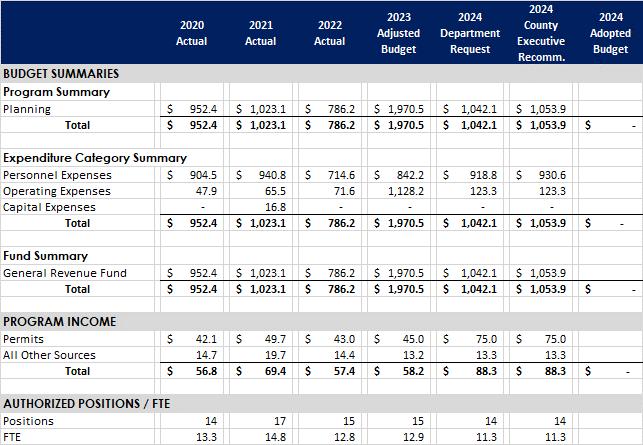
Spirit of St. Louis Airport
John D. Bales, DirectorRECOMMENDED FY24 BUDGET
$37,940,914 FULL TIME EQUIVALENTS
16.7
AIRPORT MISSION
The mission of the Spirit of St. Louis Airport is to provide a safe, efficient, dependable, and attractive first-class public facility that professionally serves the users and tenants. The airport strives to maintain its role as a major air transportation facility for the St. Louis region, while continuing to be a responsive and responsible neighbor to the surrounding community.
BUDGET OVERVIEW
The 2024 recommended budget for the Spirit of St. Louis Airport is $37,940,914 an increase of $1,892,794 or 5.3 percent from the 2023 adjusted budget of $36,048,120. Personnel costs comprise 3.8 percent of the budget for 22 positions (16.7 full time equivalents). Operating and capital expenses account for the remaining 92.6 percent of the budget.
SIGNIFICANT CHANGES
The 2024 recommended budget includes $4 million to replace the West Terminal, and $400,000 for safety management systems updates and design services for the north runway.
CORE BUSINESS FUNCTIONS
Spirit of St. Louis Airport is a Federal Aviation Administration (FAA) Air Carrier Certified Airport and is responsible for the management of:
→ A self-supporting enterprise fund through the sale of jet fuel
→ A 7,485-foot all-weather runway
→ A 5,000-foot parallel runway
→ Precision Instrument Landing System (ILS) approaches
→ FAA Control Tower
→ 24-hour United States Customs Service
→ 24-hour Airport Police Service
→ 24-hour Aircraft Rescue Firefighting response service
STRATEGIC PRIORITIES AND PERFORMANCE METRICS
• Increase flight traffic and fuel sales (GG – Efficient and Responsible)
• Continue a land acquisition program to convert properties currently under 99-year lease to fee simple (GG –Improve Effectiveness)
• Develop and lease available airport real estate, with increased promotion and marketing, providing increased revenues and economic development opportunities for St. Louis County (O – Inclusive Development)
• Increase public relations activies to educate the community of the great asset that the Spirit of St. Louis Airport is for St. Louis County and the region (O – Rebuild Pride and Optimism)
ORGANIZATIONAL CHART
County Executive
Chief Operating Officer
Director Of Aviation
Manager Administrative Services
Accountant II
Airport Police
Executive Secretary
Deputy Director of Aviation
Airport Maintenance Manager
Airport Maintenance Foreman
Airport Maintenance Lead
Airport Maintenance Workers
Auto Mechanic III
Auto Mechanic II
Airport Fire Fighters Airport Engineer

Department of Transportation & Public Works
Stephanie Leon Streeter, P.E., DirectorRECOMMENDED FY24 BUDGET
$113,978,424
DEPARTMENT MISSION
FULL TIME EQUIVALENTS
720.4
To promote the health, safety, and well-being of St. Louis County residents by providing a transportation system that supports multi-modes and encourages regional growth and opportunity; enforce internationally accepted building and property maintenance codes reasonably and judiciously for public health, safety, and protection; provide customer friendly building spaces in which to conduct county business; and support innovative problem solving that enhances public service.
BUDGET OVERVIEW
The 2024 recommended budget for the Department of Transportation and Public Works is $113,978,424, a decrease of $1,674,418 or 1.4 percent from the 2023 adjusted budget of $115,652,842. Personnel costs comprise 53.8 percent of the budget for 732 positions (720.4 full time equivalents). Operating and capital expenses account for the remaining 46.2 percent of the budget.
SIGNIFICANT CHANGES
The 2024 recommended budget includes a decrease of $5,540,000 for the one-time cost of a consultant contract for Project Cornerstone and an increase of $1,690,000 to outsource maintenance of the Justice Center The budget also eliminates $1,821,490 of turnover and hiring lag appropriation reductions that were included in the 2023 budget.
CORE BUSINESS FUNCTIONS
The Department of Transportation & Public Works is responsible for the management of:
→ Planning, design, construction, inspection, operation, and maintenance of 3,169 lane-miles of road
→ 220 vehicle and pedestrian bridges
→ 1,000+ crossroad culverts
→ 1,300 miles of sidewalks
→ 47 miles of dedicated on-street bicycle lanes
→ 13 miles of signed bicycle routes
→ 680 signals and beacons
→ 250,000 signs
→ 35 owned buildings (2.9M gross ft2)
→ 16 building leases (0.3M gross ft2)
→ Review of 14,400 plan sets
→ Issuance of 57,300 permits
→ 139,400 construction inspections
→ 18,400 residential re-occupancy inspections
→ 8,400 property maintenance inspections
→ Monitoring of over 1,200 vacant nuisance properties
→ Mowing of 2,600 vacant lots
→ Capital and operating budget development and oversight
→ Supply acquisition and safety training

→ Maintenance of 3,557 vehicles, trucks, and engine-powered equipment
→ Maintenance of 2 county-owned parking garages
→ Fuel supply for county vehicles/equipment and municipal fleets by contract

→ Contract management of water service line repairs on qualifying residential lines within St. Louis County

PROGRAM DESCRIPTIONS
Project Development
→ Contract management of sewer lateral line repairs in unincorporated St. Louis County and within municipalities by contract
→ Construction management for department administered road and bridge projects

→ Inspection for all Special Use Permits issued for work in the public right of way



The Division of Project Development was formed by the merger of the Planning & Programming and Design divisions and offers streamlined project delivery service from project inception to bidding. The division compiles road, traffic signal, intersection, bridge, bicycle, sidewalk, Americans with Disabilities Act (ADA) and rehabilitation needs and performs needed analysis to develop a fiscally responsible five-year Transportation Capital Construction Program. Utilizing both in-house staff and contracted professional services, the division will plan and design both capital improvement and maintenance projects. The division applies current federal, state and county standards as well as context sensitive design methodology to plan and design future projects. The division coordinates with the Minority and Women Business Enterprise (M/WBE) Program on participation goals for professional service and construction contracts and oversees the contract procurement process for contracted services. Frequently, the division secures alternative funding from innovative finance sources, federal and state programs, and partnerships with key stakeholders to advance projects and programs. The division also acquires right-of-way and handles real estate transactions to accommodate project buildout utilizing both staff and contracted services. Public input is important in the project process, so this division also holds public forums/informational open houses and uses area engineers as liaisons between the department, St. Louis County residents and other agencies to understand and address community issues. In addition to traditional project development services, the division’s bridge inspection team performs approximately 300 bridge inspections and 150 culvert inspections annually.
Note: Site/construction plans, Special Use Permits and flood plain studies pertaining to work in unincorporated St. Louis County or that involves St. Louis County right-of-way within municipal boundaries, are reviewed by Civil Plan Review in the Division of Code Enforcement.
Strategic Priorities and Performance Metrics:
• Priority 1 (TP1.1): Maintain infrastructure in fair or better condition (Pavement Condition Rating [PCR] 5-10) (GG
– Efficient and Responsible)
• Priority 2 (TP1.2): Improve transportation infrastructure through the design and implementation of capital improvement projects (GG – Efficient and Responsible)
• Priority 3 (TP1.3): Secure alternative funding (O – Improve Quality of Life)
Construction
The Construction Division inspects and oversees contract construction and preservation work performed within St. Louis County right-of-way and the right-of-way improvements are performed by subdivision and commercial developers. The division performs field surveys and operates a Materials Testing Laboratory accredited by the American Association of State Highway and Transportation Officials (AASHTO) to ensure that the expenditure of public monies on new construction projects and the rehabilitation of existing county-maintained roads results in a quality transportation system. The division performs research, testing and analysis of materials incorporated into roadway construction contracts and right-of-way improvements, and provides materials testing services to other divisions, departments, and municipalities. Construction staff also works with the M/WBE Program Office to assure contract provisions are being met. The division performs project survey layout work, benchmark and right-of-way monument preservation and provides survey work for other county departments. The Construction Division also enforces St. Louis County’s Land Disturbance Code for residential properties.
Strategic Priorities and Performance Metrics:
• Priority 1 (TP2.1): Administer quality road and bridge construction with a delivery emphasizing overall value and safety for the customers (GG - Efficient and Responsible)
Operations
The Operations Division lays asphalt, pours concrete, seals cracks, replaces culverts, fills potholes, mows grass, plows snow, spreads salt, removes pavement debris, repairs sidewalks and driveway approaches, repairs bridge decks, sweeps roads, removes trees and tree branches, cleans up litter, removes dead animals from the road and right-of-way, provides high priority emergency response for flooding and performs many other tasks directly related to providing a safe, obstruction and hazard free road system. The division manufactures and installs street signs, maintains traffic signals, stripes pavement, conducts traffic studies, collects traffic data, locates underground utilities, and runs state-ofthe-art traffic operations from the Traffic Operations Building (TOB) featuring a traffic signal control room, enabling signal system integration with MoDOT’s system, remote signal control in real-time and traffic monitoring. The division also operates a modern radio and dispatch system.
Strategic Priorities and Performance Metrics:
• Priority 1 (TP3.1): Maintain public safety and mobility through active snow removal activities (GG - Efficient and Responsible)
• Priority 2 (TP3.2): Actively resolve citizen service requests in a timely manner (GG - Constituent Experience)
Fleet Management/Garage
The Fleet Management/Parking Garage Division provides cradle-to-grave services for 3,557 motor vehicles and other engine-powered machinery owned by St. Louis County, including acquisition, vehicle registration, preventative maintenance, repair service, emissions testing, fueling, and disposal via public auctions. The division operates two county-owned parking facilities in the City of Clayton, providing 2,254 parking spaces for both employees and the public as well as parking by lease contract. Division staff operate the county’s vehicle pool, dispenses 1.3 million gallons of fuel annually from 8 fuel sites located throughout the county and provides mechanic and fuel services under contract to municipalities.
Strategic Priorities and Performance Metrics:
• Priority 1 (TP4.1): Complete all preventative fleet maintenance actions on schedule (GG - Efficient and Responsible)
Administrative Services
The Administrative Services Division provides administrative, fiscal and personnel services. The division maintains department records, manages payroll and benefits, recruitment, and job classification evaluation, assists in disaster recovery coordination, oversees supply issuance, and manages the department’s safety program. Division staff also oversees the county’s Water Service and Sewer Lateral Line Repair programs through which approximately 550 residential water service line repairs are performed annually throughout the county, and approximately 1,000 sewer lateral repairs are performed annually in unincorporated St. Louis County and in 12 contract municipalities.
Strategic Priorities and Performance Metrics:
• Priority 1 (TP7.1): Improve staff recruitment and retention (GG - Efficient and Responsible)
• Priority 2 (TP7.2): Provide responsive sewer lateral and water service program support to customers (GGEfficient and Responsible)
Code Enforcement
The Code Enforcement Division reviews plans, issues permits, and conducts inspections related to the enforcement of land disturbance, building, mechanical, electrical, plumbing, commercial and residential property maintenance, zoning, and public safety-related codes throughout unincorporated St. Louis County and for municipalities that contract with St. Louis County. The division handles licensing of the mechanical, electrical and plumbing disciplines. Re-occupancy inspections occur on single-family homes and apartments (in unincorporated St. Louis County and in 14 municipalities by contract) every year. The division also issues permits for work being completed on St. Louis County’s Transportation System. The Business Assistance Center (BAC) within the Code Enforcement Division assists new and expanding businesses in navigating St. Louis County’s plan review, permitting, inspection and licensing processes, identifies and addresses potential pitfalls beforehand through pre-design project meetings and acts as a liaison between county departments and business owners throughout their project’s life.
Strategic Priorities and Performance Metrics:
• Priority 1 (TP6.1): Actively investigate and respond to property maintenance complaints (GG - Improve Effectiveness)
Performance Metric:
# of property maintenance complaints
Facilities Management
2021 2022 2023 2024
x 439 x x
The Facilities Management Division prepares the five-year Capital Improvement Program for facility assets. The division identifies short-term and long-term needs and priorities related to buildings and systems. Both basic facilities, capital, and maintenance projects as well as complex building projects are designed within this Division. Complex building project construction is performed by contractors while maintenance projects are completed by in-house staff. Staff work with the County’s Procurement section to bid out work or select winning proposals that also follow County diversity requirements to complete projects to be performed by private contractors.
The division operates and maintains 51 buildings/facilities owned or leased by St. Louis County. Encompassing 3.2 million gross square feet, these facilities are located throughout the county and include office buildings, the County Justice Center, the County Courthouse, public health clinics, police precincts, parking garages, and a morgue. The division performs maintenance, repair and minor construction including heating, ventilation, and air conditioning, electrical, plumbing, carpentry, and sheet metal work. Specialty service contractors are used to assist in troubleshooting and repairing major systems and equipment. Janitorial work is accomplished primarily through service contracts.
Strategic
• Priority 1 (TP5.1): Maintain average facility condition across all owned facilities at fair or better rating (GGEfficient and Responsible)
• Priority 2 (TP5.2): Support the use of alternative power and efficiency options (GG - Efficient and Responsible)
• Priority 3 (TP5.3): Maintain fair or better occupant ratings of facility cleanliness and thermal comfort (GGEfficient and Responsible)
ORGANIZATIONAL CHART
St. Louis County Executive
Chief Operating Officer
Director of Transportation & Public Works
Deputy Director of Transportation & Public Works
Fleet
Administration
Project Development
Code Enforcement
Facilities Management
Construction
Operations
Garage Operations
Fleet Operations
Fiscal Services Safety Administration Personnel
Public Information
Telephone/Mail Room/Central File/Microfilm
Water Service & Sewer Lateral Repair Program
Transportation Planning
Estimating and Design
Property Acquisition
Building/MEP Permit/Plan Review/ Inspections
Property Maintenance & ReOccupancy
Transportation (SUP) Permitting & Plan Review
Building Maintenance
Construction Inspection
Transportation System Maintenance
Bridge Inspection
Flood Plain & Land Disturbance
Building/System Planning, Design & Construction
Facility Leases
Materials Lab
Traffic Operations
Surveying
BUDGET SUMMARY




Health & Well‐Being
St. Louis County Children’s Service Fund
Emily Koenig, Executive DirectorRECOMMENDED FY24 BUDGET
$65,226,406
FUND MISSION
FULL TIME EQUIVALENTS
27.3
The mission of the Children’s Service Fund (CSF) is to improve the lives of children, youth, and families in St. Louis County by strategically investing in the creation and maintenance of an integrated system of care that delivers effective and quality mental health and substance use treatment services.
BUDGET OVERVIEW
The 2024 recommended budget for the St. Louis County Children’s Service Fund is $65,226,406 a decrease of $18,772,434 or 22.3 percent from the 2023 adjusted budget of $83,998,841. Personnel costs comprise 4.2 percent of the budget for 31 positions (27.3 full time equivalents). Operating and capital expenses account for the remaining 95.8 percent of the budget.
SIGNIFICANT CHANGES
The 2024 recommended budget includes a decrease of $20,000,000 for core funding and special programs as approved by the CSF Board.
CORE BUSINESS FUNCTIONS
The St. Louis County Children’s Fund is responsible for the management of:
→ Strategic investments of sales tax revenue
→ Ensuring accountability of sales tax revenue through programmatic and financial reviews of funded agencies
→ Evaluating service gaps through community needs assessments, data analysis, and stakeholder engagement
→ Developing strategic partnerships with other agencies
→ Supporting non-profit agencies through capacity building and technical assistance
STRATEGIC PRIORITIES AND PERFORMANCE METRICS
Late in 2018, CSF began to develop a comprehensive three-year strategic plan, incorporating internal and external stakeholder feedback at key points. CSF’s plan is ambitious and represents a major shift towards reconnecting with the community, use of data to drive decision-making, elevating awareness of children’s issues and further aligning with other regional entities to ensure community impact is maximized and moving toward equitable service provision in schools and throughout the region. Starting January 1, 2020, the CSF staff and board started working through tactics to achieve the objectives and goals presented below.
Below, find the overarching strategic priorities of CSF.
• Leadership: Champion a community-level children’s behavioral health investment and policy agenda grounded in a population health approach with equity as a central tenet (HS – Reduce Health Disparities)
• Impact: Develop, adapt, and promote an impact framework that supports regular assessment of performance results and informs improvement opportunities (O – Improve Effectiveness)
• Community: Cultivate a climate of trust, transparency, coordination, partnership, and inclusivity with stakeholders (O – Rebuild Pride and Optimism)
• Alignment: Align with existing initiatives and promote operational practices that maximize existing resources and introduce efficiency (O – Ensure Services are Efficient and Responsible)
• Internal Capacity Building: Strengthen CSF’s organizational infrastructure to enable the organization to serve as a leader in child and youth behavioral health (O – Improve Effectiveness)
In 2019, CSF adopted new standardized outcomes to measure the impact of our funded partners in alignment with St. Louis MHB and United Way of Greater St. Louis with the goal of showing regional impact of services for children and youth. Below is a list of outcomes from CSF’s funded partners.
ORGANIZATIONAL CHART
County
Department of Human Services
Howard Hayes, DirectorRECOMMENDED FY24 BUDGET
$4,702,831
DEPARTMENT MISSION
FULL TIME EQUIVALENTS
65.2
The Department of Human Services is committed to providing the support, services, and resources that help individuals of all ages live safely, productively, and independently.
BUDGET OVERVIEW
The 2024 recommended budget for the Department of Human Services is $4,702,831, an increase of $1,006,706 or 27.2 percent from the 2023 adjusted budget of $3,696,125. Personnel costs comprise 91.7 percent of the budget for 76 positions (65.2 full time equivalents). Operating and capital expenses account for the remaining 8.3 percent of the budget.
SIGNIFICANT CHANGES
The 2024 recommended budget includes an increase of $101,877 for the warming and cooling shelters and a reduction of $76,756 from grant reimbursements. The budget also includes the elimination of $681,065 of turnover and hiring lag appropriation reductions that were included in the 2023 budget.
CORE BUSINESS FUNCTIONS
The Department of Human Services is responsible for the management of:
→ Providing services for homeless and potentially homeless individuals and families
→ Assisting county older residents with maintaining independent living and quality of life
→ Providing information, referrals and case management services for veterans and their families
→ Providing community-based intervention, case management, mental health and youth development services for at-risk children and youth
→ Operating a 39-bed residential domestic violence shelter for abused women and their children.
→ A full spectrum of employment services for job seekers and employers funded by the Department of Labor (not included in this budget)
→ Increasing Sustainable Economic and Housing Options for Marginalized Populations through federally funded programs (not included in this budget)
PROGRAM DESCRIPTIONS

Office of Family & Community Services and Homeless Services Program
This division provides and administers a wide array of programs for children and youth, older adults, Veterans, and homeless families. Services include: Doors To Success, a comprehensive education and living skills program for youth who have dropped out of school; the Summer Food Program, providing breakfast and lunch for low-income children when school is not in session and in areas of food insecurity; Supportive Services, Housing, Tax Assistance for older adults; Medical Transportation for older adults and veterans; and Benefits Advocacy for veterans and their families.
2024 ALLOCATION OF RESOURCES
The Homeless Services Program Division administers and facilitates Prevention, Rapid Re-Housing, Emergency Shelter, Street Outreach, and Housing Assistance for homeless and at-risk families, counseling, case management and resource assistance for all target populations. Impact of the work performed is magnified through partnerships represented via the Saint Louis County Continuum of Care, a greater than fifty-member body of organizations addressing housing instability in the region.
Strategic Priorities and Performance Metrics:
• Priority 1 (DHS4.1): Support young adults to become healthy and productive members of the community (O –Inclusive Development)
• Priority 2 (DHS4.2): Meet the individualized needs of youth ages 12-19 through Case Management Services (O –Inclusive Development)
• Priority 3 (DHS4.3): Empower County youth to become leaders and stewards of their community (O – Inclusive Development)
• Priority 1 (DHS5.1): Facilitating older adults being able to receive refunds/rebates they are entitled to and file required Federal and State tax forms (O – Improve Quality of Life)
• Priority 1 (DHS6.2): Provide housing stability services (O – Improve Quality of Life)


• Priority 1 (DHS7.1): Assist St. Louis County veterans and families to obtain eligible compensation and benefits (O – Improve Quality of Life)

Is anyone better off? (Effectiveness)
made (Veteran Medical Central, National Cemetery assistance, Regional Benefits Office, Legal Assistance, Tax Assistance, Housing A, Defense Enrollment Eligibility Reporting System, National Personnel Records Center)
Women And Children Services
The Women and Children’s Services Division operates the 39 bed Kathy J. Weinman Domestic Violence Shelter for women and children who have been victims of intimate partner violence. The Weinman Shelter offers women and their children a full range of services. These include case management, individual/family therapy, support and educational groups for women, children and teens, financial literacy classes, court and housing advocacy and accompaniment, nutrition classes, parenting and life skills classes, trauma awareness, follow-up programming, referrals and advocacy for other resources, i.e. legal services, employment and housing assistance, victims of crime services, substance abuse, health/medical services, and psychiatric/mental health services. These are some of the most vulnerable and marginalized individuals in and around the St. Louis County area with an average annual income of approximately $5,164.
Strategic Priorities and Performance Metrics:
• Priority 1 (DHS2.1): Decrease homeless due to intimate partner domestic violence by providing safe shelter (O –Improve Quality of Life)
• Priority 2 (DHS2.2): Increase survivors’ opportunities to obtain independent, stable and sustainable housing (O –Improve Quality of Life)
How much did we do? (Quantity)
How well did we do it? (Quality)
Is anyone better off? (Effectiveness)
The Administration Division provides support services through the following sections: Director’s Office, Personnel, Financial and Information Technology for all program divisions.
Office Of Community Development
The Office of Community Development (OCD) strives to revitalize and sustain communities by providing affordable housing and alleviating poverty and blight. OCD accomplishes its goals by administering three federally funded programs: The Community Development Block Grant (CDBG) Program, the Home Investment Partnerships (HOME) Program, and the Lead Hazard Control Program. By partnering with a variety of municipal and nonprofit stakeholders, OCD plans and oversees projects such as streetscape improvements, home repairs, construction of affordable housing, infrastructure improvements, down payment assistance, and lead paint remediation. These efforts allow OCD to continue its vision of healthy, sustainable mixed-income communities throughout St. Louis County.
Strategic Priorities and Performance Metrics:
• Priority 1 (DHS1.1): HOME Program – Significantly increase the ability of low- and moderate-income first-time homebuyers to purchase a home (O – Quality of Life)
• Priority 2 (DHS1.2): Assist low- and moderate-income homeowners with home repairs to maintain minimum housing code standards and address accessibility and safety issues (O – Quality of Life)
How much did we do? (Quantity)
Workforce Development
The Workforce Division is responsible for providing services that promote economic well-being for residents of St. Louis County. Workforce Development accomplishes this by offering targeted services to youth and adults with an emphasis on ensuring connections to job opportunities and training programs that assist them in developing marketable skills. More specifically, the services available to job seekers include job search activities, workshops such as interviewing preparation, basic computer skills, resume development, career networking, career assessment and career planning. Programs are designed to enhance and improve the economic prosperity of individuals while also meeting the needs of local industry. Workforce Development has a sector-based strategy that is designed to create pathways to employment in high growth and high demand industries that give St. Louis County a competitive edge. The division partners with local employers, hosting hiring events at the Missouri Job Centers located in St. Louis County, and helping those companies identify talent for open positions. Workforce Development aspires to support the broader goal of the department in helping individuals of all ages live safely, productively, and independently through sustainable employment.
Strategic Priorities and Performance Metrics:
• Priority 1 (DHS3.1): Provide wage-sustainable employment opportunities for all job seekers (O – FamilySustaining Jobs)
• Priority 2 (DHS3.2): Cultivate measurable skills gained and successful credential attainment for those pursuing training (O - Family-Sustaining Jobs)
ORGANIZATIONAL CHART
County Executive
Chief Operating Officer
Director of Human Services
Executive Secretary
Deputy Director
Kathy J. Weinman Shelter
County Housing Officer / Affordable Housing
Office of Family & Community Services
Public Information Mananager
Financial Services and Information Systems
Office of Community Development
Equal Opportunity Officer Workforce Development
County Older Resident Program
County Youth Programs
County Veteran Services Program
Homeless Services Program
Grants, Stimulus Funds & Fund Reporting
Community Development
Job Center Fornula Grants
Grant Oversight for Fiscal Compliance
Budgeting & Fiscal Analysis
HOME Program Home Improvement Program
Neighborhood Stabilzation
On-the-Job Training
Business Services Group
BUDGET SUMMARY ($ IN THOUSANDS)
RECOMMENDED FY24 BUDGET
$1,049,928
OFFICE MISSION
FULL TIME EQUIVALENTS
10.4
The Office of the Public Administrator is established by state law to serve as guardian, conservator, personal representative, executor, and other necessary roles upon appointment by the Probate Court. The Public Administrator shall take into their charge and custody the estates of incapacitated and disabled individuals, the estates of deceased individuals, and the estates of minors, promoting the self-worth of each individual as well as preserving, protecting, and managing their assets. The Public Administrator’s Office strives to instill values of advocacy, dignity, empathy, and integrity into their everyday work while serving the most vulnerable citizens of St. Louis County.
BUDGET OVERVIEW
The 2024 recommended budget for the Public Administrator is $1,049,928, an increase of $49,025 or 4.9 percent from the 2023 adjusted budget of $1,000,903. Personnel costs comprise 87.8 percent of the budget for 11 positions (10.4 full time equivalents). Operating and capital expenses account for the remaining 12.2 percent of the budget.
SIGNIFICANT CHANGES
The 2024 recommended budget includes an additional Deputy Public Administrator position to fulfill the office’s additional needs due to increased caseloads
CORE BUSINESS FUNCTIONS
The Office of the Public Administrator is responsible for the management of:
→ Guardianship of incapacitated and disabled individuals
→ Conservatorship of the estate and assets of incapacitated and disabled individuals
→ Conservatorship of the estate and assets of minors
→ Administering the estates of deceased persons
→ Collaborating with state and community-based resources to improve services
→ Educating the community through personal interaction and community involvement
→ Advocating and influencing public policy for the welfare of our wards and protectees
STRATEGIC PRIORITIES
• Provide superior and effective service to the estates under the Public Administrator’s care (GG - Improve Effectiveness)
• Find and provide ways to inform and educate the public regarding the role of the Public Administrator (GGConstituent Experience)
• Improve regional relationships and share ideas through networking and involvement with Missouri Association of Public Administrators (GG - Efficient and Responsible)
ORGANIZATIONAL CHART
Public Administrator
Chief Deputy Public Administrator Deputy Public Administrators
Attorney for Public Administrator Office Manager Bookkeeper
Settlement Clerk
Receptionist
Note: The Public Administrator is appointed to a four-year term by the St. Louis County Circuit Court
Department of Public Health
Dr. Kanika A. Cunningham, DirectorRECOMMENDED FY24 BUDGET
$84,980,604
DEPARTMENT MISSION
FULL TIME EQUIVALENTS
537.1
The mission of the St. Louis County Department of Public Health (DPH) is to promote, protect, and improve the health and environment of the community. The department’s vision is that St. Louis County has healthy people, a healthy environment, and equitable communities.
The department believes in:
• Being a public health leader in the community
• Providing equitable access to services and resources
• Being responsive to the changing needs of the community
• Operating in an ethical, transparent, and fiscally responsible manner
• Serving the community with dignity and respect
BUDGET OVERVIEW
The 2024 recommended budget for the Department of Public Health is $84,980,648 an increase of $4,178,956 or 5.2 percent from the 2023 adjusted budget of $80,801,648. Personnel costs comprise 56.3 percent of the budget for 570 positions (537.1 full time equivalents). Operating and capital expenses account for the remaining 43.6 percent of the budget.
SIGNIFICANT CHANGES
The 2024 recommended budget eliminates 26 positions and $5,421,195 of turnover and hiring lag appropriation reductions that were included in the 2023 budget.
CORE BUSINESS FUNCTIONS
→ Assessing and monitoring the health status of the population and making information available to the public on communicable and chronic diseases, emerging epidemics, and the social and structural determinants of health
→ Assessing health hazards and their root causes, and the environmental status of the community while making information available to the public on conditions that may contribute to health outcomes
→ Preparing for emergencies that may affect the health of the public and participating in deploying a trained public health workforce in the event of any emergency, disaster, or epidemic
→ Ensuring the effective enforcement of all codes, ordinances, and best practices related to protecting the health of the public
Ensuring equitable availability of services, programs, and access to care necessary to the population based on their health needs either through the direct provision of services or through effective community linkages and partnerships
→ Controlling or contracting the operation of all direct clinical services provided by the county including medical care, dental care, preventative care, mental and behavioral health, and treatment of infectious diseases
→ Informing and educating the population and acting as a community resource on health-related topics
→ Recommending policies to the governing entities that will strengthen, support, and preserve the public health of the county

→ Strengthening, supporting, and mobilizing community partnerships and cooperative relationships with neighboring jurisdictions, state and federal agencies, and local and national organizations for the promotion and protection of the public health of the population
PROGRAM DESCRIPTIONS
Administration
Administration is responsible for the highlevel operations and policies of the department. This division supports many of the constituent functions and access points across DPH’s numerous programs. Administration is also responsible for DPHspecific personnel needs, such as clinical placements for practicum students and accreditation requirements. This division includes several offices to accomplish our work. A significant portion of DPH’s Administration budget supports the Countyrequired central service charge whereby department funds are sent to the County’s general revenue fund to support needs in HR, IT, and other similar programs.
Office of Communications
This team is charged with fulfilling our department’s communications needs. Communications is one of the 10 essential public health services as defined by the CDC. To cause behavioral changes that lead to better health, it is imperative that DPH effectively communicate with the public about health threats, the services we offer, and the steps residents can take to improve their health. To perform those functions, the communications team conducts media relations, produces public health campaigns, creates health advisories and press releases, and collaborates with partners across the region. Among the products the team produces are talking points, physical signage, social media messaging, video productions, motion graphics and advertising.
Office of Strategy and Quality Management
This staff is responsible for the long-term strategic planning, accreditation, workforce investment, and many of the grant-writing functions of the department. This office also coordinates with other offices and divisions in the department to identify performance management metrics, monitor clinical metrics, and identify opportunities for efficiencies and division and departmental improvements.
Office of Health Informatics (OHI)
OHI supports health technology projects throughout DPH. Working closely with County IT, OHI leverages health technology to improve processes, increase efficiency, and ensure that DPH staff have the technology resources
necessary to best serve the community Teams include clinical support, informatics, and application support. These teams support various programs and a variety of software platforms and applications across DPH.
Strategic Priorities and Performance Metrics:
• Decrease staff turnover rate to 20% for 2023 (GG – Improve Effectiveness)
Fiscal Services
Fiscal Services provides financial and accounting support to all divisions and programs operated by DPH. Financial support includes budgeting, accounting, grant management, reporting, and program compliance. Accounting activities include accounts receivable and payable, invoicing, check processing, purchase requisitions, financial statements, patient accounts, and budget presentations. Additionally, the offices of Vital Records, Facilities Management, and Contracts, Grants, and Legislative Affairs are housed within Fiscal Services. Fiscal Administrators are responsible for all DPH financial matters, and monitor the department’s compliance with county policies, administrative regulations, and the requirements of state and federal agencies.
Health Promotion & Public Health Research (HPPHR)
HPPHR works to address all chronic disease surveillance and prevention issues while integrating health promotion messages throughout all aspects of the division’s work. Behavioral health and health equity are two significant department concentrations. HPPHR develops policies, plans, and interventions in close collaboration with partner agencies and academia, activating county resident participation by lifting community voice to drive community engagement strategies. Functions of HRRPH include the Public Health Nursing (PHN) Program; the Opioid and Overdose Action Plan; the Violence Prevention Action Plan; and department-wide scientific support for chronic disease, substance use, and mental health surveillance and prevention. PHN is a community-based program that promotes health behaviors and disease prevention through cross-functional collaboration within DPH to foster community relationships such as providing nursing and home visit services. HPPHR coordinates updates to the Community Health Assessment (CHA), the Community Health Improvement Plan (CHIP), DPH’s strategic plan, and initiated support for the Public Health Accreditation Board (PHAB) reaccreditation process using an equity and social determinants of health lens.
Strategic Priorities and Performance Metrics:
• Increase the number of health education community engagement events to an average 8 per month (HS –Reduce Health Disparities)
• Increase Narcan units distributed to the community; address health disparities (HS – Curb Opioid Epidemic)
Communicable Disease Response (CDR)
This division detects, manages, and responds to communicable diseases and other public health threats in St. Louis County. The programs under this division are the Sexually Transmitted Infection (STI) program, Emerging Infection Response Case Investigators and Contract Tracers, the Tuberculosis program, and the Hepatitis programs:
STI Program
The STI program, located at the North Central Community Health Center, is one of the region’s only safety net providers of comprehensive STI testing and treatment services for underinsured and uninsured residents. The clinic screens patients for all STIs including chlamydia, gonorrhea, syphilis, and HIV and sees between 4,000 and 8,000 visits per year. The STI program is essential in the effort to reduce STI infection and transmission in the region and increase the accessibility of free and low-cost sexual health resources for residents of St. Louis County.
Emerging Infections Case Investigators and Contact Tracing
The Emerging Infections Case Investigation and Contact Tracing team plays a key role in minimizing the spread of emergent diseases in St. Louis County by contacting residents who test positive such a disease, conducting an investigation, and ensuring that the resident follows proper isolation protocols. Additionally, the team reaches out to possible contacts of those who have contracted such a disease, educates them on quarantine protocols, and enrolls them in a monitoring program for symptoms to prevent further infection and transmission.
Tuberculosis
The Tuberculosis (TB) program treats nearly all cases of active TB in St. Louis County. The program monitors and ensures adherence to the treatment regimen and conducts contact investigations to prevent spread. In addition, this program serves as the foremost source of knowledge on TB in the region and collaborates with the local healthcare community to educate and screen the public to prevent TB infection and transmission.
Hepatitis
The Hepatitis program works with at-risk residents to ensure testing, vaccination, education, and referral to care. The program also provides case management services for pregnant residents infected with Hepatitis B virus and increases healthy outcomes for their babies.
Communicable Disease Prevention (CDP)
The programs under this division include Animal Care and Control (ACC), Vector-borne Disease Prevention (VDP), Emergency Preparedness (EP), Communicable Disease Nursing, and Communicable Disease Epidemiology.
Animal Care and Control (ACC)
ACC is responsible for promoting and protecting the health and welfare of people and animals in St Louis County. This is accomplished by controlling populations of stray and feral animals; enforcing relevant county ordinances; providing community education relevant to responsible pet acquisition and ownership, including abidance to relevant county ordinances; promoting adoption or rescue of as many animals under care as possible; and providing exemplary care for animals housed at the county shelter.
Vector-borne Disease Prevention
VDP is responsible for the prevention and control of 11 different vector-borne diseases in St Louis County through field surveillance, evidence-based larval and adult mosquito abatement, tick surveillance and abatement, arboviral disease testing, pesticide resistance monitoring, and rodent abatement. VDP provides critical public education on reduction of risk factors for mosquito breeding and other pest proliferation on private property. VDP also plays an integral role in disaster mitigation and recovery during flooding events.
Emergency Preparedness
EP is responsible for strategic directions and implementations of EP efforts across DPH including drills and other preparedness exercises and training and inventory management of emergency supplies. EP also coordinates and collaborates with other emergency preparedness agencies in the St. Louis region, including the Office of Emergency Management, SEMA, and FEMA to provide subject matter expertise on emergency plans and during emergencies; building resilient communities through engagement and training; planning and implementation of regional exercises.
Communicable Disease Nursing
The Communicable Disease Nursing team is a dedicated team of communicable disease experts who investigate all cases of reportable conditions and diseases in St. Louis County. Their investigation is the first line of defense to detect and contain cases of communicable diseases like E-coli, rabies, and measles, and prevent them from becoming a large outbreak in the community. Therefore, this team plays a crucial role in the early detection of dangerous public health threats, thus reducing morbidity and mortality.
Communicable Disease Epidemiology
Communicable Disease Epidemiology is responsible for the surveillance of communicable diseases, including curation and interpretation of data for internal DPH reports, policy development, program evaluation, quality assurance, and public-facing dashboards. It provides support to other programs within DPH in the form of collection and analyses of data in areas other than communicable diseases, and provision of technical expertise for architecture of tools for contact tracing and monitoring. Communicable Disease Epidemiology is also widely engaged in local and national community partnerships key to evidence-based public health practice including the Academic Health Department, the Saint Louis Areas Regional Response System (STARRS), and the National Association of County Health Officials (NACCHO), on which staff serves in five different workgroups (Epidemiology, Injury Prevention, Immunizations, Surge Management, and HIV, STI, and Hepatitis).
Environmental Health Services
Air and Waste Management
This team provides waste reduction education and enforcement of codes related to solid waste and air pollution through permit writing, inspection, and complaint investigation. This branch also manages the residential waste hauler contracts for unincorporated St. Louis County.
Food and Environmental Inspections
This team provides inspections of food establishments, tobacco and kratom retailers, body art, onsite sewage, and public water recreation facilities.
Environmental Health Laboratories
Staff in the labs evaluate air, water, soil, and dust samples for levels of environmental toxins known to cause harm to human health for which county, state, and federal government have set a maximum contaminant level; test building materials to determine asbestos content; and conduct clinical blood lead and sexually transmitted illness testing.
Healthy Homes
This team provides in home education and assessments for asthma and lead. They also conduct lodging and childcare facility inspections.
Strategic Priorities and Performance Metrics:
• Increase the percentage of Waste Field Services concerns resolved within 72 business hours to 90% in 2023 (GG – Improve Effectiveness)
• By the end of 2023, 100% of food establishments have at least one routine inspection, 50% inspected according to risk level (12.5% quarterly) (HS – Reduce Health Disparities)
The Office of the Medical Examiner
In Missouri, the authority and responsibilities of medical examiners are mandated by statute. The Office of the Medical Examiner is charged with determining the cause and manner of death in all sudden, unexpected, traumatic, and suspicious deaths that occur in St. Louis County.
The Medical Examiner’s office has an onsite forensic toxicology laboratory to support in these functions by identifying drugs and toxins in samples collected from Medical Examiners’, crime scenes, victims, and law enforcement. In 2022, the laboratory tested samples from over 4300 cases. Currently the laboratory operates as a partnership with SSM/SLU Care and contains staff from both agencies.
The number of deaths requiring investigation by the Office of the Medical Examiner continue to increase. Homicides and drug-related deaths steadily climb year-over-year. The increase in cases this office is responsible for have continued to strain the systems, staff, and supports in place to successfully complete the essential work of the office. As needs have grown, DPH continues to evaluate ways to fulfill its responsibilities to the public.
The Medical Examiner’s Office also shares information in alignment with HIPAA regulations with other organizations working to improve and save lives. The data collected during the investigation of such deaths can be made available to provide on-going surveillance; documentation and monitoring; identification of changes and trends; or to inform public health approaches and other local, state, and federal agencies, and the public.
Clinical Services
In accordance with the St. Louis County Charter, DPH provides direct clinical services to County residents. This occurs in a primary care interdisciplinary care model across three outpatient locations and the St. Louis County Jail. These clinics were federally recognized as a Patient-Centered Medical Home (PCMH) in 2020. The PCMH designation aligns with the division’s continued development and implementation of programs that integrate comprehensive interdisciplinary services into the primary care delivery model. Such services through DPH include nutrition, pharmacy, social, mental health, substance abuse, dentistry, pediatric and prenatal, immunization, and many more. Clinical services provided around 42,800 clinical encounters to around 20,500 individuals in 2022.
The Corrections Medicine practice has continued to update and innovate its service delivery model to adapt to the changing care needs of incarcerated patients, including increasing 24/7 coverage models, adding paramedics and EMTs to the care team, and providing substance use clinical services including medication assisted treatment for opioid use disorder. Corrections Medicine provided approximately 4150 clinical encounters to around 1800 individuals in 2022.
Strategic Priorities and Performance Metrics:
• Increase the number of clinic visits per quarter (HS – Reduce Health Disparities)

SUMMARY




CHAPTER SUMMARY
Public Safety
Emergency Communications Commission
Chief Greg Brown, Chairman and Mike Clouse, DirectorRECOMMENDED FY24 BUDGET
$19,167,556
COMMISSION MISSION
FULL TIME EQUIVALENTS
14.5
The St. Louis County Emergency Communications Commission (ECC) provides a coordinated council of department leaders from public safety agencies and local government entities, with an emphasis on providing interoperable communications that allow firefighters, emergency management services, police, and other groups to better manage incidents by sharing vital information in a rapid fashion.
The Emergency Communications Fund was created in 2010 to record revenues received from the countywide 0.10% sales tax approved by St. Louis County voters on November 3, 2009. Revenues from this tax shall be used to establish, operate, and maintain an emergency communications system within the county.
BUDGET OVERVIEW
The 2024 recommended budget for the Emergency Communications Commission is $19,167,556, a decrease of $466,440 or 2.4 percent from the 2023 adjusted budget of $19,633,966. Personnel costs comprise 8.4 percent of the budget for 15 positions (14.5 full time equivalents). Operating and capital expenses account for the remaining 91.6 percent of the budget.
SIGNIFICANT CHANGES
The 2024 recommended budget includes a decrease of $654,503 for electronic communication maintenance. The primary driver for the decrease is a reduction in the cost of maintaining telephone equipment
CORE BUSINESS FUNCTIONS
The Emergency Communications Commission is responsible for the management of:
→ Countywide interoperable radio communications
→ Upgrade completion and maintenance of a new Next Generation 911 call handling system
→ The Emergency Outdoor Warning Siren network
→ Management and support of ESInet (emergency services internet protocol network) and MPLS (multiprotocol label switching) networks
STRATEGIC PRIORITIES AND PERFORMANCE METRICS
• Currently in the deployment stage of the Next Generation “9-1-1” system for all Public Safety Answering Points throughout the county (GG - Efficient and Responsible)
• Implementation of Phase 2 of a 2-phase plan to move currently leased data circuits from commercial carriers to a Emergency Communication Council owned Private MPLS network (GG - Efficient and Responsible)
• Consolidation of Emergency Communication Council services onto the ESInet to reduce circuit cost (GGEfficient and Responsible)
ORGANIZATIONAL CHART
SUMMARY
Department of Judicial Administration
RECOMMENDED FY24 BUDGET
$34,046,235
DEPARTMENT MISSION
FULL TIME EQUIVALENTS
377.9
The Department of Judicial Administration serves the citizens of St. Louis County by providing access to a fair, impartial, prompt, and cost-effective system of justice that ensures that all are treated with courtesy and dignity, and that fosters the respect and confidence of the public in an independent judicial system.
BUDGET OVERVIEW
The 2024 recommended budget for Judicial Administration is $34,046,235 an increase of $612,450 or 1.8 percent from the 2023 adjusted budget of $33,433,785. Personnel costs comprise 82.8 percent of the budget for 416 positions (377.9 full time equivalents). Operating and capital expenses account for the remaining 17.2 percent of the budget.
SIGNIFICANT CHANGES
The 2024 recommended budget includes 4 new Detention Deputy Juvenile Officer positions due to increases in the detention population
CORE BUSINESS FUNCTIONS
The Department of Judicial Administration is responsible for the management of:
→ Providing access to justice using jury and bench trials
→ Alternative treatment courts to serve veterans, individuals with substance use disorders (including opioid addiction), mental health issues, alcohol-related driving offenses and domestic violence issues
→ Substance Abusing Families Engaged in Treatment and Intervention (SAFETI) Court to provide close monitoring of parents with substance abuse problems who have children involved in the child welfare system
→ Execution of court orders for attachment, replevin, levy under general execution, eviction, and garnishment of execution
→ Execution of court orders to apprehend and transport alleged mentally ill, dangerous, and/or incompetent persons to and from mental health facilities and court for hearings
→ Programs and services to protect children from abuse and neglect
→ Programs and services for delinquent youth
→ Prosecution of juvenile delinquency matters
→ Safe and secure custody of juveniles within the Court’s Juvenile Detention Center
→ Multi-lingual automated assistance and referrals for victims of domestic violence
Hope Whitehead, Director→ Free marriage ceremonies for all couples who come to the courthouse with a St. Louis County marriage license
→ Expanded community partnerships to provide support, counseling, and alternatives to detention for courtinvolved youth
→ The Exchange Center, which provides a safe, secure environment for the transfer and supervision of children in families with court-ordered visitation
→ The Parent Education Program to help adults understand and cope with the impact of separation and divorce on their children
PROGRAM DESCRIPTIONS


Family Court
In 1993, several judicial divisions of the St. Louis County Circuit Court were consolidated into the Family Court of St. Louis County under the direction of an Administrative Judge. Judges and commissioners assigned to these divisions exclusively hear cases involving children and families. Their training and experience equip them to deal with all types of family issues.

The Family Court operates under the principle of “One Family – One Judge.” All matters involving a particular family are assigned to the same judge or commissioner whenever possible, bringing increased continuity and consistency to the judicial process.
The Family Court has sole authority to hear a variety of cases including domestic relations actions, motions to modify, adult abuse cases and juvenile proceedings. In addition, the court handles some matters referred from other non-Family Court divisions such as guardianships transferred from the Probate Division.
In addition to hearing cases, the Family Court provides numerous support services for juveniles and adults who come to the attention of the Court. Individual and group counseling, probationary services, mediation, parent education classes and restitution programs are among the many programs offered on a sliding payment scale or free of charge.
Judicial Administration
Judicial Administration appropriates funds for the following activities:
Court en Banc
The Circuit Court en Banc consists of all the judges of the 21st Judicial Circuit Court of Missouri acting collectively. Every two years, the Court en Banc votes to select one of its members to serve as Presiding Judge. The Court en Banc determines questions of policy for the Court and promulgates court rules. Each judge of the Court is assigned one or more dockets of cases. Staff assist the Court with administrative and clerical matters, including the calling of jurors.
Alternative Treatment Courts
Alternative Treatment Courts operate under the auspices of the Circuit Court and include separate dockets for Drug Treatment, DWI Treatment, Veterans Treatment, Domestic Violence and Mental Health Treatment. Alternative treatment courts were developed as alternatives to incarceration for nonviolent criminal defendants. Treatment courts strive to strike an appropriate balance between the need to protect community safety and the need to improve the health and well-being of defendants and their families. These courts offer highly structured, supervised, progressive
treatment services while holding individuals accountable for their actions. Clients are subject to frequent, random drug and alcohol testing and are required to appear in court for the judge to review their progress. Clients receive awards and incentives for doing well and sanctions for not fulfilling their obligations.
The St. Louis County Circuit Court is proud to have developed the first Civil Domestic Violence (DV) Court in the State of Missouri. This project has grown to provide comprehensive services whose primary goals are to enhance the safety of victims of domestic violence, hold persons who batter and abuse their intimate partners accountable for their behavior and establish a coordinated community response to domestic violence from the justice system and partner agencies. Approximately 4,000 adult abuse cases involving intimate partners come before the court each year when persons seek civil Orders of Protection. Victims of domestic violence receive advocacy services from the time they file their petitions through the post-resolution phases of their cases. Abusers must complete batterer intervention programs, mental health services, substance abuse treatment and in some cases surrender their firearms. Criminal contempt dockets are conducted to hold accountable persons who violate their court orders.
Sheriff’s Department
The St. Louis County Sheriff’s Department performs multiple court support functions. It serves court papers including writs of execution, levy, possession, and replevin; evictions; assists in transporting individuals involuntarily committed to mental health facilities and enforces court orders including orders of protection. The Department assigns bailiffs to provide security in each division of the Court and maintain order and decorum in the courtrooms.
Circuit Clerk
The Circuit Clerk plans, assigns, coordinates, administers, and supervises more than 225 state and county employees who provide clerical and administrative support to the 21st Judicial Circuit. Their duties are to:
• File, maintain and docket court cases and records
• Develop, revise, and maintain information systems for the Court
• Assess, collect, account, and disburse court costs and fees
• Record monies deposited into the registry of the Court
• Prepare reports as required by the Supreme Court and Circuit Court pertaining to cases filed and heard in the circuit
STRATEGIC PRIORITIES AND PERFORMANCE METRICS
• Expansion of treatment courts: Allow for alternative treatment of individuals with additions and mental health issues (HS - Reform Criminal Justice)
• Serve the public and foster a professional, accessible judicial environment, treating all individuals with dignity, respect, honesty, and fairness with a diverse population (GG - Constituent Experience)
• Preserve the integrity of traditional court practices and procedures, while using alternative courts to enhance delivery of justice to the public (HS - Reform Criminal Justice)
• Comply with the directives of the Missouri Supreme Court and the General Assembly of the State of Missouri for the disposition of designated cases within established time standards (GG - Efficient and Responsible)
• Measure and communicate information regarding the operation and performance of the court with full transparency and accessibility (GG - Efficient and Responsible)
• Respect the interests of the taxpayers of St. Louis County and the State of Missouri by continuously seeking costeffective methods to improve the delivery of justice services to the public (GG - Efficient and Responsible)
• Expansion of services to older youth from the Raise the Age Legislation (GG - Improve Effectiveness)
• Seek additional resources for satellite courts in underserved areas of St. Louis County (GG - Constituent Experience)

SUMMARY
Department of Justice Services
Douglas Burris, DirectorRECOMMENDED FY24 BUDGET
$37,422,661
DEPARTMENT MISSION
FULL TIME EQUIVALENTS
372.8
The mission of the Department of Justice Services is to serve and protect the community by means of a trained and dedicated workforce, and utilizing best practices to provide supervision, rehabilitation, and opportunities in a safe, secure, and humane environment.
BUDGET OVERVIEW
The 2024 recommended budget for the Department of Justice Services is $37,442,661 an increase of $7,772,885 or 26.2 percent from the 2023 adjusted budget of $29,649,776. Personnel costs comprise 83.3 percent of the budget for 392 positions (372.8 full time equivalents). Operating and capital expenses account for the remaining 16.7 percent of the budget.
SIGNIFICANT CHANGES
The 2024 recommended budget includes $1,898,312 to annualize 12 Corrections Officer positions added during 2023 and provide funding for 16 new Correction Officer positions in 2024 The budget also includes an additional $884,000 for the food service contract due to a jail higher population and new contract pricing, and the elimination of $3,259,991 of turnover and hiring lag appropriation reductions that were included in the 2023 budget.
CORE BUSINESS FUNCTIONS
The Department of Justice Services is responsible for:
→ Serving and protecting the community
→ Providing custody, supervision, and guidance to those persons who are mandated to county jurisdiction
→ Maintaining the highest level of security ensuring the safety of the community, residents, and staff
→ Providing a safe, healthy, and humane environment for detainees and staff
→ Encouraging detainees to grow academically, physically, socially, and vocationally
→ Providing educational, recreational, religious, and vocational programs
→ Advancing staff supervision and leadership
→ Supporting the return of detainees back into the community
→ Performing human resources, fiscal management, accreditation standards, internal affairs, and programs for detainees and those released
→ Processing of all arrested persons conveyed to the Intake Center including warrant data, records checks, fingerprinting, mug shots, classifications, and release authorizations
→ Supervision of all resident transfers to courts, clinics, hospitals, and state prisons
Preventing and mitigating the spread of COVID-19
PROGRAM DESCRIPTIONS
Administration

Administration is the division responsible for the overall management and support functions of the department. The division includes Human Resources, Purchasing, Accounting, Information Technology, Training and Accreditation. All new Corrections Officers complete the Corrections Academy, and current staff are offered leadership development. The St. Louis County Jail was reaccredited by the American Correctional Association (ACA) in 2022 and remains the only accredited jail in the State of Missouri.
Strategic Priorities and Performance Metrics:
• Priority 1 (JS1.1): Increase training (HS –Reform Criminal Justice)
2024 ALLOCATION OF RESOURCES
• Priority 2 (JS1.2): Increase the number of qualified applicants for promotion (GG – Improve Effectiveness)



Community Corrections and Reentry Programs
Community Corrections and Reentry Programs have opened all participation with volunteers, programming, and visits. The divisions have added more programs to help all residents once they leave St. Louis County Justice Services. Visitation is nearly back to normal; due to a shortage of staff we do not have visits after 5:00pm. The Choices drug and alcohol treatment program restarted in December of 2021 with a combination of County and grant-funded positions. Community Corrections will continue to be an extremely important part of operations, and additional community partners and grant opportunities will be sought after.
Strategic Priorities and Performance Metrics:
• Priority 1 (JS3.1): Focus re-entry planning on barriers and resources starting at intake (HS – Reform Criminal Justice)
• Priority 2 (JS3.2): Reduce recidivism and return to custody (HS – Reform Criminal Justice)
• Priority 1 (JS4.1): Provide evidence-based programs (GG – Improve Effectiveness)

• Priority 2 (JS4.2): Maintain statistics on all programs (GG – Improve Effectiveness)

Intake and Support Services
The Intake Service Center (ISC) is located on the first floor of the Justice Center and is responsible for the processing of new arrestees. ISC Officers create arrest records, conduct wanted and record checks, fingerprint and photograph arrestees and provide other record keeping services. The photographing of arrestees is done via Inmate Recognition Identification System (IRIS), a video imaging system that enables corrections and law enforcement officials to instantly view photos of arrestees on a computer screen from off-site locations. The division obtains key information from residents through the classification process to ensure appropriate housing, custody, medical needs, and compliance with national Prison Rape Elimination Act (PREA) standards.
Housing Security
The Housing Security division is responsible for the safe, secure, and humane housing of residents of the Jail. Residents in the general population of the County Jail are housed on floors four through seven of the Justice Center. There are four housing units on each floor with 48 cells in each pod. One-third of the cells are double bunked for a total capacity of 64 residents per pod and 256 residents per floor. A direct supervision management philosophy is utilized in the general population housing areas. Corrections Officers are stationed inside the housing pods enabling officers to take a proactive role in controlling behavior and minimizing tension. Residents may also be housed in the infirmary on the third floor. Sixteen beds are available for residents with mental health problems, and 11 beds are used for residents with medical problems for a total capacity of 27 beds in the infirmary. A portion of the resident population is housed in special management housing units on the eighth floor. This includes residents needing disciplinary segregation or administrative segregation such as protective custody or behavior risks. Special management housing consists of three 48-cell pods divided into three 16-cell sub pods for a total capacity of 144 beds. Indirect supervision techniques are used in this area with Corrections Officers located in secure control booths and patrolling the single cell units. Housing Security Staff consists of the ranks of Officers, Sergeants, Lieutenants, Captains and Majors, as a structure which is best suited for a corrections setting.
Strategic Priorities and Performance Metrics:
• Priority 1 (JS2.1): Reinforce Justice Center resident positive behavior (GG – Efficient and Responsible)
ORGANIZATIONAL CHART
County Executive
Chief Operating Officer
Justice Services Advisory Board Director of Justice Services
Deputy Director of Security
Deputy Director of Administration
Transportation Internal Affairs
Intake and Release Inmate Classification
Inmate Supervision Training
Accreditation Perimeter and Internal Security
Community Corrections
Fiscal Management
Human Resources
Warehouse
Building Maintenance Food Services
Information Technology
BUDGET SUMMARY ($ IN THOUSANDS)
Municipal Court
RECOMMENDED FY24 BUDGET
$1,946,841
DEPARTMENT MISSION
FULL TIME EQUIVALENTS
22.0
Resolving all municipal cases in an expedient, fair, and unbiased manner while upholding the integrity of the court as a court of law, the ordinances of the county, the laws of the state, and the Missouri and United States Constitutions is the court’s mission. Part of that mission is to provide impeccable customer service and maximize access to the court for all citizens of St. Louis County and all that have a need to conduct business with this court.
BUDGET OVERVIEW
The 2024 recommended budget for the Municipal Court is $1,946,841, an increase of $452,810 or 30.3 percent from the 2023 adjusted budget of $1,494,031. Personnel costs comprise 80.5 percent of the budget for 22 positions (22.0 full time equivalents). Operating and capital expenses account for the remaining 19.5 percent of the budget.
SIGNIFICANT CHANGES
The 2024 recommended budget includes an increase of $21,900 for computer equipment and $61,982 for the county’s self-insurance program, and funds to annualize salary and position changes approved during 2023.
CORE BUSINESS FUNCTIONS
The Municipal Court is responsible for the management of:
→ Providing a safe place for the peaceable resolution to a dispute
→ Ensuring fair and unbiased justice is carried out in all cases
→ Adjudicating cases between parties where the defendant is accused of violating a local county ordinance or that of a municipality contracted with the court for court services
→ Maintaining a complete and accurate record of events in all cases
→ Collection of lawfully assessed court fines and costs
Courtney Whiteside, DirectorPROGRAM DESCRIPTIONS
Case Management
Strategic Priorities and Performance Metrics:
• Priority 1 (MC1.1): Provide a fair and unbiased court environment (HS - Reform Criminal Justice)
• Priority 2 (MC1.2): Eliminate undue delays in the court’s processes (GG - Constituent Experience)
• Priority 3 (MC1.3): Eliminate any unnecessary backlog of court cases (GG - Constituent Experience)
* partial year 1/1/23 through 9/25/23
Note: an “x” and “*” indicate data not conducive to projection or forecasting
Specialty Courts
Strategic Priorities and Performance Metrics:
• Priority 1 (MC2.1): Implement evidence-based best practices to maximize program completion rate and reduce recidivism (GG - Improve Effectiveness)
• Priority 2 (MC2.2): Expand available services and treatment options (HS - Reform Criminal Justice)
• Priority 3 (MC2.3): Education on trauma-centered approaches (GG - Improve Effectiveness)
• Priority 4 (MC2.4): Implement a holistic approach to addressing domestic violence situations (HSReform Criminal Justice)
Municipal Court Administration
Strategic Priorities and Performance Metrics:
• Priority 1 (MC3.1): Create accountability through a judicial structure (GG - Improve Effectiveness)
• Priority 2 (MC3.2): Staff effectively and promote succession planning (GG - Improve Effectiveness)
• Priority 3 (MC3.3): Staff education (GG - Improve Effectiveness)
County Police
Colonel Kenneth Gregory, Chief of Police
RECOMMENDED FY24 BUDGET
$183,325,931
DEPARTMENT MISSION
FULL TIME EQUIVALENTS
1,261.0
The mission of the St. Louis County Police Department is to work cooperatively with the public and within the framework of the Constitution, to enforce the laws, preserve the peace, reduce fear, and provide a safe environment in our neighborhoods.
BUDGET OVERVIEW
The 2024 recommended budget for the County Police Department is $183,325,931, a decrease of $9,807,389 or 5.1 percent from the 2023 adjusted budget of $193,133,320. Personnel costs comprise 83.5 percent of the budget for 1,285 positions (1,261.0 full time equivalents). Operating and capital expenses account for the remaining 16.5 percent of the budget.
SIGNIFICANT CHANGES
The 2024 recommended budget includes an increase of $6,366,255 to fund pay increases as required by existing collective bargaining agreements and $1,998,581 to replace high mileage vehicles. The budget eliminates $7,690,568 of turnover and hiring lag appropriation reductions that were included in the 2023 budget, $23,800,000 for one-time matching funds for capital facilities, and $718,000 for ShotSpotter.
CORE BUSINESS FUNCTIONS
The St. Louis County Police Department is responsible for the management of:
→ Police protection through the patrol of communities and Metro Link Transit services
→ Neighborhood police officers and school resource officers supporting the community
→ Crisis Intervention Team (CIT) trained officers throughout the department to deescalate mental health crises
→ Crisis negotiation team to respond to mental health barricaded subjects to deescalate without SWAT
→ Community engagement through youth and diversity and inclusion programs
→ Investigation of crimes within St. Louis County
→ Crime Laboratory scientific support of criminal investigations
→ Collect and disseminate criminal intelligence throughout the region via the St. Louis Fusion Center
→ Air patrol though a cooperative agreement with the St. Louis Metropolitan Police and St. Charles County Police Departments
→ Emergency 911 calls received and dispatched by the Bureau of Communications
→ Police recruit training and continuing education for current staff at the County and Municipal Police Academy
→ Security services provided to all St. Louis County government buildings

→ Response plans for countywide emergency situations with the Office of Emergency Management
PROGRAM DESCRIPTIONS
Division of Patrol




The Division of Patrol is responsible for responding to calls for service. This division is comprised of the Bureau of Transit Police and eight patrol precincts, located throughout St. Louis County, whose personnel respond to emergency and nonemergency calls for service, provide traffic enforcement, and present a visible deterrent to crime while patrolling neighborhoods and businesses. Using Neighborhood Policing Officers assigned to the precincts, a partnership is established between the department and the communities it serves. These partnerships, supported by various community policing initiatives, help strengthen community commitment and participation in crime prevention and reduction strategies.
Division of Special Operations
The Division of Special Operations is responsible for assisting the precincts with combating criminal activity through specialized resources of the department. These include support from the following units: Tactical Operations, Metro Air Support, Canine Unit, Special Response Unit, and the Highway Safety Unit. This division includes the Bureau of Community Engagement which was created to work with employees and community stakeholders to address issues affecting the well-being of all. Additionally, the division also includes the Bureau of Security Services which provides security for various St. Louis County buildings.
Division of Criminal Investigations
The Division of Criminal Investigation is responsible for investigating criminal activity. It includes specialized bureaus assigned to identify, investigate, and dismantle drug trafficking organizations; investigate crimes against persons; investigate crimes against property; process crime scenes; analyze forensic and fingerprint evidence and transport prisoners.
Division of Operational Support

The Division of Operational Support is responsible for providing technical and administrative support to the department. The most evident service to citizens is the Bureau of Communications, which receives and responds to 911 calls for service. It also includes the Office of Emergency Management, Emergency Communications Network, the County and Municipal Police Academy and Record Room Unit.
Administration
The Office of the Chief includes units that answer directly to the Chief or Deputy Chief. This includes the Bureau of Professional Standards, Bureau of Research and Analysis, Fiscal Services Unit, and the Public Information Unit. The Intelligence Operations Bureau supports the Criminal Intelligence Unit, St. Louis Fusion Center, and the Regional Information and Intelligence Center. The Bureau of Human Resources includes the Personnel Services Unit, the Diversity and Inclusion Unit, and the Wellness Unit. The focus of this bureau is on recruiting, background investigations, hiring,
and all personnel services for current employees. This Office is responsible for the oversight of all Police Department activity.
STRATEGIC PRIORITIES AND PERFORMANCE METRICS
• Reduce Crime, Victimization and Harm (HS - Reform Policing)
• Increase Organizational Accountability (GG - Improve Effectiveness)
• Increase Organizational Capacity (GG - Improve Effectiveness)
• Leverage Technology (GG - Efficient and Responsible)
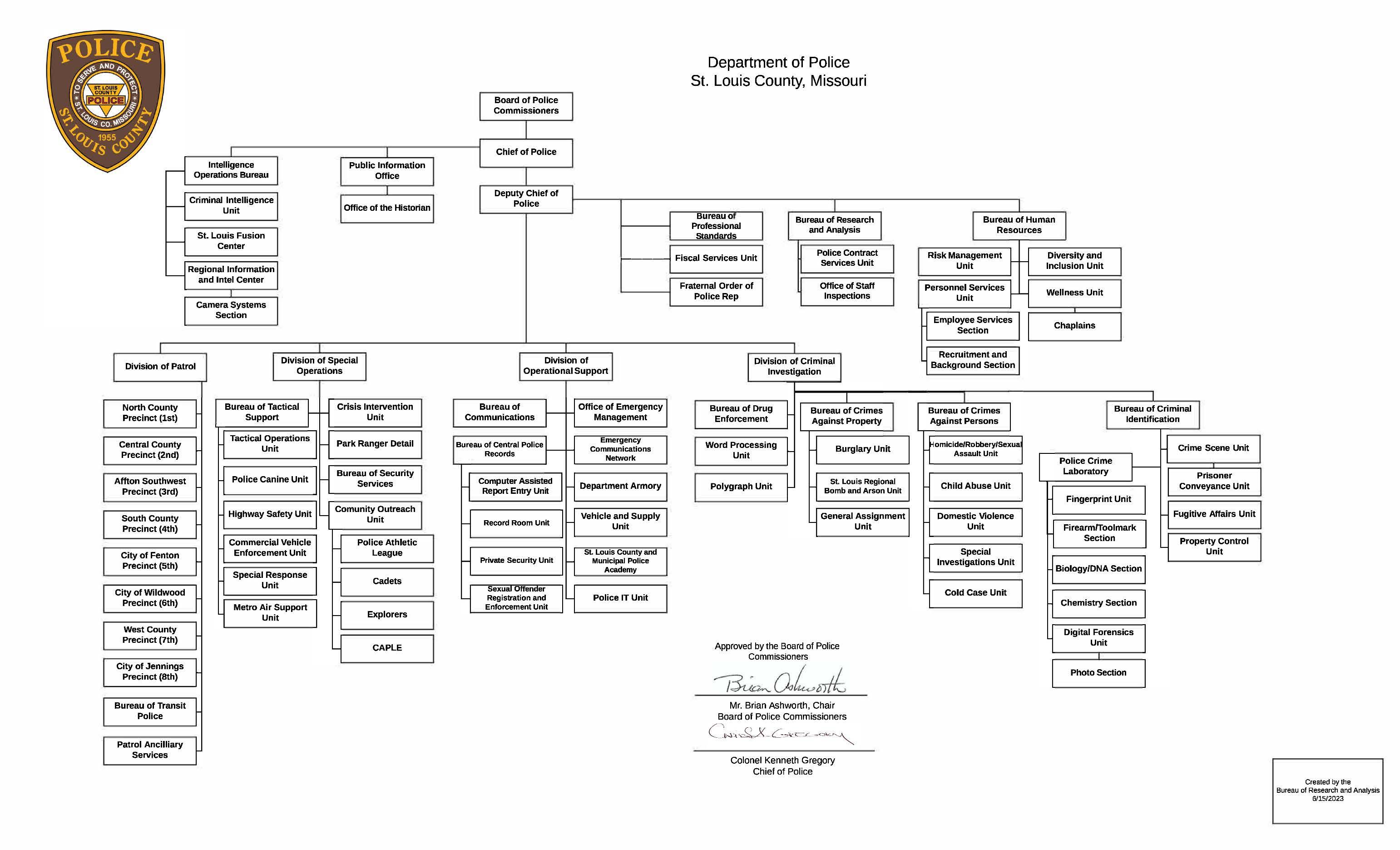

Prosecuting Attorney
Wesley Bell, Prosecuting Attorney
RECOMMENDED FY24 BUDGET
$15,435,428
OFFICE MISSION
FULL TIME EQUIVALENTS
141.2
The Prosecuting Attorney represents the citizens of St. Louis County by fairly and effectively prosecuting violations of state criminal statutes, promoting public safety, empowering victims of crime, and building a safe community for everyone. The Prosecuting Attorney’s Office promotes public safety by protecting the community from those who commit violence, providing pathways to treatment for people with substance use and mental health challenges, and establishing trust with the communities it serves
BUDGET OVERVIEW
The 2024 recommended budget for the Prosecuting Attorney is $15,435,428, an increase of $602,377 or 4.1 percent from the 2023 adjusted budget of $14,833,051 Personnel costs comprise 93.5 percent of the budget for 142 positions (141.2 full time equivalents). Operating and capital expenses account for the remaining 6.5 percent of the budget.
SIGNIFICANT CHANGES
The 2024 recommended budget includes a decrease of $695,163 for insurance costs, the elimination of $1,075,431 of turnover and hiring lag appropriation reductions that were included in the 2023 budget, and the addition of $90,000 to replace two high-mileage vehicles.
CORE BUSINESS FUNCTIONS
The Prosecuting Attorney is responsible for the management of:
→ Warrant application process (to include review and charges)
→ Criminal Case Management from inception to closure
→ Traffic Case Management from inception to closure
→ Alternative Court Management (Drug Court, DWI Court, Mental Health Court, Veteran’s Court)
→ Diversion Program Management
→ Victim Services Management
→ Child Support Services
→ Taxes and Bad Check Collection
→ Community Engagement
→ Grand Jury hearings and administration
Conviction Incident Review Unit
→ Operation of two satellite offices within local police departments
PROGRAM DESCRIPTIONS
Deferred Prosecution/Diversion
The Deferred Prosecution/Diversion division seeks to address low level non-violent offenders suffering from substance use disorders and issues relating to mental health. Rather than focus solely on conviction and incarceration, which lead to unemployment and tear families and communities apart, this division seeks to provide treatment and employment to individuals in need, primarily with little or no additional cost to taxpayers. If individuals in the program successfully complete the supervised program, they will not have a criminal conviction on their record.
Criminal Division
The Criminal Division prosecutes criminal traffic, misdemeanor, and felony cases. The felony cases enter the division through the warrant office and proceed through the Associate Circuit Trial Staff or the Grand Jury to the Circuit Trial Staff for prosecution. Attorneys, investigators, and support personnel staff in the criminal division. This division is particularly focused on addressing violent crime and drug addiction.
Community Engagement
The Community Engagement Division educates the community about the role of the prosecuting attorney’s office, reaches out to many different neighborhoods to learn about safety challenges and concerns, and participates with community events to build trust in the work of the office and encourage community members to work with the office to improve public safety.
Civil Division
The Civil Division collects child support, delinquent taxes, and bad checks. The division also files and handles asset forfeiture suits.
Victim Services Division
The Victim Services Division provides services to victims, including emotional support and crisis intervention, referrals to agencies, and informs victims about court hearings, orders of protection, victim impact statements and victim crime compensation. Advocates accompany victims to hearings and offer the use of victim accommodations in the courthouse.
Conviction Incident Review Unit
The Conviction and Incident Review Unit is an independent office within the St. Louis County Prosecuting Attorney’s Office, which investigates claims of innocence to determine whether there is compelling evidence that the convicted defendant was not the person who committed the offense of conviction, and to use available measures to right those wrongs. The unit also oversees the investigation of and prosecutes excessive force by law enforcement, public corruption, and official misconduct.
STRATEGIC PRIORITIES AND PERFORMANCE METRICS
• Successfully prosecute criminal cases investigated in St. Louis County (HS – Reform Criminal Justice)
• Advance and protect rights of victims, treating them with the dignity, respect, and compassion they deserve (O –Efficient and Responsible)
• Engage with the community openly and transparently (O – Efficient and Responsible)
• Effectively address violent crime, drug addiction and mental health (HS – Reform Criminal Justice)
• Sufficiently staff the office and warrant office (O – Improve Effectiveness)
• Advance and protect the rights of children by collecting child support through the civil contempt system (HS –Reform Criminal Justice)
• Promote the public welfare with respect to non-violent offenses by focusing on individuals maintaining employment, mental health, drug addiction and alternatives to incarceration (HS – Reform Criminal Justice)
• Modernize and staff the office to effectively address our priorities (O – Improve Effectiveness)
• Address cases involving those wrongly prosecuted, police and official misconduct and public corruption (HS –Reform Policing)
ORGANIZATIONAL CHART
CHAPTER SUMMARY
Recreation & Culture
(in thousands)
Public Safety
Highway Capital Program Health & Well‐Being
Recreation & Culture
General Government
Economic Development & Infrastructure
Department of Parks & Recreation
Brian Schaffer, DirectorRECOMMENDED FY24 BUDGET
$39,192,993
DEPARTMENT MISSION
FULL TIME EQUIVALENTS
321.3
The Department of Parks and Recreation provides high quality parks, facilities, and recreation services that enhance residents’ lives through responsible and effective management of resources.
BUDGET OVERVIEW
The 2024 recommended budget for the Department of Parks & Recreation is $39,192,993, an increase of $923,830 or 2.4 percent from the 2023 adjusted budget of $38,269,163. Personnel costs comprise 51.2 percent of the budget for 463 positions (321.3 full time equivalents). Operating and capital expenses account for the remaining 48.8 percent of the budget.
SIGNIFICANT CHANGES
The 2024 recommended budget includes $121,854 for the one-time startup cost for ranger body cameras, $1,494,550 for vehicles and capital equipment replacements, $300,000 to renovate the Visitor Center at Jefferson Barracks, and $150,000 for the Greensfelder Recreation Complex for the Midwest Sport Hockey entrance and parking
CORE BUSINESS FUNCTIONS
The Department of Parks & Recreation is responsible for the management of:
→ 68 parks with 11,400 acres
→ 7 recreation complexes
→ 6 historical/cultural sites
→ 166 miles of trails
→ 65 athletic fields
→ 44 playgrounds
→ 78 picnic shelters
→ 590 acres of lakes
→ 87 restroom buildings
→ 400 plus recreational programs annually
→ Citizen Volunteer Program
PROGRAM DESCRIPTIONS
Administration

The Administration Division provides support for all the departments financial and personnel functions through effective leadership and fiscal management as well as guiding information technologies, leases and marketing of programs and facilities within the department. The tracking of all purchases, invoices, submission of bid documents, human resources, revenue, and payroll are only some of the supportive functions of this division.
Strategic Priorities and Performance Metrics:
• Priority 1 (PR5.1): Provide a responsible, cost-effective, and valuable service to the public (GG - Efficient and Responsible)
• Priority 2 (PR5.2): Reduce vacancy rate for Park Personnel (GG - Improve Effectiveness)
2024 ALLOCATION OF RESOURCES
• Priority 3 (PR5.3): Provide a safe working environment (GG - Improve Effectiveness)





• Priority 4 (PR5.4): Effectively communicate Parks and Recreation programming to the public (GG - Efficient and Responsible)
Park Rangers
Park Rangers are responsible for visitor and resource protection, interpretive programming, and public relations. They provide public safety for park visitors through patrols on foot, ATV, or bicycle, answering complaints, issuing summonses for county ordinance violations, traffic citations and investigating incidents within the parks system. Park rangers prepare and present a wide variety of educational and recreational programs to enhance the public’s enjoyment of the resources that St. Louis County provides. They also support numerous department wide special events by providing security and traffic control for large numbers of attendees.
Strategic Priorities and Performance Metrics:

• Priority 1 (PR4.1): Providing a welcome, safe, and secure recreational experience (O - Improve Quality of Life)

Park Operations
The Park Operations Division operates, repairs, and maintains outdoor facilities (playgrounds, shelters, restrooms, athletic fields, etc.) and all grounds maintenance (prairies, trails, lakes, roads, parking lots, invasive species, etc.) of county parks divided into three geographic areas (North, Central/West and South) to ensure availability and safety for park visitors.
Strategic Priorities and Performance Metrics:
• Priority 1 (PR1.1): Improve satisfaction of park users (O - Improve Quality of Life)
• Priority 2 (PR1.2): Increase the # of park and trail users (O - Improve Quality of Life)
*Data used from Creve Coeur, Spanish Lake, and Bella Fountaine Parks
**Data used from Suson, Tilles, and Lone Elk Parks
Recreation
The Recreation Services Division manages all recreation complexes, historical/cultural sites, museum collections and the special usage of all county parks’ outdoor facilities and grounds. The division also operates and manages indoor facilities, recreation programs and cultural events and letters of agreement with outside organizations holding their events in the parks. The division is responsible for the management of volunteer, friends, and partnership programs.
Strategic Priorities and Performance Metrics:
• Priority 1 (PR2.1): Provide quality programs for a wide variety of people (GG - Improve Effectiveness)
• Priority 2 (PR2.2): Reduce operational costs through the use of volunteers (GG - Efficient and Responsible)
*Volunteer value per hour from The Independent Sector; 2020: $27.20 value per hour, 2021: $28.54 value per hour, 2022: $29.95 value per hour, 2023: $31.42 value per hour
Creve Coeur Park Soccer Complex
Creve Coeur Park Soccer Complex contains 13 synthetic turf fields, a “super pitch” natural grass playing space and a stand-alone championship field with permanent bleacher seating. In addition to the fields, the complex affords visitors ample concessions, restrooms, and lighted parking areas throughout. St. Louis County’s central location within the Midwest region has made Creve Coeur Park Soccer Complex a convenient destination for athletes and families from across the country. The complex regularly sees close to a million visitors a year as it is the site of more than 25-plus event weekends each year and the primary training home for numerous area youth soccer clubs.
Creve Coeur Park Soccer Complex is projected to host up to 30-weekend tournament events and more than 17,000 hours of field play in 2024. The year will again be highlighted by regional soccer events that bring participants from across the Midwest and beyond to St. Louis County to stay and play. US Youth Soccer is expected to return with one of its major summer championships for the fourth year in a row and will draw teams from across 13 Midwestern states, while the Missouri Youth Soccer Association will host its annual State Cup over two weekends in June for the seventh consecutive year.
Design & Development
The parks professional design staff plans, designs, and manages delivery of capital improvements, including facility upgrades and renovations. The group reviews and issues land use agreements and easements and assists with regulatory compliance and permitting. The primary function of this group is to manage all the capital improvement projects within the Parks Department and provide technical support to park staff and trades sections.
Strategic Priorities and Performance Metrics:
• Priority 1 (PR3.1): Fund the renovations identified in the Vision 2030 Master Plan (GG - Efficient and Responsible)





CHAPTER SUMMARY
Department of Administration
Karen J. Aroesty, DirectorRECOMMENDED FY24 BUDGET
$16,065,296
DEPARTMENT MISSION
FULL TIME EQUIVALENTS
135.8
The Department of Administration promotes the vision and values of St. Louis County government by facilitating the effective delivery of services and providing leadership and support to county departments while ensuring efficient use of resources for county residents.
BUDGET OVERVIEW
The 2024 recommended budget for the Department of Administration is $16,065,296, an increase of $1,193,061 or 8.0 percent from the 2023 adjusted budget of $14,872,235. Personnel costs comprise 72.2 percent of the budget for 138 positions (135.8 full time equivalents). Operating and capital expenses account for the remaining 27.7 percent of the budget. The budget also includes the elimination of $779,777 in turnover and hiring lag appropriation reductions that were included in the 2023 budget.
SIGNIFICANT CHANGES
The 2024 recommended budget includes nearly $900,000 for consulting services to improve the efficiency of the County’s Enterprise Resource Planning System. The budget was reduced by $200,000 to remove funding for training initiatives funded in 2023 but not yet begun and $158,000 for 2 data analyst positions that were eliminated. Finally, the budget includes the elimination of $779,777 of turnover and hiring lag appropriation reductions that were included in the 2023 budget.
PROGRAM DESCRIPTIONS

Fiscal Management
Fiscal Management is responsible for countywide financial reporting, publication of annual financial reports and coordination of audits. The division also oversees payroll, accounting functions, and grant management and compliance.
Strategic Priorities and Performance Metrics:
• Priority 1 (AD3.1): Provide guidance and research to departments/offices on how to effectively and efficiently manage grant funds and ensure overall grant compliance (GG - Efficient and Responsible)
• Priority 2 (AD3.2): Create financial accountability and transparency to our citizens by providing efficient central accounting services (GG - Constituent Experience)
• Priority 3 (AD3.3): Provide accurate and timely payments that exceed regulatory guidelines (GG - Efficient and Responsible)
vendor invoices approved and paid within 4 business days




Performance Management and Budget
Performance Management and Budget administers budget development and supervision of the county budget, bond issuance and compliance, debt management, performance improvement and tracking. The division also supports data research, development, and presentations internally and for county residents.

Strategic Priorities and Performance Metrics:
• Priority 1 (AD1.1): Develop a culture of data-informed decision making and continuous improvement, resulting in more efficient and effective services (GG - Improve Effectiveness)
• Priority 2 (AD1.2): Lead the county’s budget and financial plan development, execution, and monitoring activities (GG - Improve Effectiveness)
• Priority 3 (AD1.3): Improve data governance and transparency across St. Louis County (GG - Improve Effectiveness)
core departments reporting performance data for at least one metric for every priority
Procurement
Procurement supports purchasing county-wide, administers the Office of Minority/ Women-Owned Business Development and enforces prevailing wage standards.
Strategic Priorities and Performance Metrics:
• Priority 1 (AD9.1): Develop processes and structures to make purchasing goods and services for the county efficient, understandable, and accurate for both end-users and vendors (GG - Efficient and Responsible)
• Priority 2 (AD9.2): Minimize paperwork and streamline online access to required forms (GG - Constituent Experience)
Risk Management
Risk Management protects county assets, people, and capital by managing risk, insurance, safety, and emergency management programs.
Strategic Priorities and Performance Metrics:
• Priority 1 (AD4.1): Provide education, reminders, and assistance to departments to increase health and workplace safety and prevent incidents (GG - Efficient and Responsible)
• Priority 2 (AD4.2): Streamline risk management reporting and investigation process to mitigate high financial impact (GG - Improve Effectiveness)
Personnel
The Personnel Division engages on all human relations issues for county staff including benefits, retirement plans, EEO matters and countywide education on personal and professional development with a goal to foster belonging, justice, and equity.
Strategic Priorities and Performance Metrics:
• Priority 1 (AD10.1): Transform Human Resources (HR) to optimize processes, improve service quality, reduce costs, and increase employee satisfaction (GG - Improve Effectiveness)
• Priority 2 (AD10.2): Cultivate a positive, fulfilling, and engaging employee experience (GG - Improve Effectiveness)
75% x X - indicates forecast not complete at time of publishing
Retirement plan funded ratio (Ratio is based on actuarial value.)
Treasury
The Office of the Treasurer oversees financial investments for the County, the administration of municipal sales taxes, county banking relationships and cashiering staff.
Strategic Priorities and Performance Metrics:
• Priority 1 (AD2.3): Build capacity to better operate as the fiduciary agent between St. Louis County and municipalities (GG - Efficient and Responsible)
• Priority 2 (AD2.1): Maintain the highest of fiduciary obligations in the management of cash and all financial systems with significant attention towards early warning systems that could indicate any financial irregularity countywide (GG - Efficient and Responsible)
• Priority 2 (AD2.2): Develop high-quality cash control and management processes with targeted education across county departments (GG - Efficient and Responsible)
Records Management
The Records Center provides archiving and destruction, imaging services and document management for all county departments in accordance with state statutes and county ordinances.
Strategic Priorities and Performance Metrics:
• Priority 1 (AD7.1): Maintain a high standard of record and document retention to increase records management efficiency and create a positive environmental impact (GG - Efficient and Responsible)
• Priority 2 (AD7.2): Improve the ease of accessibility and transparency for staff and residents (GG - Constituent Experience)
General Services
General Services oversees all mail and courier services, including Central Receiving for distribution to all county facilities.
Strategic Priorities and Performance Metrics:
• Priority 1 (AD8.1): Provide consistent and accurate services to county government offices with a high level of staff professionalism (GG - Efficient and Responsible)
CAPS (County Administrative Processing System)
CAPS handles integrated electronic financial, procurement and HR systems including support services for all county staff.
Strategic Priorities and Performance Metrics:
• Priority 1 (AD5.1): Provide strong management, maintenance, education, and support of the financial and human resources needs for the county (GG - Efficient and Responsible)
• Priority 2 (AD5.2): Modernize systems and innovate structural approaches (GG - Efficient and Responsible)
















Customer Service 311
Customer Service 311 is the central information hub for County residents to receive answers to general questions as well as connections to county departments for more specific needs.
Strategic Priorities and Performance Metrics:
• Priority 1 (AD6.1) Consistently provide a reliable, accessible, and citizen-focused customer service experience to exceed citizen’s expectations (GG - Efficient and Responsible)
CHART
Assessor
RECOMMENDED FY24 BUDGET
$18,085,245
OFFICE MISSION
FULL TIME EQUIVALENTS
186.3
The mission of the Assessor’s Office is to fairly and accurately assess all real and personal property in the county, in accordance with applicable law and professional appraisal practice, and to provide excellent customer service.
BUDGET OVERVIEW
The 2024 recommended budget for the Office of the Assessor is $18,0805,245, an increase of $689,560 or 4.0 percent from the 2023 adjusted budget of $17,395,685. Personnel costs comprise 69.9 percent of the budget for 209 positions (186.3 full time equivalents). Operating and capital expenses account for the remaining 30.1 percent of the budget.
SIGNIFICANT CHANGES
The 2024 recommended budget includes a reduction of $278,000 for items such as postage, printing, public notices, automobile allowance, and office supplies due to 2024 being a non-reassessment year.
CORE BUSINESS FUNCTIONS
The Office of the Assessor is responsible for the management of:
→ The accurate and timely classification and valuation of all real property and all tangible personal property in St. Louis County
→ The performance of all administrative functions of the two Boards of Equalization
→ The review of all petitions for tax-exemptions of tangible personal property and real property, and submission of recommendations regarding the same to the Boards of Equalization
→ The production and updating of official St. Louis County real estate information, including locator maps and maps containing parcel boundary lines
→ The maintenance of current records regarding real estate title transfers and related plats, and certificates of value
→ Timely, accurate and customer-friendly public service by providing property values and reassessment information
Jake Zimmerman, County Assessor CountyPROGRAM DESCRIPTIONS
Real Property
The Real Property Division is responsible for establishing the fair market value of approximately 400,000 residential and commercial real estate tax parcels. Missouri law requires that real estate be reassessed every two years (in oddnumbered calendar years). To ensure that county records accurately reflect the value of a property, appraisers physically inspect every residential property whose value increases by more than 15 percent from the prior reassessment. Additionally, every parcel of real property receives a physical inspection at least once every six years, and appraisers physically re-inspect any property if a request is made by the property owner.
Personal Property
The Personal Property Division is responsible for annually establishing the fair market value of all tangible personal property. For individuals, personal property includes approximately 915,000 vehicles of all types, including automobiles, motorcycles, campers, trailers, boats, personal aircraft, and off-road vehicles; it also includes livestock and agricultural equipment. For approximately 559,000 accounts of all types, personal property includes all tangible personal property, and equipment located in St. Louis County on January 1. All valuation is in accordance with the requirements of Missouri law:
• Values for vehicles and most other types of personal property are set according to the National Automobile Dealers Association (NADA) and similar guidelines
• Livestock and agricultural crop values are based on schedules issued by the State Tax Commission (STC); Tangible personal property is classified by type and original costs and is depreciated in accordance with statutory schedules
Administrative Services
The Administrative Services Division is responsible for managing the systems, applications, and databases necessary for assessment and taxing functions. The services provided include the following:
• Maintaining “baseline” information used to produce maps and other vital assessment applications such as aerial imagery, addresses, and parcel and taxing district boundaries
• Producing and updating St. Louis County real estate information, including locator maps and all maps containing parcel boundary lines
• Maintaining current and accurate records regarding real estate title transfers, and related plats and certificates of value
• Performing clerical functions essential for assessment including data entry, document scanning, and maintenance of accurate records of various types
Boards of Equalization
In 2021, a second Board of Equalization was created. At the direction of the Boards’ members, the Assessor’s Office now provides a full range of year-round administrative support to both Boards. This is necessary for the fair and efficient functioning of the Boards. The Boards are independent bodies: their members are appointed by the County Executive and are approved by the County Council, and they report directly to the Director of Revenue. Fiscal year 2024 is not a reassessment year. The staff anticipates handling approximately 1,200 appeals of all types to the Boards.
STRATEGIC PRIORITIES AND PERFORMANCE METRICS
• Continuously improve the accuracy of property valuation (HS – GG – Efficient and Responsible)
• Continue converting critical functions to a completely paperless process (GG – Constituent Experience)
• Upgrade public data portals and promote public use of the same (GG – Constituent Experience)
• Provide enhanced training to appraisal professionals and other staff (GG – Improve Effectiveness)
*Each reassessment year (every odd-numbered calendar year), the State Tax Commission (STC) employs ratio studies to measure the accuracy of assessed values set by each county assessor’s office in Missouri. The International Association of Assessing Officers – an international professional organization that sets standards for assessment methodology – has established a 15% coefficient of dispersion (COD) as the threshold standard for ratio study results; numbers higher than 15% are considered less accurate while those lower than 15% are considered more accurate.
ORGANIZATIONAL CHART
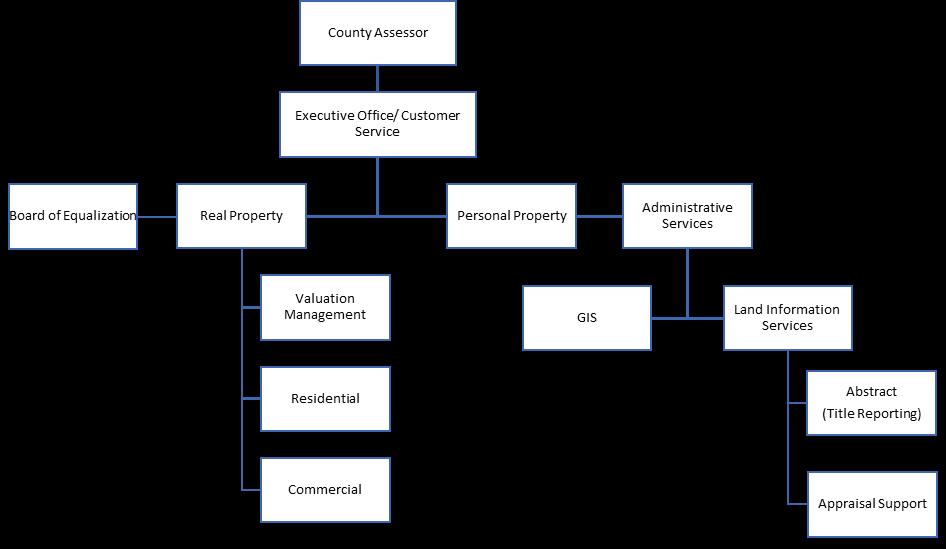
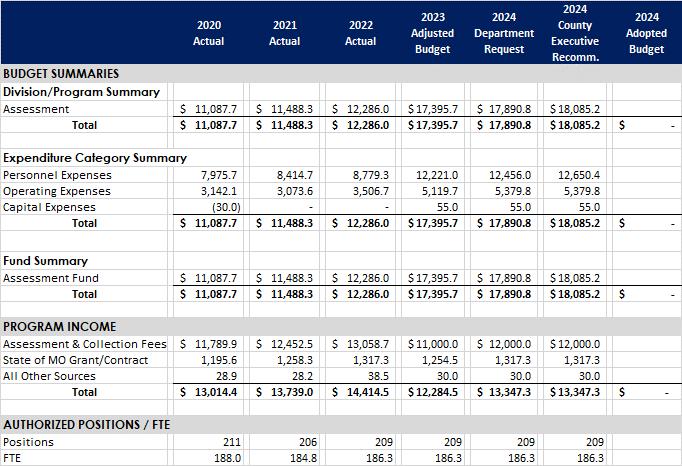
County Council
L. Valenti, Administrative Director
RECOMMENDED FY24 BUDGET
$2,946,777
OFFICE MISSION
FULL TIME EQUIVALENTS
30.0
The mission of the St. Louis County Council is to provide the highest standard of transparency in government and enable greater access to government proceedings and records for all St. Louis County citizens. The St. Louis County Council is the elected legislative body of the county and exercises all powers as set forth in Article II of the St. Louis County Charter, as well as all other powers set out in laws related to county commissions not superseded by the Charter. The administrative component of the County Council includes the offices of County Council Administration, County Clerk, and County Auditor.
BUDGET OVERVIEW
The 2024 recommended budget for the Office of the County Council is $2,946,777, an increase of $420,121 or 16.6% percent from the 2023 adjusted budget of $2,526,657. Personnel costs comprise 80.3 percent of the budget for 31 positions (30.0 full time equivalents). Operating and capital expenses account for the remaining 19.7 percent of the budget.
SIGNIFICANT CHANGES
The 2024 recommended budget includes $35,000 to provide each Council District with the option to send traditional mailings to county residents, and an increase of $47,763 for external accounting firm fees for county independent audits. The budget also includes the elimination of $738,931 of turnover and hiring lag appropriation reductions that were included in the 2023 budget.
CORE BUSINESS FUNCTIONS
The Office of the County Council is responsible for:
→ Providing public records requested by county departments while conducting county business and as requested by the public
→ Processing various petitions that are filed with the County Clerk for appropriate action as prescribed by law
→ The scheduling and live streaming of the weekly Council meetings and Council committee meetings, and recording of meetings for viewing on the county website
→ Producing and posting notice of all Council meetings and hearings as prescribed by law
→ Processing Notary Public commissions for the State of Missouri
Diann→ Administering oaths of office to various board and commission appointees as well as county employees

→ Conducting the internal audit function of county operations
→ Monitoring the St. Louis County Fraud and Financial Concerns Hotline for anonymous reporting of fraud, waste, mismanagement, or misconduct by employees and residents
→ Managing the repository of the permanent record of all ordinances, resolutions, orders, and Council agendas and journals and other records in compliance with the Records Retention Schedule
PROGRAM DESCRIPTIONS
County Council Administration
The County Council appoints the Administrative Director/County Clerk and Budget Policy Coordinator for the office. The Administration assists the Council to perform its legislative duties in county government and is a resource for detailed records regarding Council business for the citizens of St. Louis County and county departments.
County Clerk
The County Clerk’s Office, under the direction of the Council Administrative Director/County Clerk and the Chief Deputy County Clerk, prepares the agendas and journals for the County Council, curates the repository of the permanent records of County Council business and those as prescribed by county ordinance and Missouri state statutes. The office also provides copies of ordinances and other records requested by the public and other governmental entities, and performs other duties as prescribed by county ordinances and Missouri state statutes.
County Auditor

The County Auditor is appointed by the County Council. The Auditor’s Office provides an independent, objective internal audit function, designed to add value, and improve county operations by evaluating and improving the effectiveness of risk management, internal controls, and governance processes. The Auditor’s office assists and partners with the external independent auditors in the performance of evaluating St. Louis County’s financial statements and other audit activities. The Auditor’s office also manages the St. Louis County Fraud and Financial Concerns Hotline which allows employees and residents to anonymously report fraud, waste, abuse, and corruption.
STRATEGIC PRIORITIES AND PERFORMANCE METRICS
• Provide administrative support to the Council members, professional and timely assistance to county departments, and excellent customer service to the public (GG – Efficient and Responsible)
• Administer Notary Public commissions and renewals, oaths of office for Boards and Commission appointments, and to various county employees (GG – Efficient and Responsible)
• Curate the repository of the peromanent record of all ordinances, resolutions, and orders, provide copies of ordinances and other records requested by the public and other governmental entities (GG – Efficient and Responsible)

• Provide timely response to requests for records in full compliance with the Missouri Sunshine Law and all other applicable statutes and ordinances (GG – Efficient and Responsible)

• Continue implementation of automated processes to expand and improve internal efficiencies and external access and transparency (GG – Efficient and Responsible)
• Provide quality video streaming and recordings of all Council meetings for viewing by the public (GG – Efficient and Responsible)
ORGANIZATIONAL CHART
County Counselor
RECOMMENDED FY24 BUDGET
$5,700,688
OFFICE MISSION
FULL TIME EQUIVALENTS
44.1
The Office of the County Counselor conducts the civil law business of the county, assisting county government in carrying out its policies and operations in an efficient and legally appropriate manner by providing advice, counsel and representation to county departments, offices, boards, commissions, and employees, including elected and appointed officials.
BUDGET OVERVIEW
The 2024 recommended budget for the Office of the County Counselor is $5,700,688, an increase of $74,432 or 1.3 percent from the 2023 adjusted budget of $5,626,256. Personnel costs comprise 88.9 percent of the budget for 46 positions (44.1 full time equivalents). Operating and capital expenses account for the remaining 11.1 percent of the budget.
CORE BUSINESS FUNCTIONS
The County Counselor is responsible for the management of:
→ Representing, in the name and on behalf of the county, all civil suits and other proceedings at law or in equity requisite or necessary to protect the rights and interests of the county and enforcing any and all rights, interests or claims against any and all persons, firms or corporations in whatever court or jurisdiction such action may be necessary.
→ Prosecuting all proceedings for the collection of delinquent taxes and licenses of every kind owing to the county and violations of county ordinances including related to problem properties, domestic relations, and traffic.
→ Preparing and/or approving as to form all leases, deeds, contracts, bonds, ordinances, rules, regulations, drafts of legislation, and other instruments.
→ Providing legal advice and opinions to the council, the County Executive, department heads, elected officials, and to all county boards and commissions, respecting county business.
Dana Redwing , County CounselorSTRATEGIC PRIORITIES AND PERFORMANCE METRICS
• Improve efficiency and continuity of service with technology, including the case management system and eDiscovery system (GG - Efficient and Responsible)
• Maintain staffing of the office to maintain efficiency of services offered to county departments and offices (GGImprove Effectiveness)
ORGANIZATIONAL CHART
County Counselor
Deputy County Counselor
Legislative
Draft Legislation
Opinions for Council
Executive Contracts, Boards & Commissions, Sunshine
Administrative Personnel, Opinions, Labor, Bonds
Litigation, Tax and Comp
Municipal Court Prosecution
Community Compliance (Problem Properties)
Judicial
Court Regulatory Compliance
County Executive
RECOMMENDED FY24 BUDGET
$6,979,510
OFFICE MISSION
FULL TIME EQUIVALENTS 51.0
The County Executive is the Chief Executive Officer, elected by the voters of St. Louis County to a four‐year term of office, with all executive powers, responsibilities, and duties enumerated within Article III of the St. Louis County Charter, which include directing, coordinating and monitoring the activities of all county administrative units under the County Executive’s control; appointing administrative heads of departments; approving and executing contracts and agreements for the county as authorized; directing the creation of the annual budget; maintaining communications with federal, state and local governments; and directing special projects requiring coordination among county departments.
BUDGET OVERVIEW
The 2024 recommended budget for the Office of the County Executive is $6,979,510, an increase of $628,099 or 9.9 percent from the 2023 adjusted budget of $6,351,412. Personnel costs comprise 92.0 percent of the budget for 53 positions (51.0 full time equivalents). Operating and capital expenses account for the remaining 8.0 percent of the budget.
SIGNIFICANT CHANGES
The 2024 recommended budget includes the continued Proposition A (passed in April of 2023) consolidation of department non‐merit appointees’ costs such as subscriptions, cell phones, software, travel, and memberships. The budget also includes the elimination of $429,548 in turnover and hiring lag appropriation reductions that were included in the 2023 budget.
CORE BUSINESS FUNCTIONS
The St. Louis County Executive is responsible for the management of:
→ The proper and efficient administration of the county
→ Appointing department directors and members of boards and commissions
→ Employing experts and consultants in connection with any of the functions of the county
→ Coordinating and supervising the work of the departments and agencies of the county to promote efficiency and economic growth
Sam Page, County Executive→ Executing and enforcing the provisions of the County Charter, the laws of the State of Missouri pertaining to the government of the county, and the ordinances, resolutions, orders, and policies of the council and seeing that all contracts with the county are faithfully performed
→ Attending regular meetings of the County Council and participating in discussions without vote
→ Recommendations to the council to improve the county government and the general well‐being of the people and submitting to the council an annual report of the affairs of the county
→ Promoting and encouraging cooperative relationships between the county and the political subdivisions within the county in matters relating to land use planning, public health, sewers, parks, safety, public welfare, and all other governmental functions in which the people of St. Louis County could gain through better cooperative arrangements
→ Examining any payroll, account, demand or claim against the county and having access to all county books, records and papers kept by county officers and employees
→ Representing the county and performing other duties per the County Charter
→ Establishing by executive order from time‐to‐time systems of administrative organization in the departments
→ Submitting to the council for approval by ordinance an annual balanced budget
→ Transforming County Government by improving constituent experience through increasing channels, access to data, and backend process that answer constituent questions
→ Redesigning shared services structure and operating model to drive efficiency and effectiveness throughout county government
→ Developing modern workspaces and optimize use of real estate
→ Increasing constituent services by optimizing the Community Outreach team to increase access to information, provide feedback and improve communications
PROGRAM DESCRIPTIONS
Communications
The Communications staff are responsible for messaging on behalf of St. Louis County internally and externally. The Communication staff create and disseminate timely and accurate messages within the community by working closely with Department Directors to elevate the work of St. Louis County.
Community Outreach
The Outreach Team leads the planning and execution of engagement and outreach actions and activities with the St. Louis County community. The team manages the umbrella engagement of stakeholders (both internally and externally) in opportunities to support the St. Louis County’s goals. The team designs and activates programming with organizations like affinity groups, churches, seniors, disability groups, culturally diverse groups, and labor unions. The goal is to provide access to resources to improve the quality of life and empower St. Louis County residents. The Outreach Team uses community input and feedback to inform decisions as appropriate. Additionally, the guidance in the development of rules, policies, and procedures of the Minority and Women Owned Business (MWBE) program, as well as Business Advisory Council, is a critical function of this team.
Department Directors
Department Directors represent the senior staff of the operating departments which are a cohesive body, aligned and resourced to accomplish the County Executive’s goals. The staff are change agents, driving operational transformation aimed at improving customer service, maximizing operational efficiency and cost‐effectiveness, and fostering employee workplace satisfaction.
Policy
The Policy staff lead the advancement of the County Executive’s policy priorities by delivering an integrated approach to policy development and external engagement. The staff are engaged with government relations, regulatory affairs, board and commissions and public policy operations. They conduct research and assist with key policy initiatives and writing reports and briefing materials.
STRATEGIC PRIORITIES
• Provide programmatic and administrative support for the American Rescue Plan Act including state appropriations such as the demolition of Jamestown Mall and implementation of a new Regional Information and Intelligence Center, a new combined Central County Precinct police station and property/evidence control facility and a training facility and range (O – Inclusive Development)
• Increasing workforce development programs through community partnerships. This is an investment in growing our economy and enhancing the prosperity and quality of life for all residents (O – Family-Sustaining Jobs)
• Remain focused on all aspects of public safety to ensure the quality of life our residents have come to enjoy and expect (O – Improve Quality of Life)
• Continue efforts of the Opioid Task Force including the St. Louis County Prescription Drug Monitoring Program and the county’s Opioid Action Plan by bringing new initiatives and programs to curb the growing abuse of opioids and deaths related to this epidemic. One example is increasing the availability of naloxone (commonly distributed under the brand name Narcan®) to the public. Naloxone will be available free of charge to the public and community groups at the John C. Murphy Health Center during regular business hours (HS – Curb Opioid Epidemic)
• Create vibrant communities by planning for the future through a comprehensive plan and investing in sustainability, while marketing St. Louis County as a place where possibilities can become reality through the creation of quality jobs, entrepreneurship, innovation, and investment (O – Inclusive Development)
• Create and implement an Equity Agenda, a collaboration with community partners and stakeholders, with the goal to improve policies and programs for low‐income residents (HS – Reduce Health Disparities)
ORGANIZATIONAL CHART
County Executive
Chief of Staff
Chief Communications Officer
Community Outreach
Communications Team
Chief Operating Officer
County Department Directors
Policy Team
Board of Election Commissioners
Eric Fey, Director and Rick Stream, DirectorRECOMMENDED FY24 BUDGET
$11,493,499
DEPARTMENT MISSION
FULL TIME EQUIVALENTS
78.5
The St. Louis County Board of Election Commissioners (BOEC) is a bipartisan, independent body established by the State of Missouri, whose mission is to protect the integrity of the voting process by accurately, securely, and efficiently conducting all elections in St. Louis County.
BUDGET OVERVIEW
The 2024 recommended budget for the Board of Election Commissioners is $11,493,499 an increase of $1,514,604 or 15.2 percent from the 2023 adjusted budget of $9,978,894. Personnel costs comprise 50.0 percent of the budget for 83 positions (78.5 full time equivalents). Operating and capital expenses account for the remaining 50.0 percent of the budget.
SIGNIFICANT CHANGES
The 2024 recommended budget includes an increase of $3,200,000 for State and County elections, a decrease of $93,502 for the biennial canvass, and a decrease of $1,750,000 for the one-time cost of poll pad replacements in 2023 The budget also includes the elimination of $887,434 in turnover and hiring lag appropriation reductions that were included in the 2023 budget.
CORE BUSINESS FUNCTIONS
The Board of Election Commissioners is responsible for the management of:
→ Administering secure and accurate elections in accordance with state and federal laws and regulations
→ Processing voter registrations and maintaining a database of St. Louis County registered voters
→ Recruiting and training election judges to staff polling places
→ Coordinating access to public and private facilities across St. Louis County to serve as polling places
→ Facilitating absentee voting for military and overseas voters, hospitalized persons, nursing home residents, and county voters who cannot vote in person on Election Day
→ Providing accurate and timely information to voters and the public through multiple communication methods
→ Creating and maintaining maps for townships, municipalities, school, fire, and library districts, and other federal, state, and local jurisdictions
→ Verifying voters’ signatures on initiative and referendum petitions
PROGRAM DESCRIPTIONS

Election Administration
The Board of Election Commissioners (BOEC) administers elections for Missouri’s largest electorate and most complex jurisdiction, with more than 700,000 registered voters and 324 separate voting jurisdictions. Missouri state law provides that elections may be held in the months of February, March, April, August, and November on the first Tuesday after the first Monday except for March. The BOEC uses electronic poll books and state of the art voting equipment with on-demand paper ballots which give St. Louis County voters the choice to vote at any polling place in the county. The BOEC strives to leverage technology and innovation to improve the voting experience and uses a variety of digital and software solutions to enhance performance and efficiencies. By law, the BOEC is required to account for all costs for a given election and charge proportionally to participating entities based on the number of registered voters.

Voter Registrations and Mailing Lists

New voter registrations and updates to existing registrations, such as name and address changes, are processed through the BOEC office. The BOEC partners with municipalities, local libraries, high schools, social service organizations, and Missouri Department of Revenue license offices to provide voter registration services. All registrations must be complete within seven days of receiving the application. As of August 2023, there were 641,399 registered voters in St. Louis County. The names and addresses of registered voters in any given district in St. Louis County can be obtained upon request. These lists are available at cost in either electronic or paper format.
Election Judge Recruitment and Training


Election judges play a critical role in the election process and the BOEC employs considerable effort in their recruitment, training, and management. Any given election may employ 1,400 – 2,800 election workers to staff 200 or more polling places. Election judges are paid, must take training courses, and are required to pass a competency test. Training is offered in a variety of ways, including in-person and virtually. In the last general election year, the BOEC trained over 7,600 election workers. To manage this large workforce, the BOEC uses poll worker management software for communication and contacts, payroll, and worker access to training materials and videos.
Election Day Polling Places
The BOEC is responsible for securing the use of public and private facilities to provide an average of 230 polling places for a countywide election. Under Missouri law, tax-supported buildings must be made available as polling places and the rental of private facilities is also allowable. Given the size and diversity of St. Louis County, the BOEC uses technology to survey, assess, document, and manage all these facilities, including the use of geo-spatial and poll location management software. Additionally, St. Louis County voters can enter their address on the BOEC website and look up nearby polling places and their sample ballot. In a recent innovation, BOEC staff created a Line Tracker app to allow voters to see how many people are in line at each polling place throughout the day during an election.
Absentee Voting
In Missouri, voters who are unable get to their polling place on Election Day may vote absentee, in person or by mail, if they have a valid reason under the law. The BOEC facilitates absentee voting for military and overseas voters, and administers absentee for hospitalized persons, nursing home residents, and county voters who cannot vote in person on Election Day.
Military and Overseas Voters
Overseas voters, also called covered voters, have the option of registering to vote and/or requesting an absentee ballot for all elections. The covered voter needs to either complete a Federal Post Card Application (FPCA) or complete a registration application through the Secretary of State LiveBallot Portal. All applications received from a covered voter must be processed within two business days. Covered voters can request an absentee ballot until 5:00 pm the Friday before the election. The office must receive delivery of all electronic ballots from voters located in a hostile environment by 7:00 pm the night of the election (Portal, fax, or email). All mailed ballots must be postmarked by 12:01 am the day of the election and arrive in the elections office by noon the Friday following the election.
In Person and By Mail
Any voter that is unable to vote on Election Day with a valid excuse under Missouri law may request an absentee ballot at no cost to the voter. By law, absentee voting begins six weeks prior to an election and ends at 5 pm prior to Election Day. Voters may vote in person at the BOEC headquarters in St. Ann or at a satellite site, typically located in north, south, west, and central county. Voters may also drop off their ballot or mail their ballot to the BOEC after marking and inserting it in a signed and completed affidavit envelope. Under Missouri law, absentee ballots cannot be opened until five days prior to the election and are not tabulated until polls close on Election Day at 7 pm.
Communications
Communications play a vital role in educating voters and keeping the public informed of elections and voting processes. The BOEC uses multiple digital platforms, such as Twitter and Facebook, as well as traditional direct mailings and printed publications and materials to provide accurate, timely, and relevant information. The website, stlouiscountymovotes.gov, is a comprehensive resource for the public that includes election results, forms, maps, polling place information, and interactive lookups for voters.
Maps
The BOEC uses geographic information system (GIS) tools to create maps, as well as to gather, manage, and analyze data. Maps are available to the public for a variety of St. Louis County’s districts including congressional, state senate and representative, school, library, and fire, municipalities, townships, and other political jurisdictions. District maps are available in a variety of sizes for a nominal fee.
Initiative and Referendum Petitions
All petitions which involve districts in St. Louis County must be processed by the BOEC office. Staff must determine the validity of each signature submitted. The number of signatures on a petition may range from a few hundred on the local level to over 80,000 signatures on a statewide petition.
STRATEGIC PRIORITIES AND PERFORMANCE METRICS
• Maximize the use of Board of Elections voting equipment and technology to enhance and improve voter experience (GG – Constituent Experience)
• Inform and educate voters and the public by providing accurate, timely, and relevant communications (GG –Constituent Experience)
• Modernize and streamline elections operations, especially manual processes, through continuous improvement, innovation, and technology (GG – Efficient and Responsible)
• Attract, retain, and develop a talented workforce capable of delivering elections services at the highest professional standards (GG – Improve Effectiveness)
ORGANIZATIONAL CHART

Department of Information Technology
Will Reise, Acting Chief Information Officer
RECOMMENDED FY24 BUDGET
$13,481,163
DEPARTMENT MISSION
FULL TIME EQUIVALENTS
60.5
The mission of the Department of Information Technology (IT) is to partner with county departments, offices, agencies, and organizations to determine where and how information technology can be used to improve the services these teams deliver. The department is working to improve communication with residents through web-based technologies and to provide applications for county departments to create new operational efficiencies and communication improvements. The department will continue to focus on process automation allowing customers to access government services through the county’s websites at their convenience, using any device.
BUDGET OVERVIEW
The 2024 recommended budget for the Department of Information Technology is $13,481,163, an increase of $1,743,747 or 14.9 percent from the 2023 adjusted budget of $11,737,416 Personnel costs comprise 48.8 percent of the budget for 62 positions (60.5 full time equivalents). Operating and capital expenses account for the remaining 51.2 percent of the budget.
SIGNIFICANT CHANGES
The 2024 recommended budget includes $450,000 for new software for archiving and compliance maintenance and support and $200,000 for mobile device management The budget also includes the elimination of $1,060,448 of turnover and hiring lag appropriation reductions that were included in the 2023 budget.
CORE BUSINESS FUNCTIONS
The Department of Information Technology is responsible for the management of:
→ County website and internet-based communications
→ Email systems, databases, mapping, and other core applications
→ Network and server infrastructure
→ PC support
→ Custom applications
→ Cybersecurity
→ Voice systems and telecommunications infrastructure
→ Service management
→ Virtual Meeting Support
PROGRAM DESCRIPTIONS
Geospatial
Enterprise GIS manages the St. Louis County Geographic Information System (STLCGIS). St. Louis County’s cooperative, multi-department, GIS approach allows IT to focus on the specifics of the enterprise approach to GIS. It provides efficient, high-quality GIS leadership, coordination, infrastructure, and services to meet the business needs of our customers and clients in St Louis County Government.
Service Management / Automation
Service Management and Automation offers digital management services that provide online access to critical services both internally and externally. This offering also allows for enhanced process automation, allowing for efficient processing of customer requests both internally and externally. In addition, it connects all the processes to the county’s web presence allowing for multiple connection points for customers to engage in these services.
Remote Work Force Support / Hybrid Conference Rooms / Virtual Meetings
Remote Work Force Support provides technical support for a secure remote workforce for St. Louis County as well as hybrid conference rooms supporting both remote workers and in person collaboration. It offers a secure remote public meeting services via scheduled WebEx Events ensuring no interruptions of critical public communications on the operations of county government.
Application Development
Application Development is a team of software development professionals who create stunning modern, mobile first applications for operating systems or devices. In addition, they oversee the entire life cycle of a software application. The team designs and creates application code and tests the product for functionality and errors. In addition, the team must ensure other requirements are met, such as performance and security as well pieces of project management discipline.
Web Development
The Web Development Team is responsible for the coding, design, and layout of the county's public-facing website according to the county's standards and specifications. The team takes into consideration user experience and function, with a focus toward mobile first approach in both graphic design and user experience.
IT Business Analysis
IT Business Analysts engage with county leaders and users to understand how data-driven changes to processes, products, services, software, and hardware can improve efficiencies and add value. They must articulate those ideas and are responsible for bridging the gap between IT, county departments and offices. The IT Business Analysts use data analytics to assess processes, determine requirements, deliver data-driven recommendations and reports to leadership and development teams.
Infrastructure
The Infrastructure Team is responsible for managing the back-end computing environment for the county. This includes on premises servers and associated hardware, as well as cloud services which allows departmental, enterprise, and vendor solutions to operate on our network. The team is responsible for several county-wide enterprise systems such as data backups, software delivery, email, collaboration, and management systems that allow us to manage the workstation and server environments. The team also provides Tier 3 problem resolution support for all county users and after hours on call support.
Desktop Support
The Desktop Support Team is responsible for Tier 1 and Tier 2 problem resolution for all county users. The Help Desk is the first line resolution for technical support. The Help Desk provides technical assistance and support for incoming phone calls and emails related to computers systems, software, and hardware. The team is responsible for computer hardware maintenance and repair and software systems support. Services include technical support in the diagnosis
and resolution of complex software and hardware incidents, requests, and problems. Additionally, the team builds and deploys all new computer systems and is responsible for network cable terminations.
Information Security
The Information Security Team is charged with implementing technology and training needed to protect county government from cyberthreats. The team is responsible for reviewing data transmission and storage to verify technology and processes meet the regulations the county is required to adhere to. Information Security is the cornerstone of the county’s IT enterprise. Using the National Institute of Standards and Technology (NIST) cybersecurity framework as a guide, the county rebuilt its program over the past several years to address security gaps in all IT disciplines. Additionally, the Information Security team is responsible for the implementation and management of effectively administering the Cybersecurity Framework (CSF) security practices along with adherence to regulatory compliance requirements.
Network
The Network Team maintains the county’s enterprise networking infrastructure. The team ensures stable connectivity between the county’s disparate systems, locations, and remote connectivity. The team manages all wide area network circuits and provides Tier 3 support for all county users and after hours on call support.
Telecommunications
The Telecommunications Team oversees all aspects of telecommunications which includes the enterprise Voiceover Internet Protocol (VoIP) telephone systems, Call Center management and telecom circuits. The team also provides Tier 1 – Tier 3 telecom support for all county users and after hours on call support.
STRATEGIC PRIORITIES AND PERFORMANCE METRICS
• Priority 1 (IT1.1): Reduce the likelihood of an attack penetrating layered defenses (GG – Efficient and Responsible)
• Priority 2 (IT1.2): Minimize the possible damage done by a successful attack (GG – Efficient and Responsible)
• Priority 3 (IT1.3): Be able to rapidly recover from an attack (GG – Efficient and Responsible)
• Priority 1 (IT2.1): Improve resident and employee experience when consuming county services (GG – Efficient and Responsible)
• Priority 2 (IT2.2): Build capacity to track and generate metrics on all interactions (GG – Improve Effectiveness)
• Priority 3 (IT2.3): Develop the ability to push knowledge and self-service to reduce wait times and employee workload (GG – Improve Effectiveness)
• Priority 4 (IT2.4): Provide high quality internal customer service (GG – Constituent Experience)
• Priority 1 (IT3.1): Eliminate or replace hardware and software that introduces risks for support and security as well as systems that do not provide the functionality or data needed by the business unit (GG – Efficient and Responsible)
• Priority 2 (IT3.2): Make data contained in old systems available and accessible to other applications and dashboards (GG – Improve Effectiveness)
• Priority 1 (IT4.1): Map, analyze, optimize, and automate the most time-intensive processes (GG – Improve Effectiveness)
ORGANIZATIONAL CHART
Department of Revenue
Erica Savage, Acting DirectorRECOMMENDED FY24 BUDGET
$10,476,326 FULL TIME EQUIVALENTS
97.8
DEPARTMENT MISSION
The mission of the Department of Revenue is to provide quality, customer-centered information and services to taxpayers, licensees, and document recipients, in addition to obtaining and distributing funding to more than 200 publicserving agencies improving education, public safety, health, infrastructure and economic growth and opportunity in St. Louis County
BUDGET OVERVIEW
The 2024 recommended budget for the Department of Revenue is $10,476,326, an increase of $527,426 or 5.3 percent from the 2023 adjusted budget of $9,948,900. Personnel costs comprise 60.4 percent of the budget for 109 positions (97.8 full time equivalents). Operating and capital expenses account for the remaining 39.6 percent of the budget.
SIGNIFICANT CHANGES
The 2024 recommended budget includes continued funding for new Collection and Licensing software to automate and streamline tax collection, billing, distribution, tracking, reconciliation, reporting, licensing, and analytics for the Collector of Revenue and the Licensing Office The budget also includes the elimination of $434,782 of turnover and hiring lag appropriation reductions that were included in the 2023 budget.
CORE BUSINESS FUNCTIONS
The Department of Revenue is responsible for the management of:
→ Property tax billing, collection, and disbursement
→ The annual tax sale
→ Recording of deeds
→ Issuance of marriage licenses
→ Issuance of liquor, amusement, and miscellaneous licenses
→ Administration of the Trustee Program and Property Owner Advocate Program
→ Collection and distribution of convention, tourism, and sports taxes
PROGRAM DESCRIPTIONS

Collection Division



The Collection Division calculates, bills, and disburses more than $2 billion personal property, real estate property and railroad and utility taxes on behalf of more than 200 taxing authorities located in St. Louis County. The division delivers a centralized process that efficiently manages the receipt and distribution of funds. The division provides accurate and timely tax billing, processes and distributes tax collections and fees to school districts, municipalities, and other taxing authorities. The division collects sewer lateral and nuisance fees and conducts the annual tax sale. The division similarly facilitates sales, transfers of Post Third Sale Properties and provides personal property declarations services to property owners who want to change their address or update their personal property ownership status.
Strategic Priorities and Performance Metrics:
2024 ALLOCATION OF RESOURCES
• Priority 1 (RV1.1): Streamline and simplify processes to serve taxpayers better (GG – Efficient and Responsible)
• Priority 2 (RV1.2): Effectively and expeditiously manage the collection and disbursement of revenue (GG –Efficient and Responsible)
• Priority 3 (RV1.3): Improve amount of tax payments received (GG – Improve Effectiveness)
• Priority 2 (RV3.2): Increase online offerings for licensing services (GG – Improve Effectiveness)
• Priority 3 (RV3.3): Increase the collection of hotel taxes and gross receipts (GG – Improve Effectiveness)
Is anyone better off? (Effectiveness)
Recorder of Deeds
The Recorder of Deeds is responsible for records and filing documents affecting real property, subdivision plats, federal and state tax liens, and other legal documents. The division records and files military discharge documents, provides copies of deeds as requested, issue and provide official copies of marriage licenses. The division also offers the Property Fraud Alert program free of charge.
Strategic Priorities and Performance Metrics:
• Priority 1 (RV2.1): Improve document preservation process (GG – Efficient and Responsible)
• Priority 2 (RV2.2): Enhance Recorder of Deeds’ software platforms (GG –
Licensing Office
The Licensing Division issues various licenses for unincorporated St. Louis County areas, including a vast variety of amusement and miscellaneous licenses. The division issues liquor licenses for both unincorporated and incorporated areas and collects and distributes convention, tourism, and sports taxes.
Strategic Priorities and Performance Metrics:
• Priority 2 (RV3.2): Increase online offerings for licensing services (GG – Improve Effectiveness)
• Priority 3 (RV3.3): Increase the collection of hotel taxes and gross receipts (GG – Improve Effectiveness)
Director’s Office
The Director’s Office includes the Trustee Office, Accounting team and Custodian of Records. The office supervises the Collection, Recorder of Deeds, and Licensing Divisions. They administer the Property Owner Advocate Program and compensate the Board of Equalization (BOE) members, hearing officers and attorney. The Director of Revenue serves as the Trustee for delinquent tax properties that remain unsold after three consecutive years of being offered in the annual public auction. These properties are available for purchase from the Director’s Office. They also provide accurate up-todate information for all divisions to the public via website, signage, and brochures. The Office Service Coordinator serves as the Custodian of Records for the Department.
Strategic Priorities and Performance Metrics:
• Priority 1 (RV4.1): Restructure the department to hire, retain, and celebrate talent (GG – Improve Effectiveness)
• Priority 2 (RV4.2): Advance data access, usability, and analytics to inform decision making (GG – Efficient and Responsible)
ORGANIZATIONAL CHART
County Executive
Chief Administrative Officer
Director of Revenue
Deputy Director of Revenue
Recorder of Deeds Collection Division Licensing
Board of Equalization
Director's Office
RECOMMENDED FY24 BUDGET
$234,623,531
FULL TIME EQUIVALENTS
3.8
This section includes funding for the following activities which are not assigned to a specific county department/office:
University of Missouri Extension Center (General Revenue Fund)
The mission of the University of Missouri Extension is to improve Missourians’ lives by addressing their highest priorities through the application of research‐based education and resources. The extension provides programs in business development, horticulture, labor education, leadership training, workforce development, nutrition and health education, financial education, etc. St. Louis County’s funding is used to provide three support personnel and related expenses. The 2024 recommended budget for the extension is $231,221.
Special Projects (General Revenue Fund)
This division of the budget includes funding to support the county’s interest in various organizations, agencies, and activities. The 2024 recommended budget includes:
East‐West Gateway Council of Governments ($125,000)
The Council is an area‐wide planning agency which reviews requests for federal funds to be channeled into the metropolitan area.
Court Appointed Special Advocates (CASA) of St. Louis ($133,636)
CASA advocates for abused and neglected children in need of safe, permanent homes through highly trained volunteers appointed by the Family Court.
Elmwood Park Fire Protection ($130,000)
Provides funding for fire protection services in Elmwood Park via agreement with the City of Olivette.
Transportation Commission ($12,000)
Provides monthly stipends to members of the Transportation Commission.
Governmental Relations Consulting ($150,000)
Provides funding for a professional services contract to represent the county’s interests.
Memberships ($46,750)
Provides funding for countywide memberships, including the Missouri Association of Counties, National Association of Counties, Urban Sustainability Director’s Network, International Council for Local Environment Initiative, and National Center for Public Lands Counties.
Debt Service (General Revenue Fund)
This division of the budget includes appropriations necessary to make required debt service payments on special obligation bonds and tax anticipation notes. For more information on the county’s outstanding debt, please see the Debt Management chapter of this document. The 2024 recommended budget from the General Revenue Fund for debt service payments is $8,437,991.
Fire Standards Commission (General Revenue Fund)
The Fire Standards Commission establishes and provides minimum training and educational standards for firefighters, as mandated by the St. Louis County Charter. The commission also issues regulations for any person performing the duties of a firefighter for any municipality, fire protection district, or other public agency in St. Louis County. The 2024 recommended budget for the commission is $21,498. Note that the salary and fringe benefits for the two commission staff are budgeted in the Office of the County Executive.
Boundary Commission (General Revenue Fund)
The Boundary Commission is an independent commission established by state law which reviews proposed changes to boundaries of incorporated and unincorporated areas in St. Louis County. The commission is a separate entity and is not a part of St. Louis County government. However, the county is statutorily responsible for providing reasonable and necessary operational funding for the commission. The 2024 recommended budget for the commission is $251,114.
Emergency Fund (General Revenue Fund)
The Emergency “Fund” is a division of the budget used to set aside an amount not less than three percent of total estimated general income pursuant to Missouri statute. The County Council may, by resolution at any time upon recommendation of the County Executive, make transfers from the emergency fund appropriation account to any other appropriation account within the General Revenue Fund. Transfers may only be made for “unforeseen emergencies” and upon unanimous vote of the County Council. The 2024 recommended appropriation for the Emergency Fund is $7,402,928.
Debt Service Fund (1110)
This fund receives revenues from a dedicated property tax levy (currently 1.9‐cents per $100 of assessed valuation). Funds are used to make required debt service payments on general obligation bonds (Courthouse Project). The 2024 recommended appropriation for the fund is $6,819,575.
Transportation Trust Fund (5600)
This fund receives revenue from a half‐cent sales tax to be used for transportation purposes. The recommended appropriation of $40,911,926 represents estimated sales tax revenue to be distributed to Bi‐State Development (Metro). The remaining funds are allocated between county transportation operations and the highway capital construction program. Distributions beyond June 30, 2024 will be based upon County Council approval of a fiscal year 2025 (July‐June) budget for Bi‐State.
Public Mass Transit Fund (5620)
This fund receives revenue from a quarter‐cent sales tax (Prop M) and a half‐cent sales tax (Prop A) to be used for transportation purposes. The appropriation of $159,156,400 represents 100% of estimated sales tax revenue for future distribution to Bi‐State Development (Metro). Distributions beyond June 30, 2024 will be based upon County Council approval of a fiscal year 2025 (July‐June) budget for Bi‐State.
Lambert East Perimeter TIF Fund (5670)
This fund receives revenue associated with the Lambert Airport Eastern Perimeter Redevelopment Project. The 2024 recommended budget of $4,889,263 will be used to pay debt service costs (Series 2011A and Series 2021D/E).
Northpointe Forest Subdivision NID Fund (5840)
This fund receives revenue from a special assessment to the property owners of the Northpointe Forest Subdivision. The 2024 recommended budget of $35,870 will be used to pay debt service costs of the Northpointe Forest Water Project (Series 2009 A/B).
Residential Energy Loan Program Fund (5860)
This fund receives revenue from the repayment of loans from the St. Louis County Sustainable and Verifiable Energy Savings (SAVES™) Program, which financed residential energy efficiency and solar energy projects. This program is no longer accepting applications for new loans. The 2024 recommended appropriation of $183,420 will be used to pay debt service costs for the program (Series 2011 A/B).
Glencullen Subdivision NID Fund (5910)
This fund receives revenue from a special assessment to property owners in the Glencullen Subdivision. The 2024 recommended budget of $40,711 will be used to pay debt service costs associated with the Glencullen Subdivision Street Improvement Project (Series 2019).
Convention & Recreation Trust Fund (8630)
This fund is used to record revenue received from a 3.5% hotel‐motel tax used to fund debt service payments for the St. Louis Cardinals Ballpark Site and Ballpark Project (Series 2021), the Creve Coeur Soccer Complex (Series 2016 A/B), and the Convention Center Facility Project (Series 2022A). The fund will also pay $500,000 in the final “preservation payment” related to the Domed Stadium project. The 2024 recommended budget for the fund is $5,644,228.




DEBT MANAGEMENT
St. Louis County issues debt to fund capital improvements, achieve savings through refinancing and manage short‐term cash flow requirements. Instruments used include general obligation bonds, special obligation bonds, lease revenue bonds, and tax anticipation notes. On December 31, 2023, the county will have $449.6 million in principal outstanding.
Ratings issued for other debt types (special obligation bonds, tax anticipation notes, etc.) depend upon the details of each issue, however a recent special obligation issue was rated as AA, stable outlook.
GENERAL OBLIGATION BONDS
General obligation bonds are issued upon voter approval of specific purposes/projects and amounts. These bonds are backed by the full faith and credit of the county and are repaid by a dedicated property tax levy.
The Debt Service Fund is used to account for the redemption of general obligation bonds and payments of interest as well as fees payable to the banks involved as agents for the bondholders.
The county is currently rated as a AAA issuer for general obligation bonds by Moody’s and Fitch Ratings, and as an AA+ issuer by S&P Global Ratings. This rating reflects the county’s substantial tax base and role as the economic development hub for eastern Missouri and the St. Louis region, the long trend of healthy reserves and strong financial management, and low debt position.
The county has no new general obligation debt issues planned at this time.
DEBT SERVICE REQUIREMENTS BY YEAR
Very Low Bonded Debt
St. Louis County’s net bonded general obligation debt currently stands at 1.0% of the allowable limit. The county is limited by Sections 108.010 and 108.020 of the Missouri Revised Statutes to 10% of the assessed value of taxable tangible property. As of December 31, 2023, the county’s net bonded debt amounts to 0.10% of assessed value (AV), or $34.19 per capita.
Property Tax Levy
(Per $100 of assessed value)
The 2024 recommended property tax levy for the Debt Service Fund is reduced from 1.9 cents to 0.5 cents.
Legal Debt Margin as of 12/31/2023 (General Obligation Debt)
Assessed value $34,534,721,489 Limit of bonded indebtedness (10% of AV) $3,453,472,149
Bonded indebtedness (principal)$59,790,000
Less amount available in Debt Service Fund est. 12/31/23 (25,533,310) Net Bonded Debt applicable to debt limit $34,256,690
Percent of Debt Limit0.99% Legal Debt Margin$3,453,472,149


SPECIAL OBLIGATION BONDS
Special obligation bonds do not require voter approval and are secured by the county’s pledge to annually appropriate sufficient funds for debt service.
There are 17 series of special obligation bonds currently outstanding which are serviced by appropriations in annually budgeted funds,
summarized below. The debt service payments for these bonds are included in the operating budget of the relevant funds. Outstanding principal as of 12/31/2023 is $347.1 million.
The County has no additional special obligation bond issues planned at this time.
LEASE REVENUE BONDS
The county has one series of annual appropriation lease revenue bonds outstanding.
OTHER DEBT
The county has four additional transactions that do not fit into the categories listed above (excluding equipment financing agreements)
TAX ANTICIPATION NOTES
From time to time, the county issues short‐term Tax Anticipation Notes (TANs) for cash flow purposes. The last TAN borrowing was repaid in December 2021 and there is no balance
outstanding. The county will consider a new TAN program when necessary.
CAPITAL IMPROVEMENT PROGRAM
The county’s Capital Improvement Program (CIP) details capital projects included in the 2024 recommended budget as well as those under consideration for funding each year through 2028.

The first year of the CIP is included in the appropriation request unless supported by bond proceeds, grants, another funding source not included in the annual budget submitted to Council. The remaining four years of the CIP lists the capital projects identified for implementation and their estimated cost. Each year, the list of projects is reviewed for need and cost. The CIP is not a commitment of funds for future years.
CIP PLANNING CYCLE
The development of the CIP is a continuous process which attempts to compile, review, analyze, and justify information from numerous sources to forecast future capital needs. County departments are constantly working to identify, evaluate, and prioritize projects within the constraints of available funding.
In June, the Division of Performance Management and Budget provides departments with instructions on submitting their CIP proposals for the next five‐year period. Proposals must be submitted by departments in June/July and are reviewed and summarized for consideration by the County Executive. Final funding recommendations are submitted to County Council through the County Executive’s recommended budget.
Project Prioritization
Capital projects are prioritized in different ways, depending upon the specific needs of a department and the source(s) of available funding. The following describes how projects within the Department of Transportation & Public Works are prioritized:
Transportation Projects Projects typically address a safety, congestion, maintenance, multimodal, or access need. Once a potential project is identified by staff, via programmed maintenance, public input, at the request of the County Council, or some other avenue, the department gathers data on the issue which may include current and future land use, the number and severity of accidents, topography, number of access points, type of access, existing traffic volume, condition ratings, anticipated future traffic demand, relationship with and integration of multiple modes, and coordination with county, department strategic initiatives, and funding opportunities. This data is evaluated and where possible “weighted’ to sufficiently compare competing needs. Many projects address a combination of needs.
For complex projects, the department develops a concept plan and cost estimates. For jobs that are typical road rehabilitation in scope, cost estimates are generated from historic bid data. The department determines if funding exists to advance a project
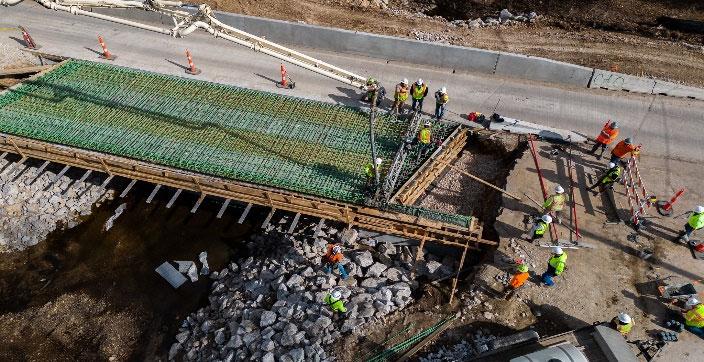
further in the project development stage of design. Through various means, the department will engage interested stakeholders including the appropriate council member. In instances where the project includes extensive property acquisition or impact to residences, businesses, and parkland, or involves new concepts that may alter travel patterns or mode choice, the department will engage the public for feedback. If funding is available through outside partners who have a mutual interest in a project (Missouri Department of Transportation, municipalities, Metro/Bi‐State, etc.), a project could be moved to a higher priority status.
For maintenance projects such as County Road System (CRS) concrete replacement or Arterial Road System (ARS) infrastructure projects, road ratings show which roads need to be included in the 5‐year plan. Road ratings will determine which roads are selected for inclusion in the Capital Program. It is more likely that roadways with a lower pavement condition rating will be considered for preservation treatments as appropriate and as funding allows.
Public Works Projects
County facility capital projects typically address safety issues, equipment or structural deterioration, equipment upgrades, or space requirements. Potential projects are identified by facility experts, department directors, or tenants. The department evaluates options to address the issue and estimates the project cost.
Projects are not prioritized using a formal scoring system – they are ranked based on the impact on safety and environmental quality for visitors and employees. This includes access to

facilities for all and attention to deteriorating structural elements. Deteriorated equipment and weatherproofing of facilities are the next focus as the failure of these items can cause valuable equipment, records, and workspace to be compromised. When multiple projects of similar priority are being compared and limited funding will not allow all projects to move forward, the department favors projects which affect the greatest number of people and protect the most valuable resources.
PROJECT FUNDING
Capital projects may be funded through annual appropriations, master lease financing, general obligation bonds, certificates of participation, special obligation bonds, or other financing tools. The decision to use a specific method is made depending upon the size, cost, and useful life of the project, coupled with available funding and debt capacity. Following is a description of available financing options:
Annual Appropriation
Projects may be financed through an appropriation within the operating budget of the user department.
Master Lease Program
A master lease program can fund capital projects with a useful life between three and ten years. The county contracts with a

vendor to provide project financing with annual principal and interest payments budgeted in the operating budget of the user department. The county does not have an active master lease program currently.
Certificates of Participation (COPs)
COPs are financing arrangements where an individual or entity purchases a share of the lease revenues of an agreement made by the county, rather than the bond being secured by those revenues. The county has no active COPs currently.
2024 CAPITAL IMPROVEMENT BUDGET
The 2024 capital improvement program budget includes $99.9 million in capital project funding. All projects are summarized on the following pages. Note that this includes $18.8 million in project financing provided by bond proceeds, grants, other third‐party sources. These moneys are held in funds not included in this presentation.
Special Obligation Bonds
Special obligation bonds are bonds where an investor’s sole security is the county’s promise to make annual principal and interest payments. All outstanding special obligation bonds are summarized in the debt management chapter of this document.
General Obligation Bonds
General obligation bonds are bonds backed by the taxing power of St. Louis County. All outstanding general obligation bonds are summarized in the debt management chapter of this document.

Operating Budget
The 2024 recommended operating budget includes $19.4 million in appropriations for capital improvement projects (this excludes projects funded by bond proceeds, grants, and other third‐party sources.)
Transportation Capital Budget
The 2024 recommended budget for the Transportation Capital Construction Program (CCP) is $61.8 million, a decrease of $1.4 million or 2.2% compared to the 2023 revised budget.
The table below provides a summary of the 2024 work plan and budget. The budget is in accordance with the Department of Transportation & Public Works’ 5‐year CCP. The 2024 CCP will support project activity of $70.0 million, including $8.2 million of construction work on 2023 and prior year awarded construction projects. The 2024 budget

will allow the department to commence and continue design, acquire right‐of‐ way, and let construction contracts for system maintenance, traffic safety, pedestrian and bicycle enhancements, and Americans with Disabilities Act (ADA) improvement projects.
The 2024 CCP supports the County Executive’s strategic priority of rebuilding infrastructure by including projects and programs to rehabilitate aging infrastructure while enhancing mobility and connectivity throughout the county. These projects and programs include arterial road maintenance, collector road maintenance, Complete Streets improvements related to sidewalks, trails, bicycling and transit, as well as ongoing efforts to improve ADA compliance within the county’s right‐of‐way.
Maximizing federal funding opportunities is forcing the department to delay maintenance activities on roads which are not eligible for federal funding such as subdivision streets. The department is also spending less on maintenance activity for minor streets and other projects which are not competitive for federal funding. For
2024, the department is unable to allocate funds for subdivision street repair work despite $50 million needed to rehabilitate subdivision pavement currently rated in poor condition.
The department is committed to maximizing the impact of every taxpayer dollar and will continue to work to obtain funding from alternative sources for all candidate projects to maximize the ability to provide a safe, flexible, efficient, and well‐maintained transportation system. This includes the utilization of federal funding programs such as the Surface Transportation Program (STP), Congestion Mitigation and Air Quality Program (CMAQ), Transportation Alternatives Program (TAP), and the Highway Bridge Program (HBP) whenever prudent. The department will continue to market the county’s needs to leverage alternative funding, however the opportunities to secure this funding are limited in proportion to the amount of local matching funds available.
Despite a transportation work plan of more than $235.3 million over the next 5 years, there are still hundreds of millions of dollars in needed
improvement and enhancements on the road network. The department currently estimates that $267 million (2023 estimate) is needed to complete the ADA transition plan, which is federally mandated; in addition, it has identified $273 million (2021 estimate) in pedestrian and bicycle enhancements which would benefit the region and is tens of millions of dollars short annually for basic system maintenance.
The department needs additional funding to maintain and enhance the road system. This will require a funding source to be identified and must be coupled with a substantial increase in
the department’s project development and construction staff to deliver an annual program appropriately sized while continuing to ensure that the county receives quality work and meets Missouri Department of Transportation requirements for projects utilizing federal funds. In the meantime, the department will have to use significant amounts of resources for on‐call contract services to execute their activity.
TRANSPORTATION CAPITAL CONSTRUCTION PROGRAM (CCP)
*Beginning in 2024, all Transportation Capital Construction Program activity will be consolidated in the Transportation Highway Fund. The Federal Aid Urban Fund will no longer be used. This consolidation will simplify administration of the program.
2024 Transportation Capital Program
2024 Fund 5080 Transportation Capital Program Appropriation Request
2024 Fund 5590 Transportation Capital Program Appropriation Request
2024 - 2028 Transportation Capital Program
2024 - 2028 Transportation Capital Program
CAPITAL IMPROVEMENTS BY FACILITY AND YEAR (2024‐2028)
not replaced could lead to structural damages that cost more
existing restrooms to MSD for more sanitary discarding of waste. Design 2020‐
feasibility of beach area improvements including white sand, concessions for chairs, umbrellas, snacks or even meals like the boathouse
Funded development connects to new Soccer Complex
Unknown cost for trail maintenance‐dependent on trail design and maintenance agreement with Great Rivers Greenway (1st year: $250K; 2nd year: $2,000K; 3rd year: $2,000K) Site control issues ‐ conceptual idea
Great Rivers Greenway funding development for new Greenway trail from Alabama Bridge to Pinnacle
connection through Lemay Park. Additional trail maintenance required for the County's portion of the trail‐County's portion unknown at this time. Construction completed to Broadway. Broadway to River City Casino on hold due to MSD work
Federal Grant. Parks pays upfront. Cost is reimbursed afterwards. Replace fitness equipment safety surface and shade structures
Although we have some redundancy w/two central plant chillers, if both were to be out of commission, we would want to be ready to connect a rented chiller and provide temporary AC to the Courts, Admin and PHQ bldgs.
a minimal cost. Increased operating cost offset by not renting porta‐potties. Design 2022.
existing domestic booster pumps to ensure adequate water pressure during summer months for Administration Building &
GRANTS
St. Louis County receives grants from state, federal, and other organizations to fund specific activities, such as policing, victim advocacy in the courts, nutrition programs, public health programs, and job training programs.
The amounts detailed on the following pages represent the most current estimates of grant funding to be received by County departments during 2023 and 2024. If awarded, most of these grants will be received and appropriated by ordinance and administered through funds that are not included in the annual budget process.
SUPPLEMENTAL INFORMATION
This section contains the following information:
• Property Tax Rates – Direct and Overlapping Governments
• St. Louis County Tax Rate History
• Vacancy Rate and Turnover Data
• Fund Dictionary
• Boards & Commissions
• Glossary & Acronyms
ST. LOUIS COUNTY, MISSOURI
PROPERTY TAX RATES - DIRECT AND OVERLAPPING GOVERNMENTS (rate per $100 of assessed value)
Overlapping Average Tax Rates
Notes:
- Service Districts include fire, light, and sewer.
- Other includes Special School District, Community College, Zoo Museum District, Sheltered Workshop, Library Districts and State of Missouri.
ST. LOUIS COUNTY, MISSOURI PROPERTY TAX RATES*
Tax rates per $100 of assessed valuation
*Reflects the rate for residential real estate from 2015-forward. Different rates have been levied for each class of property since this time.
**Recommended rates
Data reflects the percentage of all permanent full- and part-time positions vacant

Data reflects the percentage of all permanent full- and part-time employees that separated from St. Louis County employment by year

FUND DICTIONARY
The county’s financial structure is organized based on funds, each of which is considered a separate accounting entity with self-balancing accounts that comprise its assets, liabilities, fund balances/net assets, revenues and expenditures, or expenses. Governmental resources are allocated to and accounted for in individual funds based upon the purposes for which they are to be spent and how spending activities are controlled.
The funds included in this budget document are listed below. Fund
General Funds 1010 General Revenue Account for general governmental and administrative expenses, Police, Justice Services, Judicial Administration, and Human Services.
General Funds 1020 Special Road & Bridge Account for repairs and maintenance of county roads performed by the Department of Transportation
General Funds 1030 Health Account for health inspections, pollution monitoring, clinical, and other services delivered by the Department of Public Health.
General Funds 1050 Park Maintenance Account for the maintenance and operation of all public recreational facilities of the county administered by the Department of Parks & Recreation.
General Funds 1060 NFL Settlement Account for general governmental and administrative expenses funded by the NFL settlement.
Special Revenue Funds
Special Revenue Funds
Special Revenue Funds
5300 St. Louis County & Municipal Police Academy
5570 Assessment
Record revenues and expenditures of the Police Academy for specialized police training for county and municipal participants
Record the revenues and expenditures of the County Assessor as required under Section 137.750 RSMo.
5580 Sewer Lateral Account for revenue from sewer lateral fees imposed on all residential property located within unincorporated St. Louis County having six or less dwelling units to fund repairs of defective lateral sewer service lines
Special Revenue Funds
5670 Lambert East Perimeter TIF
Receives payments in lieu of taxes (PILOTs) and economic activity taxes (EATS) associated with the Lambert Airport Eastern Perimeter Redevelopment Project. Funds are used to pay debt service costs associated with taxable annual appropriationsupported tax increment revenue bonds (Series 2011A) and special obligation refunding bonds (Series 2021D/E).
Special Revenue Funds
5710 Record Preservation
Records storage, microfilming, and preservation funded from a portion of fees collected by the Recorder of Deeds on all recorded instruments.
Special Revenue Funds
Special Revenue Funds
Special Revenue Funds
Special Revenue Funds
5740 Police Air Support Program
Purpose
Record receipts and disbursements for the St. Louis County Police Air Support Program which provides aerial law enforcement support for the entire St. Louis region. St. Louis City and St. Charles County also participate in the program.
5800 Emergency Communications
5830 County Sheriff Revolving
5840 Northpointe Forest Subdivision NID
Record receipts from the one-tenth cent sales tax for emergency communications initiatives and the 1% emergency telephone tax along with related disbursements, including debt service.
Record revenues and expenses of the Police Department’s concealed carry permit activity.
Record revenues from a special assessment to property owners of the Northpointe Forest Subdivision and associated debt service costs of the Northpointe Forest Water Project (Series 2009 A/B). The project consists of a water main extension to serve the residents of the subdivision.
Special Revenue Funds
5860 Residential Energy Efficiency Loan Program
Record revenue from the repayment of loans from the St. Louis County SAVES™ (Sustainable and Verifiable Energy Savings) Program, and pay costs related to taxable special obligation bonds issued in 2011 to finance the program (Series 2011 A/B).
Special Revenue Funds
Special Revenue Funds
5900 Children’s Service
5910 Glencullen Subdivision NID
Record receipts from the quarter-cent sales tax for children’s services. Funds are used for programs to protect the well-being and safety of children and youth 19 years of age and less.
Record revenues from a special assessment to property owners in the Glencullen Subdivision and associated debt service costs of the Glencullen Subdivision Street Improvements Project. The project consists of the reconstruction and replacement of private streets, sidewalks, drive approaches and related street improvements within the District.
Special Revenue Funds
6770 Opioid Remediation
Record revenues from litigation with opioid distributors. Funds may be used as allowed under the settlement terms of the lawsuits, including support for treatment of opioid use disorder and any co-occurring substance use disorder or mental health conditions through evidence-based or evidence-informed programs or strategies.
Special Revenue Funds
8630 Convention & Recreation Trust
Record a 3.5% sales tax on the sales and charges for hotel and motel rooms within St. Louis County. Deposited funds are disbursed subject to annual appropriations to the St. Louis Regional Convention and Sports Complex Authority to pay the county share of
Special Revenue Funds
Special Revenue Funds
8640 Water Service Line
8650 Solid Waste Management
Purpose
the development of a multi-purpose convention, exhibition, and sports facility, as well as debt service on taxable St. Louis Cardinals Ballpark Project Refunding Bonds (Series 2021) and Soccer Complex bonds (Series 2016 A/B).
Record water service line fees imposed on all residential property located within unincorporated St. Louis County having six or less dwelling units, to fund repairs of defective water service lines.
Record annual license fees and surcharges on waste deposited at sanitary and demolition landfills. Funds are used to finance recycling and solid waste programs administered by the Department of Public Health.
Debt Service Funds 1110 Debt Service Account for property tax received to pay required debt service costs on general obligation bonds (Court building project)
Enterprise Funds 1100 Spirit of St. Louis Airport Account for activity at Spirit Airport, which serves as the prime reliever airport for the St. Louis metropolitan area.
Miscellaneous Funds 5600 Transportation Trust
Record sales tax revenue and expenditures for transportation purposes
Miscellaneous Funds 5620 Public Mass Transit Account for revenue from the quarter-cent and halfcent mass transit sales taxes, and expenditures for public transportation purposes (typically operations and capital development costs of Bi-State Development/Metro)
Highway Capital Funds 5080 Federal Aid Urban Trust
Account for the financial management of construction, reconstruction, and repair of roadways. The primary source of funding is the County Aid Road Tax (CART) which is distributed by the State of Missouri via formula.
Highway Capital Funds 5590 Transportation Highway Account for the financial management of construction, reconstruction, and repair of roadways. The source of funding is the half-cent transportation sales tax
BOARDS & COMMISSIONS
St. Louis County interacts with numerous boards and commissions in the fulfillment of its duties as listed below. More information on each board can be found on the county’s web site at: boards.stlouisco.com.
Aging Ahead
Air Pollution Appeal Board
Animal Care & Control Advisory Board
Bi-State Development Agency (Metro)
Board of Electrical Examiners
Board of Equalization
Board of Examiners for Mechanical Licensing
Board of Freeholders
Board of Plumbing Examiners
Board of Police Commissioners
Board of Zoning Adjustment
Boundary Commission
Building Code Review Committee
Building Commission and Board of Building Appeals
Business Advisory Council
Civil Service Commission
Commission On Disabilities
Community Improvement District's (CID)
East-West Gateway Council of Governments
Board of Directors
Electrical Code Review Committee
Emergency Communications Commission
Fire Standards Commission
Fund Investment Advisory Committee
Health and Hospital Advisory Board (County Health Advisory Board)
Historic Building Commission
Housing Resources Commission
Human Relations Commission
Industrial Development Authority Board
Justice Services Advisory Board
Land Clearance for Redevelopment Authority
Local Emergency Planning Committee
Mechanical Code Review Committee
Metropolitan Park and Recreation District Board Of Directors (Great Rivers Greenway)
Metropolitan St. Louis Sewer District (MSD)
Metropolitan Taxicab Commission
Metropolitan Zoological Park and Museum District Board
Parks And Recreation Advisory Board
Planning Commission
Plumbing Code Review Committee
Port Authority Board of Commissioners
Productive Living Board
Regional Arts Commission
Regional Convention & Sports Complex Authority
Regional Convention & Visitors Commission
Regional Justice Information Service Commission (REJIS)
Restaurant Commission
Retirement Board of Trustees
St. Louis Airport Commission
St. Louis County Children's Service Fund Board
St. Louis County Clean Energy Development Board (PACE)
St. Louis County Clinical Consumer Majority Board
St. Louis County Council Bipartisan Reapportionment Commission
St. Louis County Housing Authority Commission
St. Louis County Library Board
St. Louis County Municipal Court Judges
St. Louis County Older Adult Commission
St. Louis County Public Transportation Commission
St. Louis County Workforce Development Board
St. Louis County Youth Advisory Council
St. Louis Economic Development Partnership
St. Louis Regional Health Commission
St. Louis-Jefferson Solid Waste Management District
Tax Increment Financing Commission of St. Louis County
Waste Management Commission
World Trade Center - St. Louis
Zoo-Museum District - Art Museum Subdistrict Board of Commissioners
Zoo-Museum District - Botanical Garden Subdistrict Board of Commissioners
Zoo-Museum District - Missouri History Museum Subdistrict Board of Commissioners
Zoo-Museum District - St. Louis Science Center Subdistrict Board of Commissioners
GLOSSARY & ACRONYMS
Glossary
Account Number - A numerical code identifying revenues and expenditures by fund, department, activity, type, and object.
Accrual - Accrual accounting/budgeting refers to a method of accounting/budgeting in which revenues are recorded when earned and expenditures are recorded when goods are received or services are performed, even though the actual receipts and disbursements of cash may occur, in whole or in part, in a different fiscal period.
Adopted Budget - Also known as “Final Budget”, refers to appropriations as originally approved by the County Council at the beginning of the year and to the budget document which consolidates all beginning-ofthe-year operating appropriations.
Ad Valorem Tax - Commonly referred to as property taxes, these taxes are levied on both real and personal property according to the property’s assessed valuation and the tax rate.
Annual Budget - A budget applicable to a single fiscal year.
Annual Comprehensive Financial Report - An official annual report which presents the status of the county’s finances in a standardized report. The ACFR is organized by fund and contains two basic types of information: (1) a balance sheet that compares assets with liabilities and fund balance, and (2) an operating statement that compares revenues and expenditures.
Appropriation - A specific amount of money authorized by the County Council to a specified unit of county government to make expenditures and to incur encumbrances for
specific purposes. Appropriations expire at the end of the fiscal year.
Assessed Value - A value set on real estate or other property as a basis for levying taxes. The assessed value is set by the County Assessor, who is charged with determining the taxable value of property according to a formula set by the State of Missouri.
Assessment – (1) the process of making the official valuation of property for purposes of taxation. (2) The valuation placed upon property because of this process.
Balanced Budget - A balanced budget is one in which the available revenues and appropriated fund balances equal estimated expenditures for a fiscal year.
Bond - A contract to pay a specified sum on money (the principal or face value) at a specified future date (maturity) plus interest paid at an agreed percentage of the principal.
Budget - A financial plan, including proposed expenditures and estimated revenues, for a given period.
Budget Calendar - A schedule of key dates which the county follows in the preparation, adoption, and administration of the budget.
Budget Document - The instrument used by the County Executive to present a comprehensive financial program to the County Council.
Budget Message - The opening section of the budget which provides County Council and the public with a summary of the most important aspects of the budget, changes from previous fiscal years, and recommendations regarding the county’s financial policy for the upcoming fiscal year.
Budgetary Control - The control or management of a government or enterprise in accordance with an approved budget that keeps expenditures within the limitations of available appropriations and revenues.
Capital Asset - An expenditure for an item with a value of $500 or more and that has an expected life of more than one (1) year. Capital items include real property, office equipment, furnishings, and vehicles.
Capital Expenditure - A direct expenditure that results in or contributes to the acquisition or construction of a capital asset. The expenditure may be for new construction, addition, replacement, or renovations to buildings that increase their value, or major alteration of a capital asset. Capital assets include land, infrastructure, buildings, equipment, vehicles, and other tangible and intangible assets that have useful lives longer than one year.
Capital Improvement Program (CIP) - A plan for capital expenditures to be incurred each year over a fixed period of years to meet capital needs arising from the long-term work program or other capital needs. The CIP sets forth each project or other contemplated expenditures in which the government is to have a part and specifies the resources estimated to be available to finance the projected expenditures.
Certificate of Participation (COP) - a security created as part of a lease-purchase agreement. The lender, the holder of the certificate, owns a right to participate in periodic lease payments (interest and return of principal) as they are paid.
Chart of Accounts - A listing and description of all county revenue and expenditure accounts.
Debt Service Fund - A fund used to account for accumulation of resources for, and the payment of, general long-term debt principal and interest payments on a bond issue.
Deficit – An excess of expenditures over revenues or expenses over income.
Department - The primary organizational unit in St. Louis County. Each department is managed by a director. Departments are generally composed of divisions and programs which share a common purpose, or which perform similar duties.
Distinguished Budget Presentation Program - A voluntary program administered by the Government Finance Officers Association to encourage governments to publish efficiently organized and easily readable budget documents.
Encumbrance - An obligation incurred in the form of purchase orders, contracts, and similar items that will become payable when the goods are delivered, or the services rendered. An encumbrance is an obligation of funding for an anticipated expenditure prior to actual payment for an item.
Enterprise Fund - Funds to account for operations that are financed and operated in a manner like private business enterprises. An enterprise fund is a self-supporting fund designed to account for activities supported by user charges. The Spirit of St. Louis Airport Fund is an enterprise fund.
Enterprise Resource Planning (ERP) System - A suite of computer applications designed to organize and administer processes in a systematic way across many areas of an organization to improve business processes and ultimately improve the information and services delivered to customers. The county’s ERP system, currently under design work, is known as the County Administrative Processing System (CAPS).
Expenditure - The disbursement of appropriated funds to purchase goods and/or services.
Fair Labor Standards Act (FLSA) - Federal legislation regulating minimum wage, overtime, record keeping, child labor standards and prohibiting sexual discrimination in pay. 1985 amendments applied FLSA to state and local governments.
Fees – see “User Fee”
Final Budget – see “Adopted Budget”
Fiscal Year - In St. Louis County, the twelve months beginning on January 1 and ending the following December 31. (The State of Missouri’s fiscal year begins on July 1. The federal government’s fiscal year begins October 1).
Fringe Benefits - Fringe benefits include St. Louis County’s contribution to Social Security, Retirement Plan, Unemployment Compensation, Workmen’s Compensation, Hospital Insurance, Long Term Disability and Life Insurance.
Full-Time Equivalent (FTE) - A part-time position converted to the decimal equivalent of a full-time position based upon 2,080 hours worked per year (40 hours per week). For example, a part-time employee working 20 hours per week (1,040 hours per year) is the equivalent of 0.5 of a full-time employee, or 0.5 FTE. A full-time employee working 2,080 hours per year is 1.0 FTE.
Fund - An accounting device established to control the receipt and disbursement of income from sources set aside to support specific activities or attain certain objectives.
Fund Balance - Fund balance represents the amount of money remaining in a fund after all expenses and liabilities have been accounted for. This balance is available for use in future years.
General Revenues - All revenues are general revenues unless they are required to be reported as program revenues. All taxes, even those that are levied for a specific purpose are general revenues. All other non-tax revenues (including interest, grants, and contributions) that do not meet the criteria to be reported as program revenues should be reported as general revenues.
Generally Accepted Accounting Principles (GAAP) - Uniform minimum standards and guidelines for financial accounting and reporting. They govern the form and content of the financial statements of an entity. GAAP encompasses the practice at a particular time; they include not only broad guidelines of general application, but also detailed practices and procedures. GAAP provides a standard by which to measure financial presentations. The primary authoritative body on the application of GAAP to state and local governments is the GASB.
General Obligation Bond - Bonds for which the full faith and credit of the county are pledged.
General Revenue Fund - A fund created to account for all financial resources for the general operating revenue and expenditures of the county.
Governmental Accounting Standards Board (GASB) - A private, non-governmental organization which is currently the source of generally accepted accounting principles (GAAP) used by state and local governments in the United States. It is a private, nongovernmental organization. The GASB has issued Statements, Interpretations, Technical Bulletins, and Concept Statements defining GAAP for state and local governments since 1984.
Governmental Fund – Funds through which most governmental functions are financed. The acquisition, uses, and balances of the county’s expendable financial resources and the related liabilities (except for those accounted for in proprietary funds) are accounted for through governmental funds. The measurement focus is on determination of and changes in financial position rather than upon net income.
Grant - A contribution of assets (usually cash) by one governmental unit or other organization to another. Typically, these contributions are made to local governments from the state and federal governments. Grants are usually made for specific purposes.
Intergovernmental Revenues - Revenue collected primarily from state or federal governments as grants, shared revenue, payments in lieu of taxes, or reimbursement for government services.
Levy - The total amount of taxes, special assessments or service charges imposed by a government.
Master Lease - a program of financing which allows the county to pay for the costs of major capital assets over the life of the asset, rather than all in one year, supplementing the county’s needs to complete a variety of major projects.
Modified Accrual Basis of Accounting – An accounting method that combines accrual-basis accounting with cash-basis accounting. Modified accrual accounting recognizes revenues when they become available and measurable and, with a few exceptions, recognizes expenditures when liabilities are incurred. This system divides available funds into separate entities within the organization to ensure that the money is being spent where it was intended.
Municipal - In its broadest sense, an adjective denoting the state and all subordinate units of government. In a more restricted sense, an adjective denoting a city or village as opposed to other local governments.
Operating Budget - Plans for current expenditures and the proposed means of financing them. The annual operating budget is the primary means by which most of the financing, acquisition, spending and service delivery activities of a government are controlled.
Ordinance - A formal legislative enactment by the County Council.
Personal Property - Property, other than real estate identified for purposes of taxation, including personally owned items, as well as corporate and business equipment or property. Examples include automobiles, motorcycles, boats, and trailers.
Position - A group of duties and responsibilities, as prescribed by an office or department, to be performed by a person on a full-time or parttime basis.
Program – An organized set of activities directed toward a common purpose or goal undertaken or proposed by a department to carry out its mission.
Program Revenues - Revenues derived directly from a program itself. Program revenues reduce the net cost of functions to be financed from governments’ general revenues. Program revenues are further divided between charges for services and program-specific grants and contributions (operating and capital).
Property Tax - A tax levied on the assessed value of real and personal property. This tax is also known as an ad valorem tax.
Proprietary Funds – funds used to account for activities that are like those found in the private sector. The measurement focus is on the determination of net income, changes in net assets (or cost recovery), financial position, and cash flows.
Recommended Budget - A plan of financial operations submitted by the County Executive to the County Council. This plan reflects estimated revenues, expenditures, transfers, and department goals and objectives.
Real Property - Real estate, including land and improvements (buildings, fences, pavements, etc.) classified for purposes of assessment.
Reserve – a budget and policy term that describes the fungible resources available outside of the budget for use if the resources appropriated inside of the budget are insufficient.
Resolution - An informal statement of policy by the County Council.
Revenue - Monies received from all sources (except for fund balances) that will be used to fund expenditures in a fiscal year.
Sales Tax - Tax imposed on the taxable sales of all final goods.
Sewer Lateral Program - Approved by a general election on April 6, 1999. The taxpayers/voters agreed to pay $28.00 per property per year to fund a program to defray the cost of repairs to their privately owned sewer laterals.
Special Revenue Funds - Funds used to account for the proceeds of specific revenue sources (other than expendable trusts or major capital projects) that are legally restricted to expenditure for specific purposes. GAAP only requires the use of special revenue funds when legally mandated.
Supplemental Appropriation Ordinance – An ordinance appropriating funds in addition to those in the adopted budget. Supplemental appropriations provide additional budget authority beyond the original estimates for programs or activities (including new programs authorized after the date of the adopted budget) in cases where the need for funds is too urgent to be postponed until enactment of the next regular budget ordinance.
Taxes - Compulsory charges levied by a government to finance services performed for the common benefit.
Tax Increment Financing (TIF) - A tool used to increase real property values through the physical improvement of a specific redevelopment area as authorized by Missouri Statute (RSMo. 99,800 – 99,865).
Transfer - Movement of monies from one fund, activity, department, or account to another. This includes budgetary funds and/or movement of assets.
Trust Fund - Funds used to account for assets held by a government in a trustee capacity for individuals, private organizations, other governments and/or other funds.
Unappropriated Fund Balance – Monies not appropriated or committed to a specific program or purpose.
User Fees - Charge for expenses incurred when services are provided to an individual or groups and not the community at large. Major types of user fees include business and non-business licenses and fees.
Acronyms
(underlined acronyms are defined in the glossary)
AARP – organization formerly known as the American Association of Retired Persons
AASHTO – American Association of State Highway and Transportation Officials
ACSP – Alternative Services Program (Department of Justice Services)
ADA – Americans with Disabilities Act
APB – Accounting Principles Board
ARBs – Accounting Research Bulletins
ARPA – American Rescue Plan Act of 2021
ARRA – American Recovery and Reinvestment Act
ARS – Arterial Road System
AV – Assessed Value
BAC – Business Assistance Center
BJA – Bureau of Justice Assistance
BOE – Board of Equalization
BOEC – Board of Elections Commissioners
CAFR – Comprehensive Annual Financial Report
CAPS – County Administrative Processing System
CARES – Coronavirus Aid, Relief, and Economic Security
CARF – Commission on Accreditation of Rehabilitation Facilities
CART – County Aid Road Tax
CASA – Court Appointed Special Advocates
CIP – Capital Improvement Program
CCP – (Transportation) Capital Construction Program
CDBG – Community Development Block Grant
CDC – Centers for Disease Control
CEO – Chief Executive Officer
CID - Community Improvement District
CMAQ – Congestion Mitigation and Air Quality Program
COD – Coefficient of Dispersion
COO – Chief Operating Officer
COP – Certificate of Participation
COVID-19 – Coronavirus Disease 2019
CPA – Certified Public Accountant
CRF – Coronavirus Relief Fund
CRS – County Road System
CSF – Children’s Service Fund
CYP – County Youth Program
DEIS – Draft Environmental Impact Statement
DHS – Department of Human Services
DJS – Department of Justice Services
DNA – Deoxyribonucleic Acid
DOL – Department of Labor or Determination of Liability
DVSS – Domestic Violence Shelters and Services
DWI – Driving While Intoxicated
EATS – Economic Activity Taxes
ECC – Emergency Communications Commission
EHD – Electronic Home Detention
EIR – Entrepreneur in Residence
EIS – Environmental Impact Statement
EOC – Emergency Operations Center
ERP – Enterprise Resource Planning System
ESInet – Emergency Services IP Network
FAA – Federal Aviation Administration
FASB – Financial Accounting Standards Board
FTE – Full-Time Equivalent
FY – Fiscal Year
GAAP – Generally Accepted Accounting Principles
GASB – Governmental Accounting Standards Board
GED – General Education Development
GFOA – Government Finance Officers Association
GIS – Geographic Information System
GO – General Obligation
GRG – Great Rivers Greenway
HBP – Highway Bridge Program
HOME – Home Investment Partnership Program
HUD – U.S. Department of Housing and Urban Development
HVAC – Heating, Ventilation, and Air Conditioning system
IAAO – International Association of Assessing Officers
ILS – Instrument Landing System
IP – Internet Protocol
IRS-MACRS – Internal Revenue ServiceModified Accelerated Cost Recovery System
ISO – Insurance Services Office
IT – Information Technology
ITS – Intelligent Transportation System
JAG – Justice Assistance Grant
JDAI – Juvenile Detention Alternatives Initiative
LED – Light Emitting Diode
M&M – Merchants and Manufacturers
MCSAP – Motor Carrier Safety Assistance Program
MCVR – Missouri Centralized Voter Registration
MDHSS – Missouri Department of Health and Senior Services
MDPS – Missouri Department of Public Safety
MET (Center) – Metropolitan Education and Training
MoDOT – Missouri Department of Transportation
MOVANS – Missouri Victim Automated Notification System
MPLS – Multiprotocol Label Switching (networks)
MSD – Metropolitan St. Louis Sewer District
MWBE – Minority/Women-owned Business Enterprises
NFL – National Football League
NID – Neighborhood Improvement District
NSP – Neighborhood Stabilization Program
OSCA – Office of State Court Administrator
PILOTS – Payments in Lieu of Taxes
PMB – Division of Performance Management & Budget
PSAP – Public Safety Answering Point
PY – Program Year
REJIS – Regional Justice Information System
RFP – Request for Proposals
RIS – Revenue Information Services (Department of Revenue – formerly Land Information Services)
RSAT – Residential Substance Abuse Treatment
RSMo – Revised Statutes of Missouri
SAVES – Sustainable and Verifiable Energy Savings
SBA – Small Business Administration
SCRAM – Secure Continuous Remote Alcohol Monitoring
SLCRO – St. Louis County Revised Ordinances
SLEDP – St. Louis Economic Development Partnership
SLFRF – (Coronavirus) State and Local Fiscal Recovery Funds
STC – State Tax Commission
STP – Surface Transportation Program
TAN – Tax Anticipation Notes
TANF – Temporary Assistance for Needy Families
TAP – Transportation Alternatives Program
TCM – Tyler Content Manager
TIF – Tax Increment Financing
TIP – Transportation Improvement Plan
TGA – Traffic Generation Assessment
TOB – Traffic Operations Building
TTY – Text Telephone
UMSL – University of Missouri St. Louis
VAWA – Violence Against Women Act
VOCA – Victims of Crime Act
WOIA – Workforce Investment Opportunity Act




